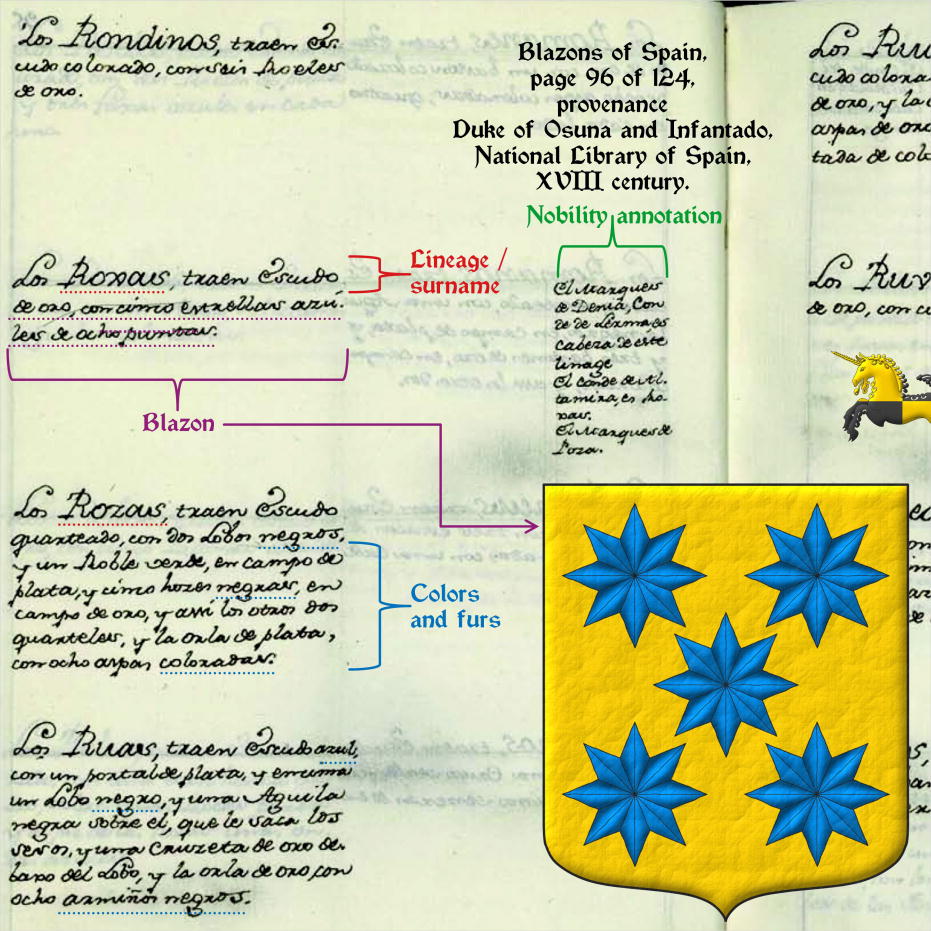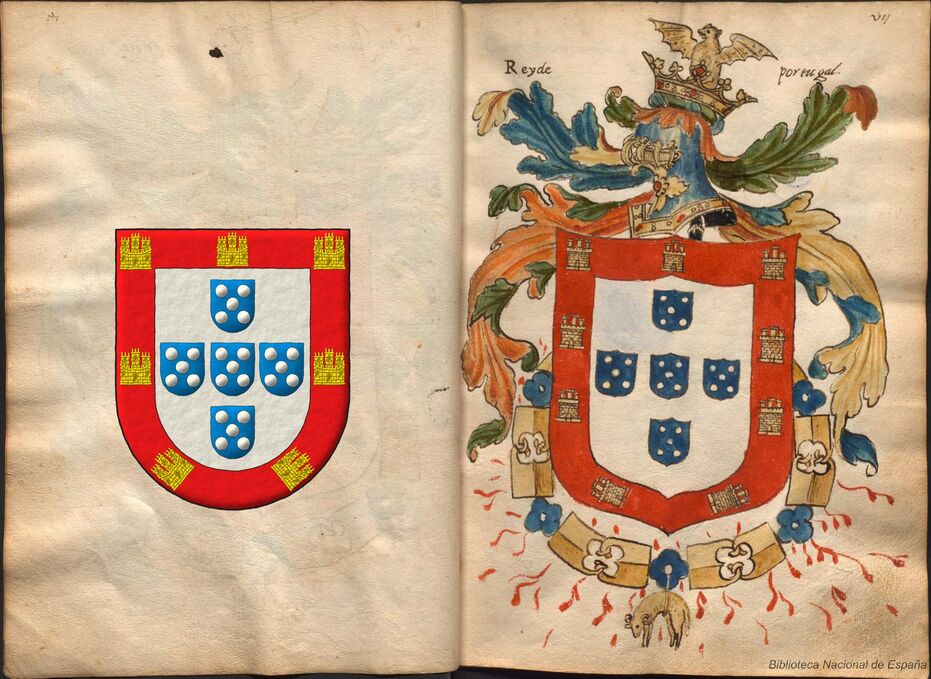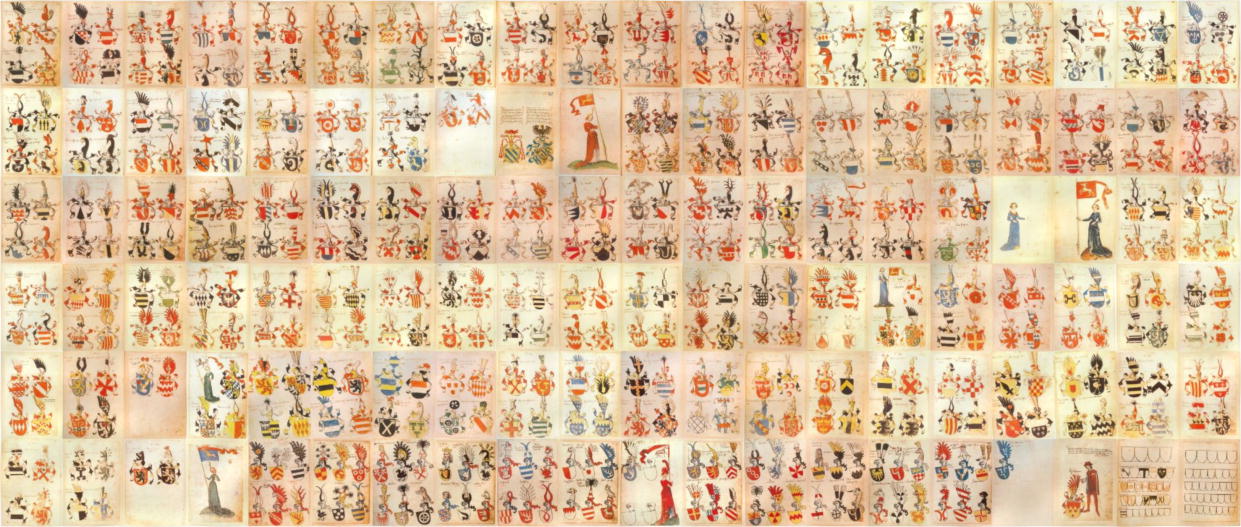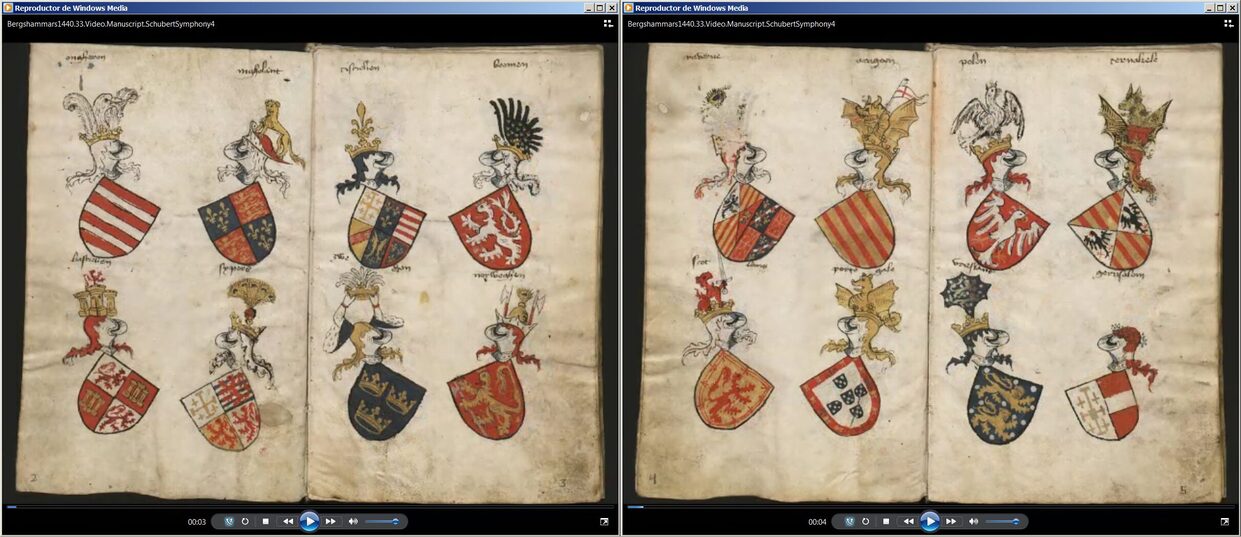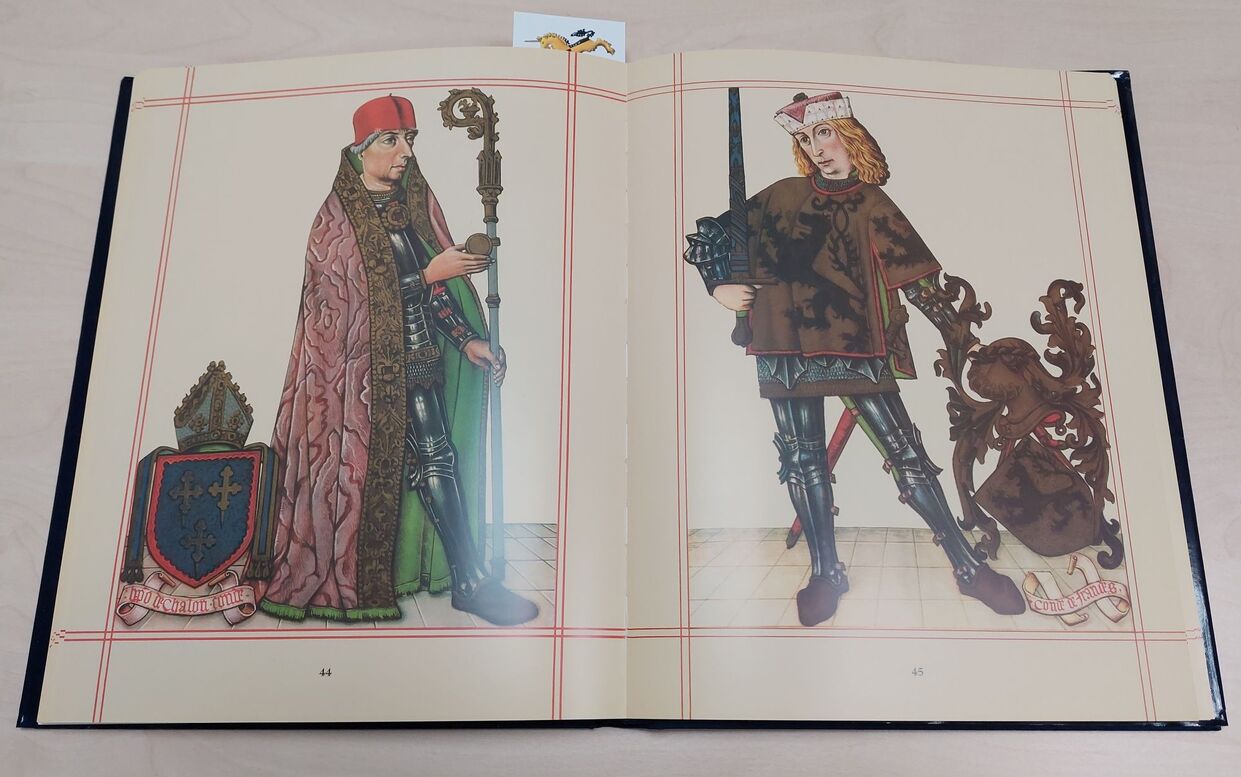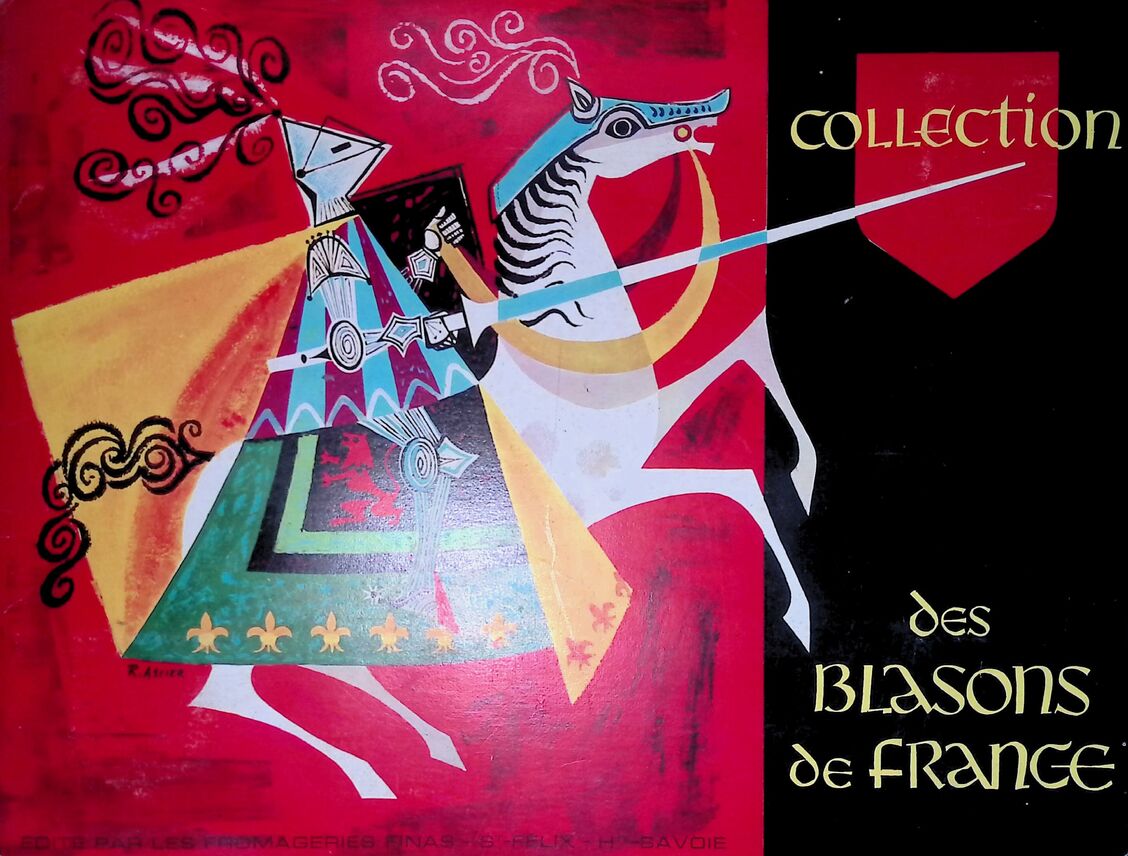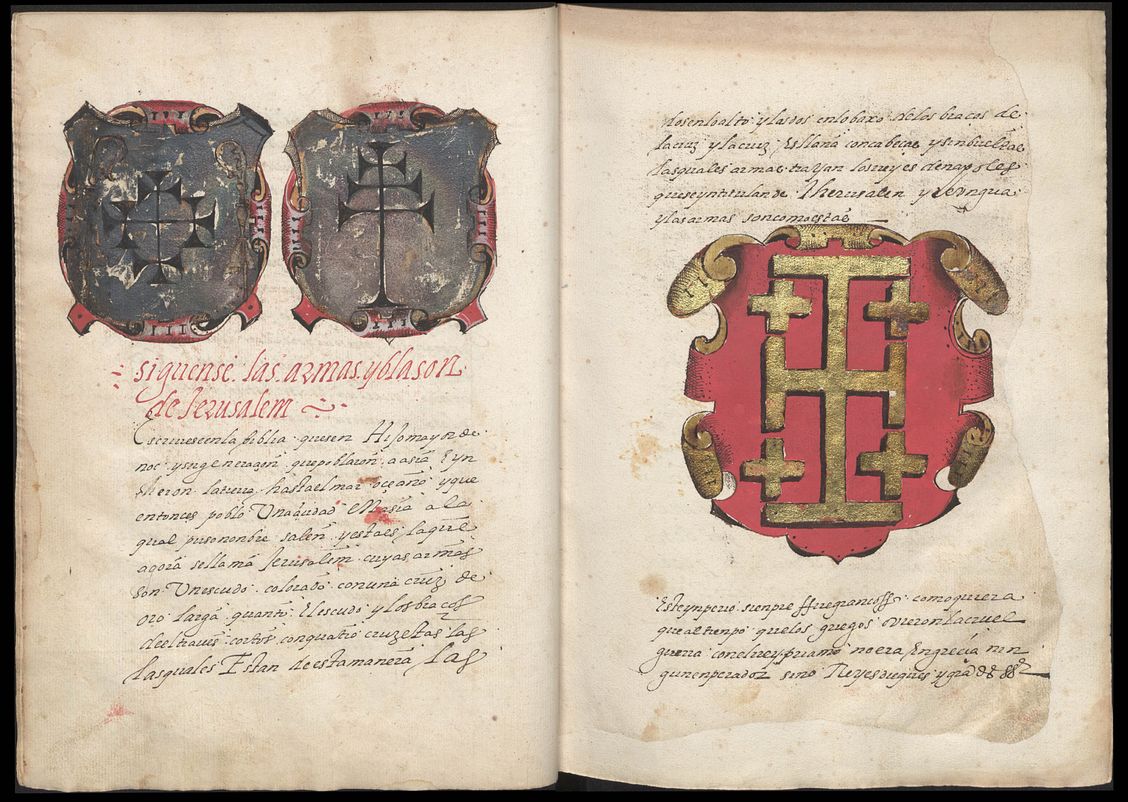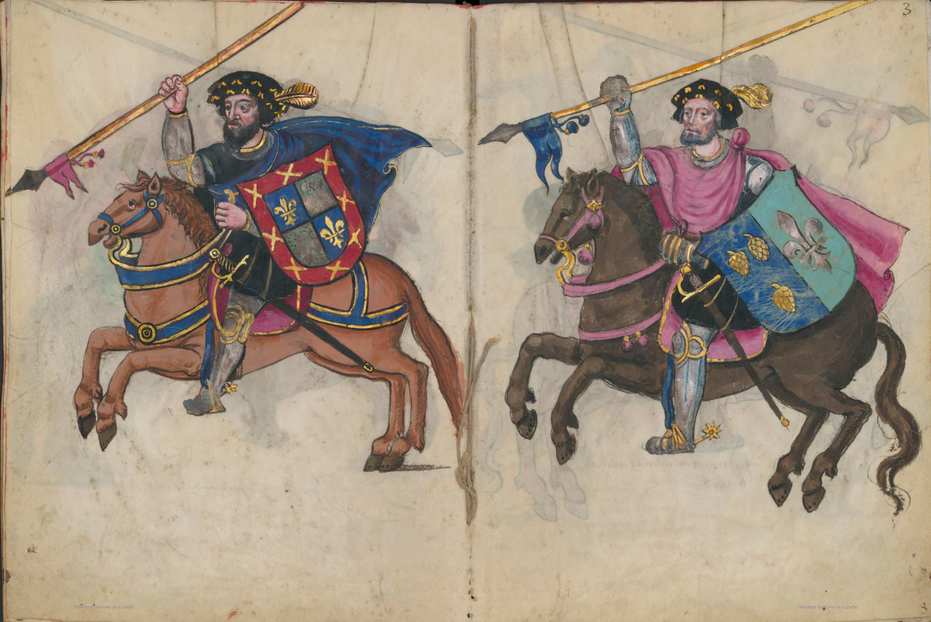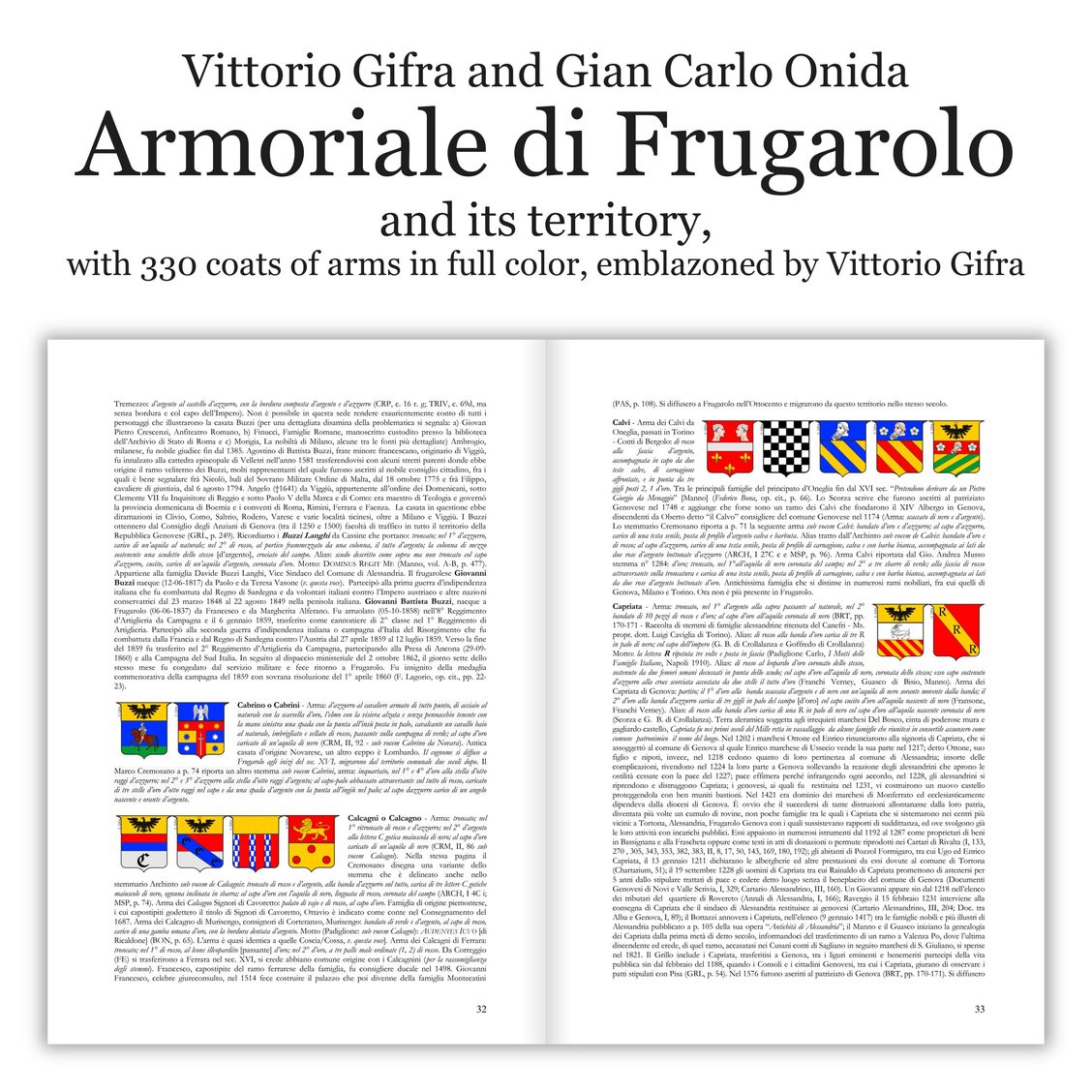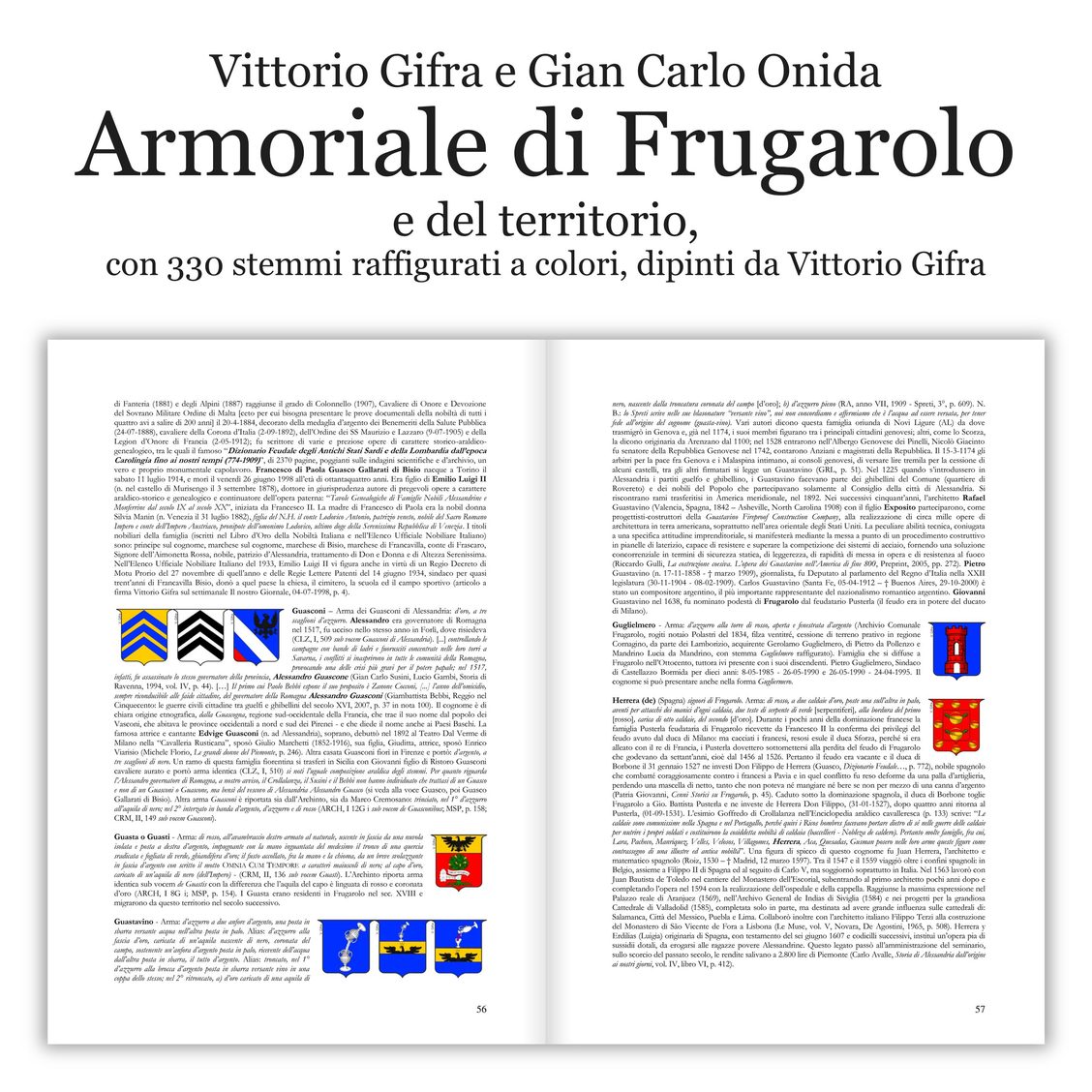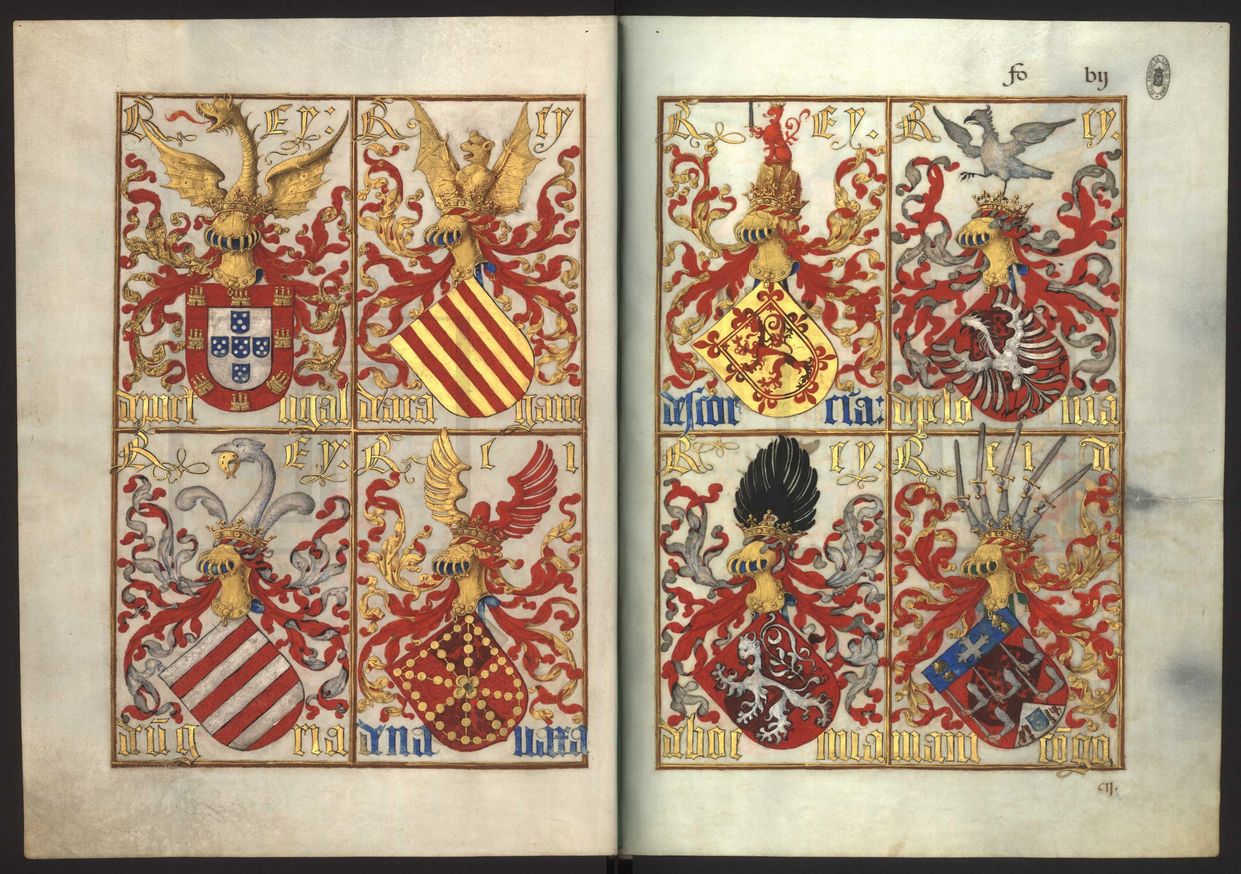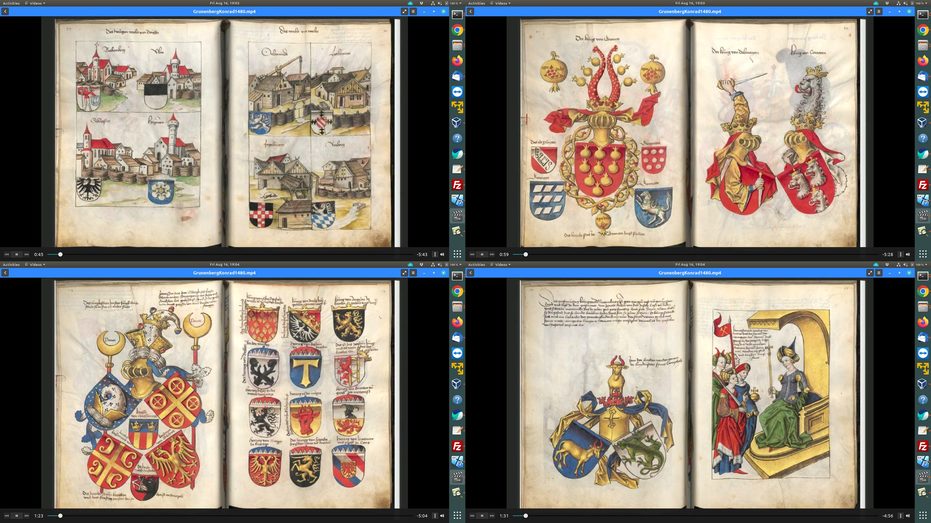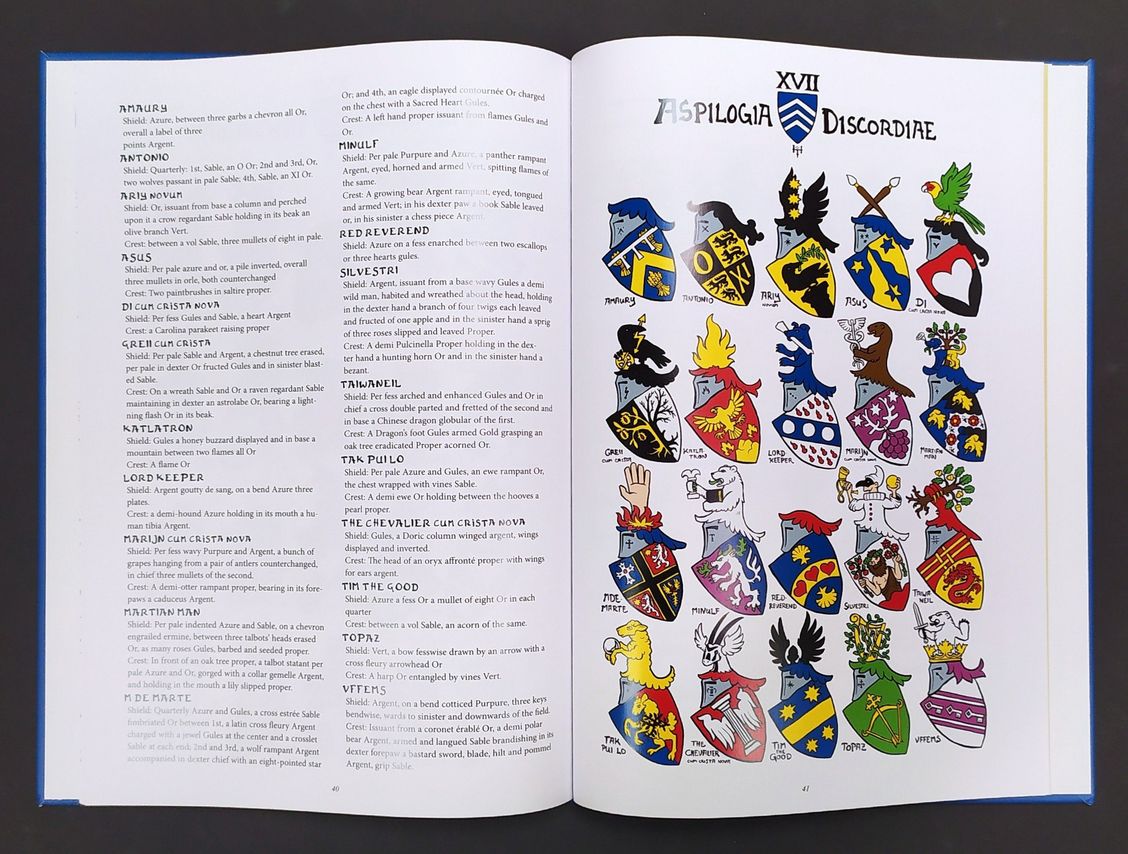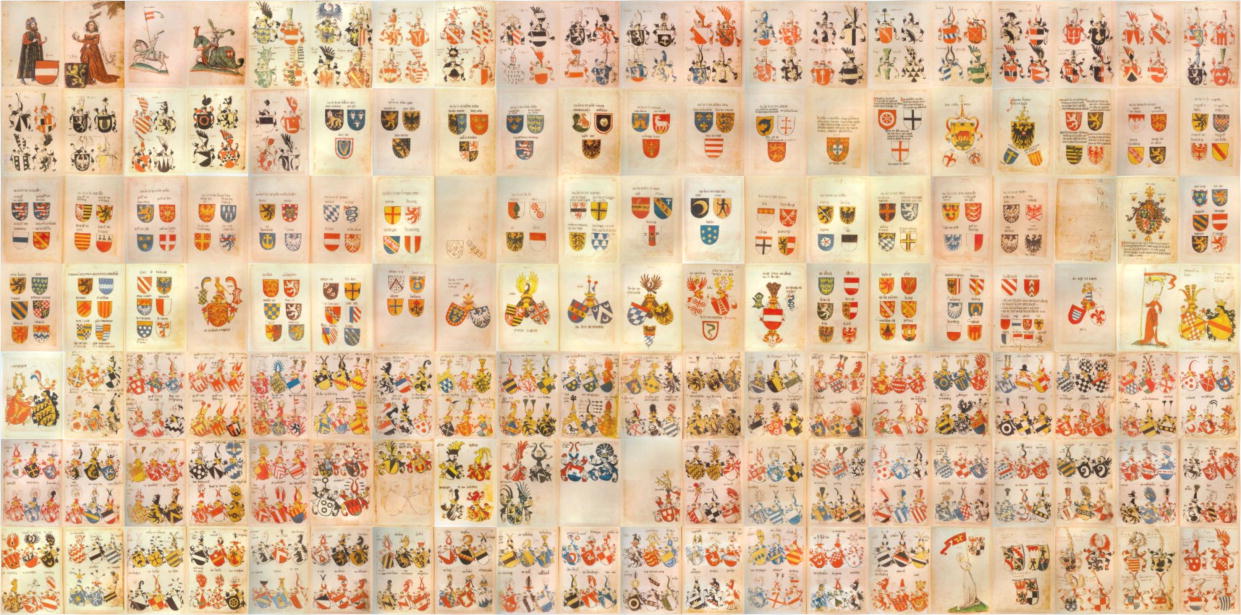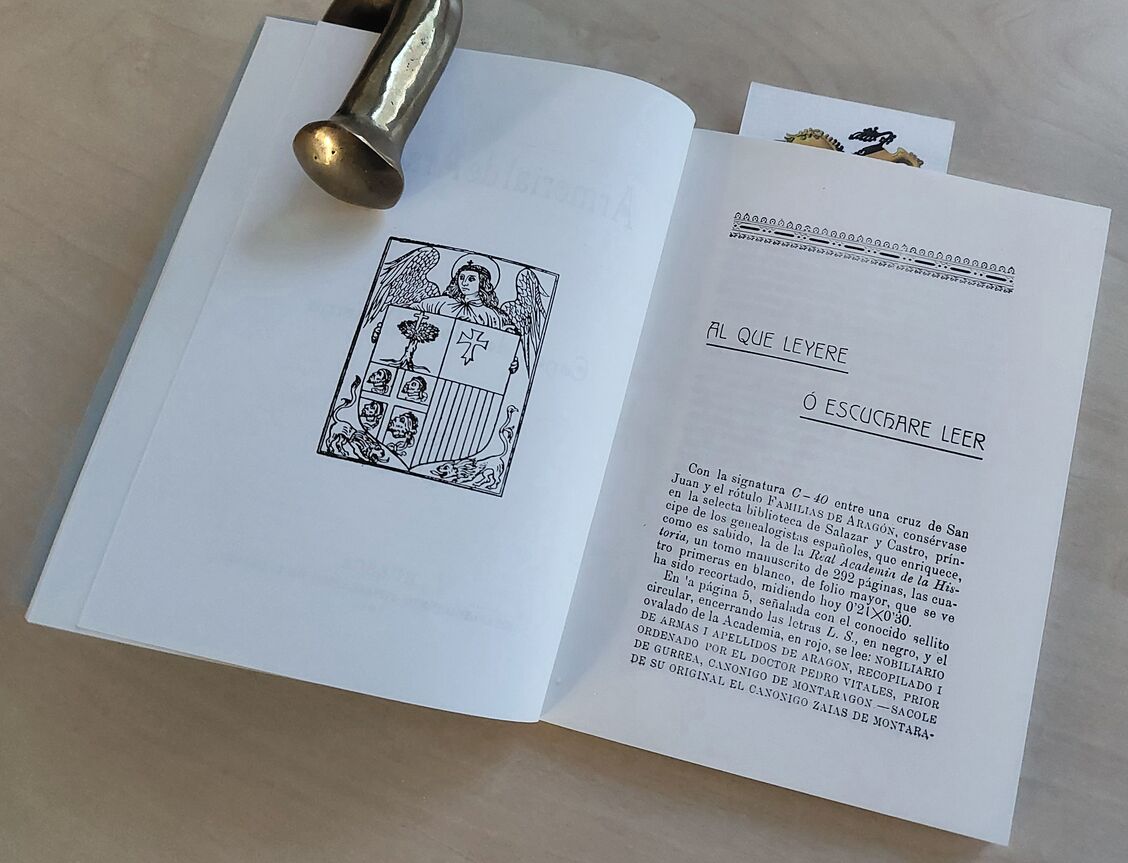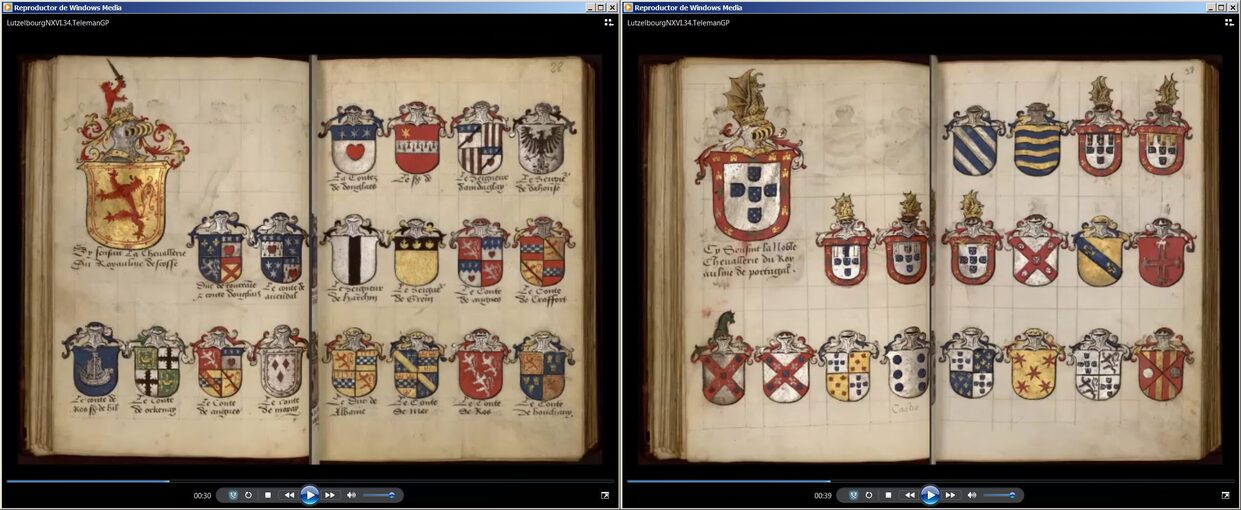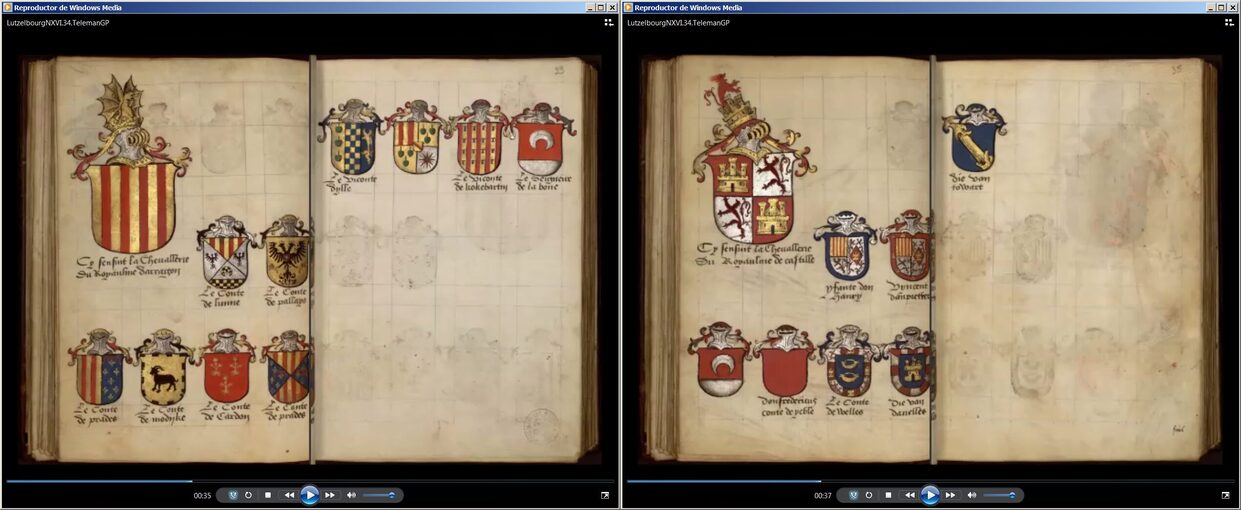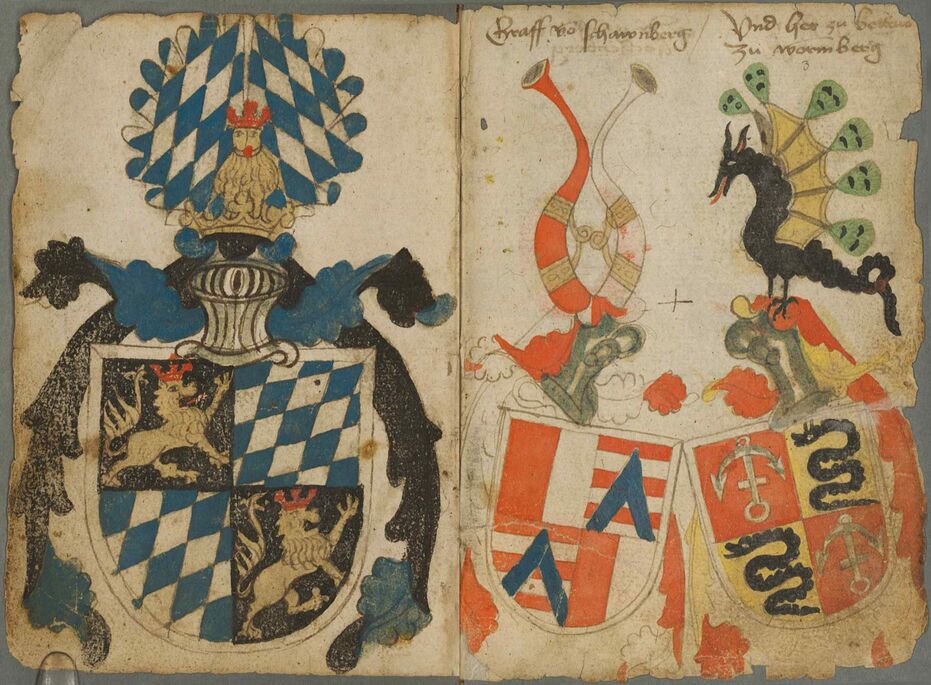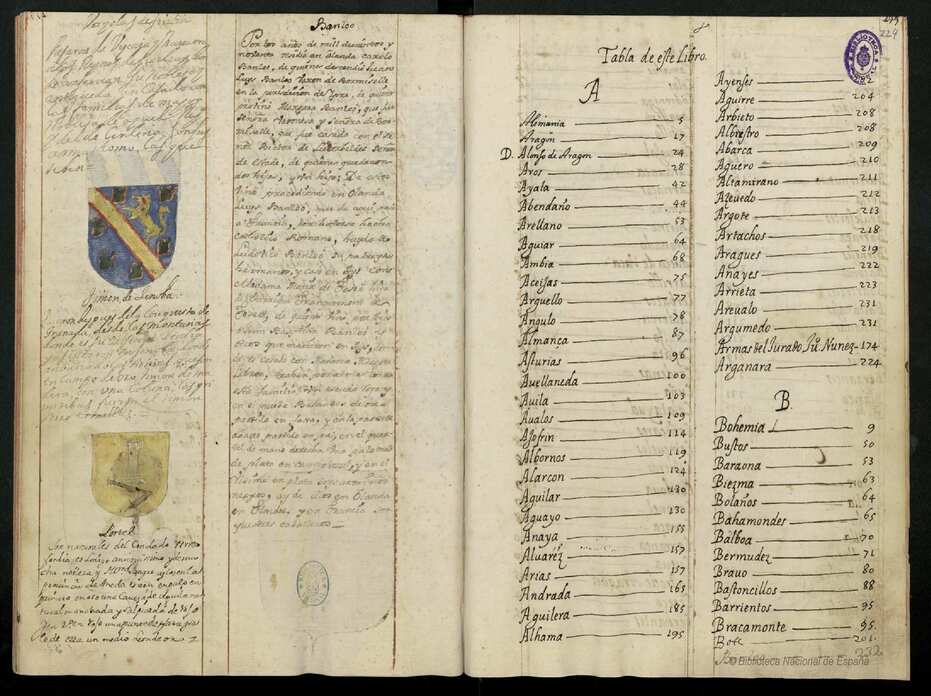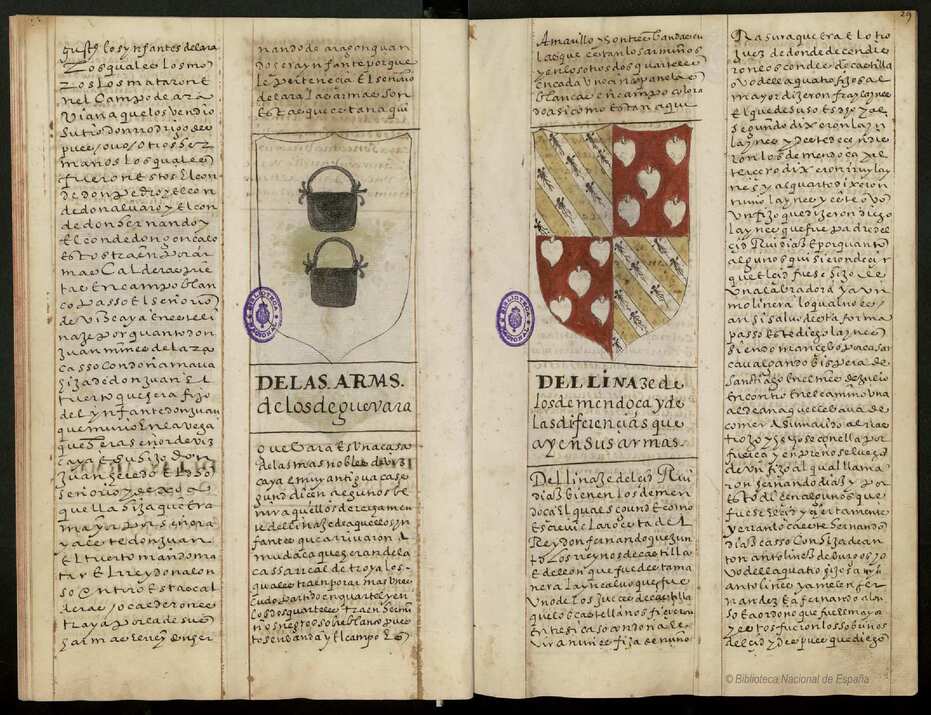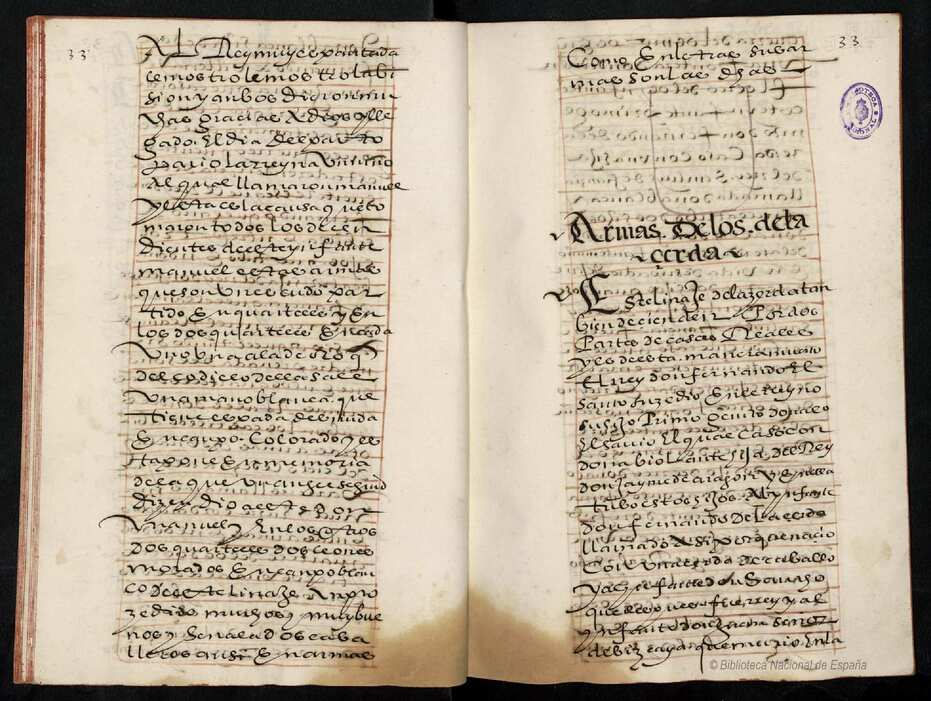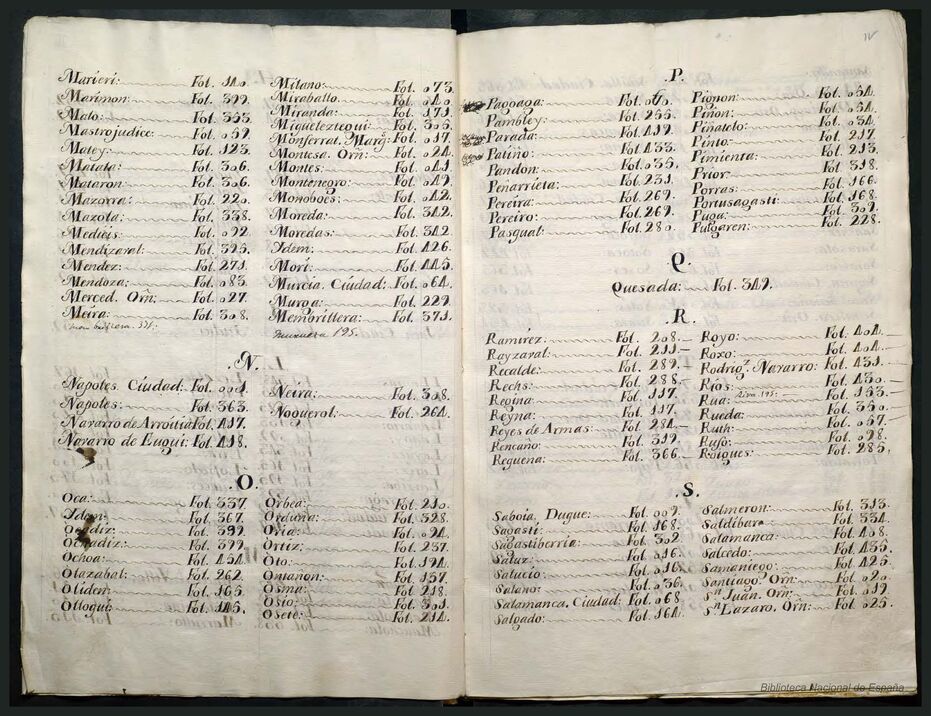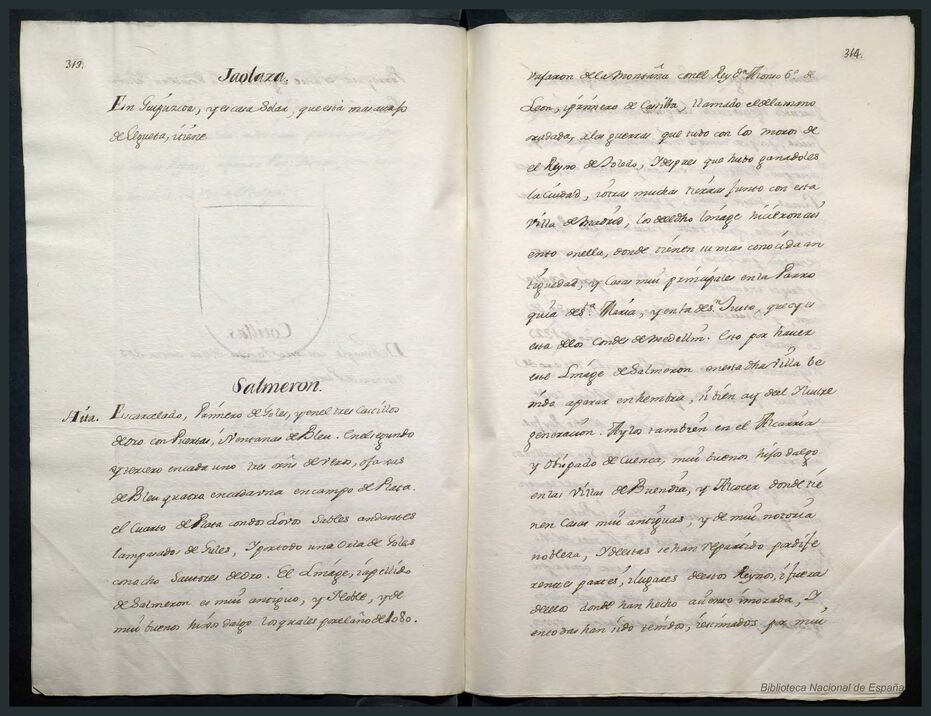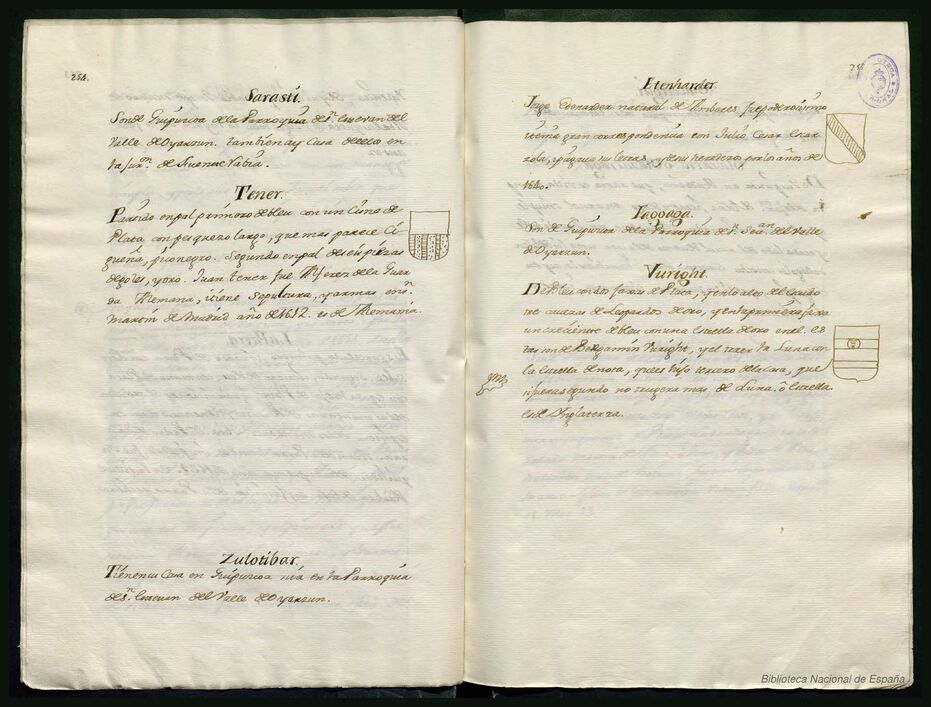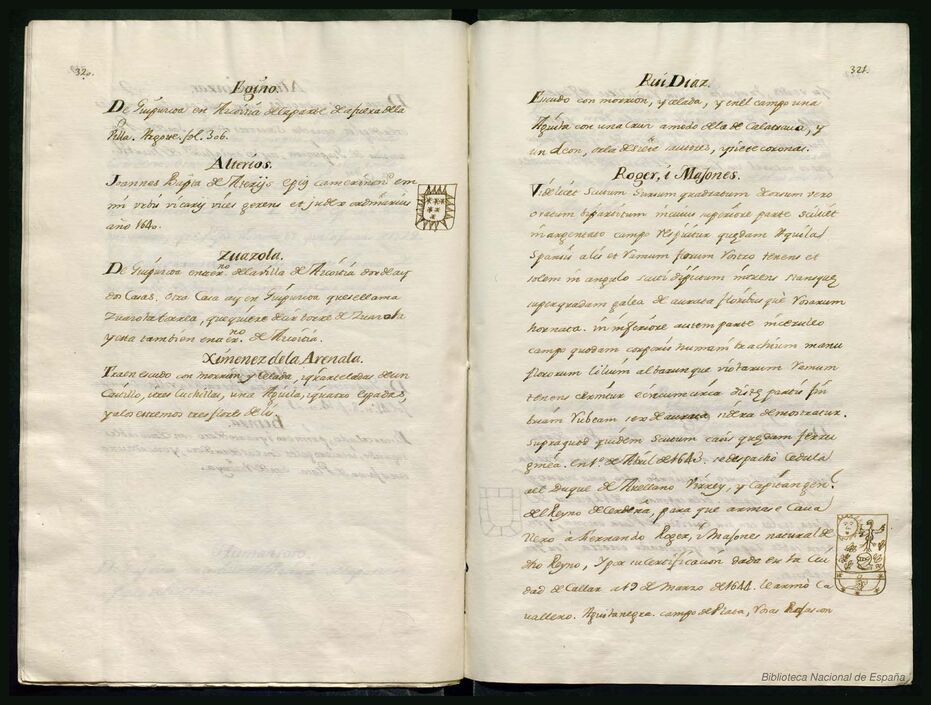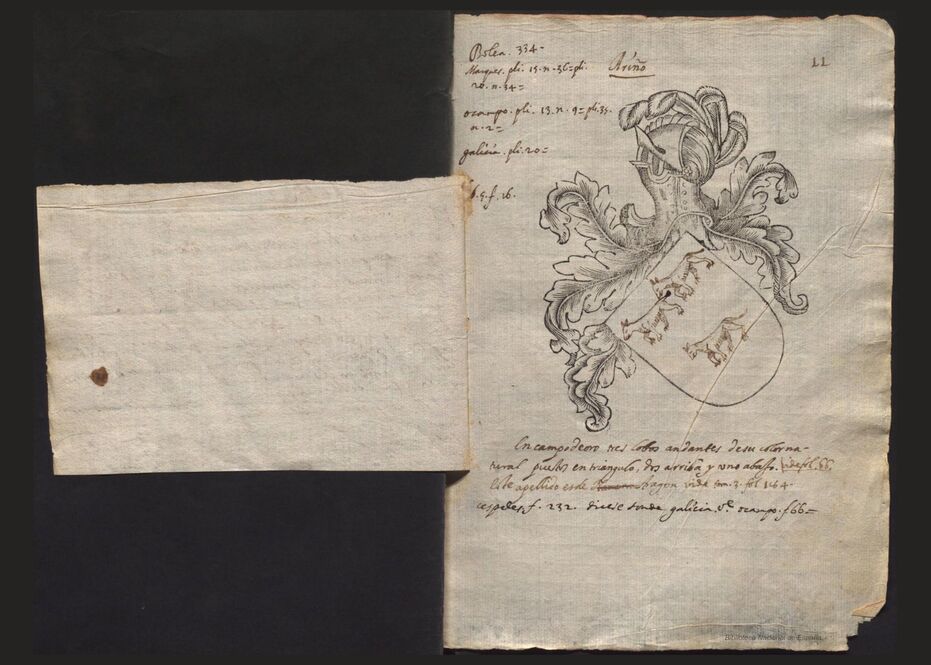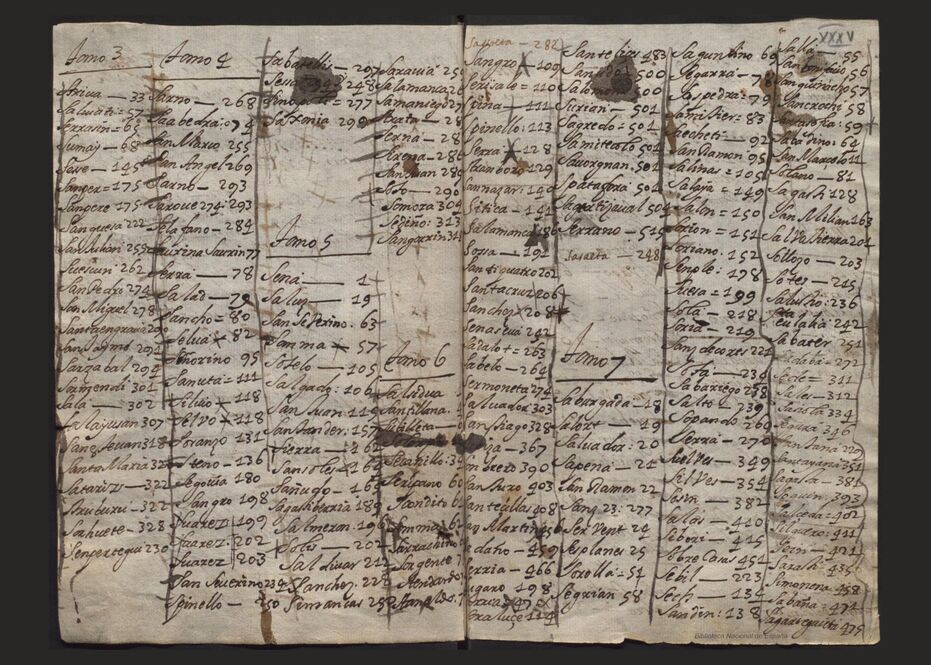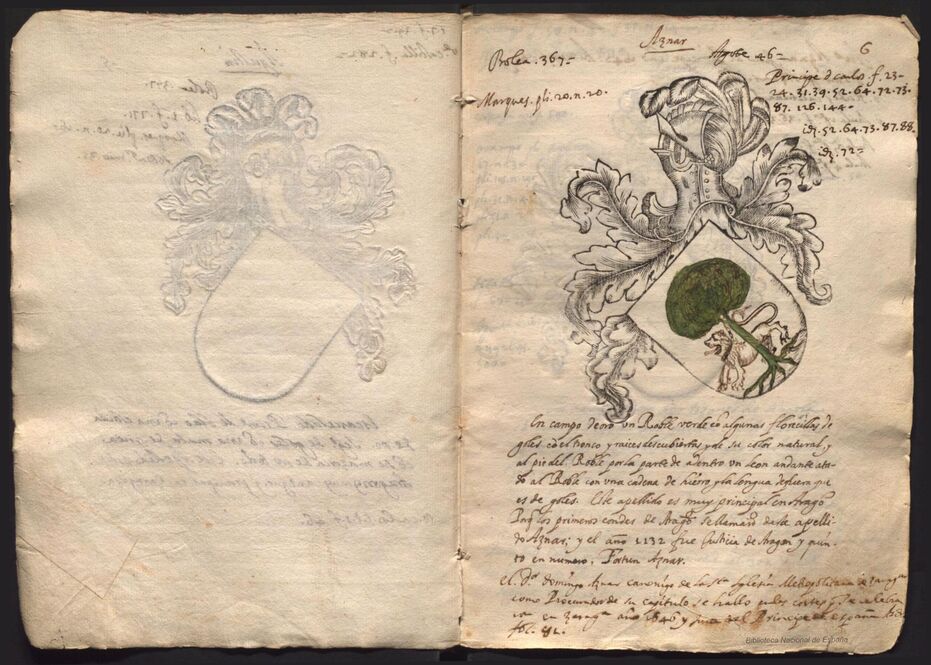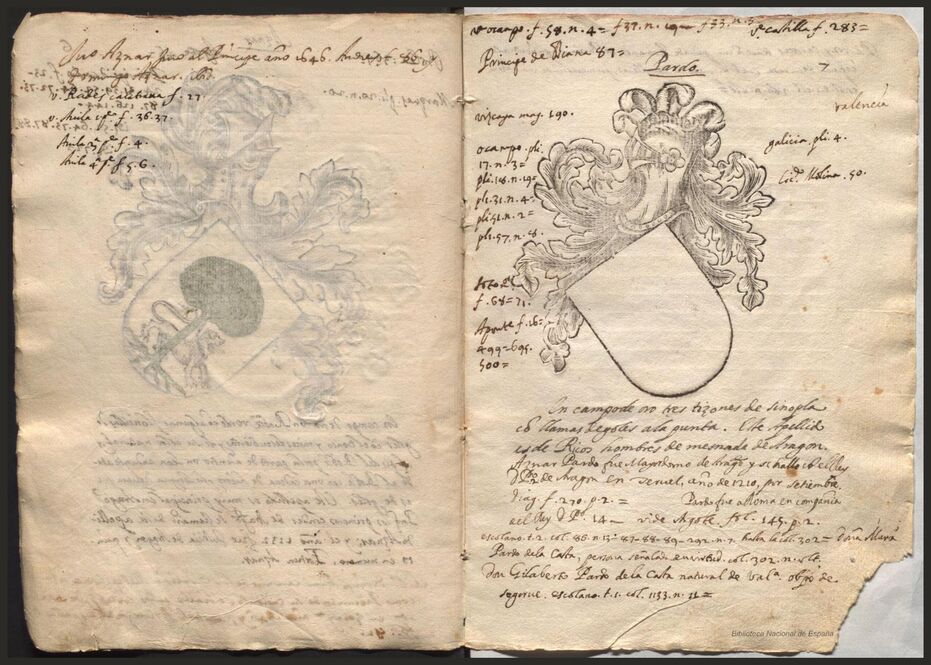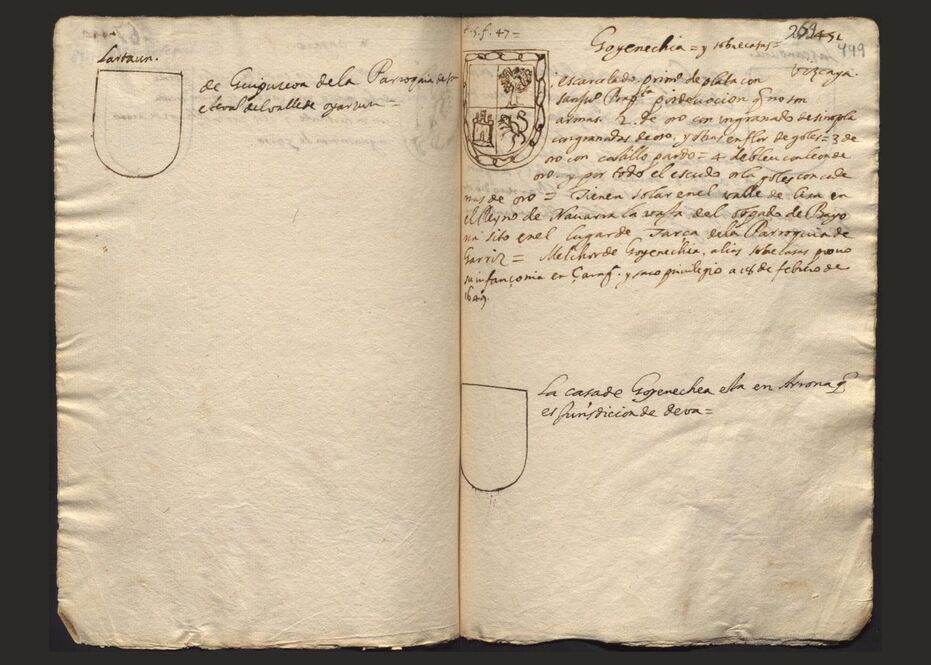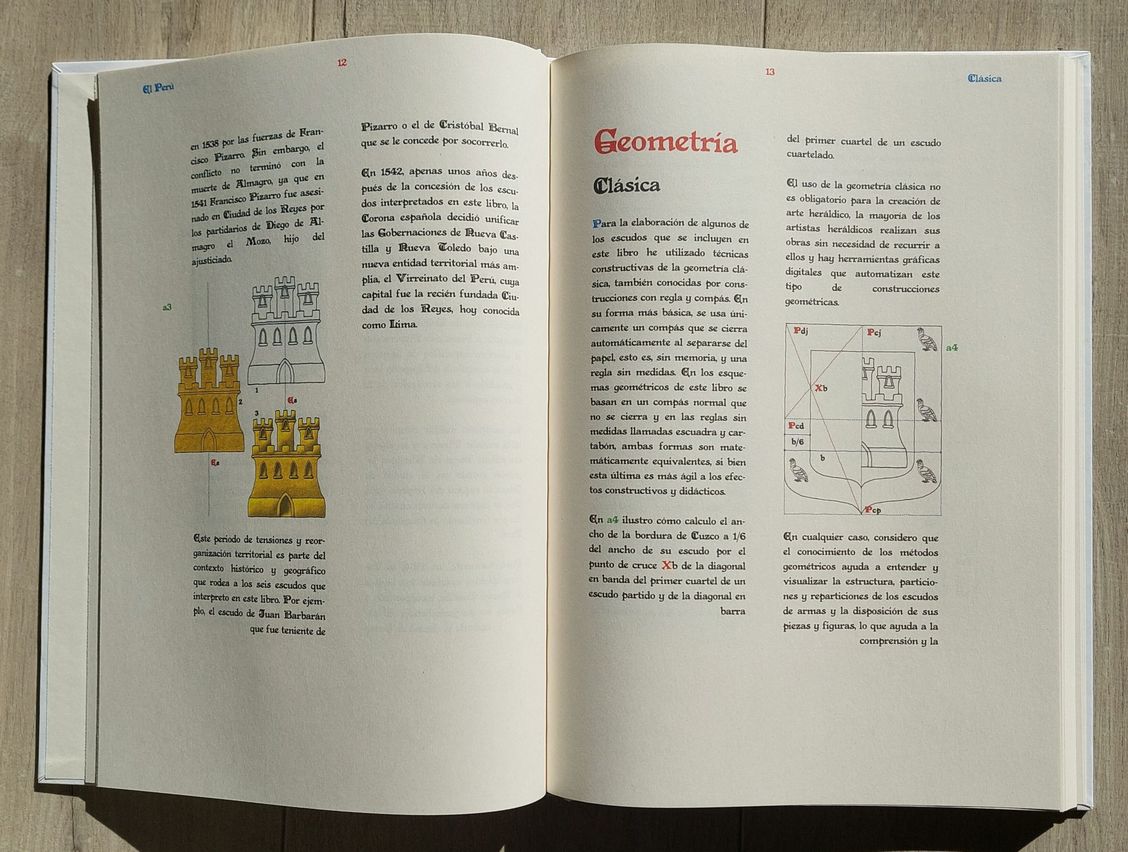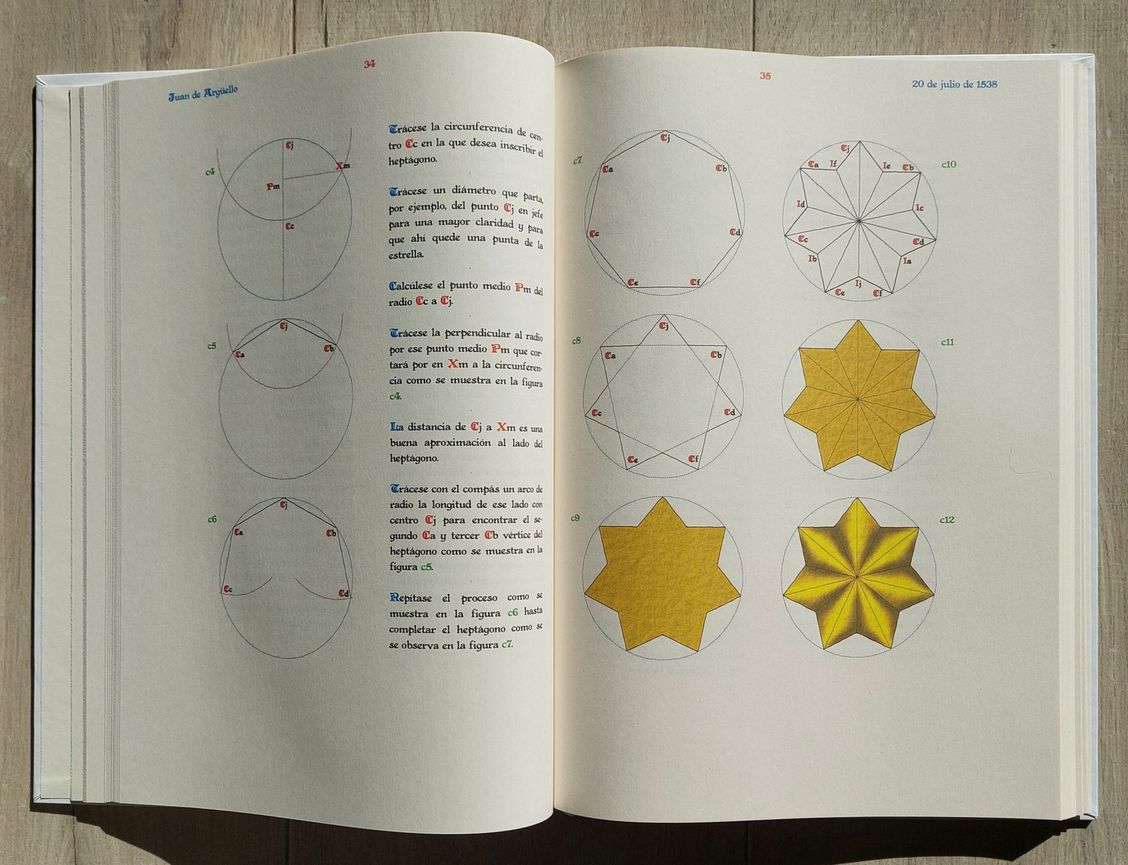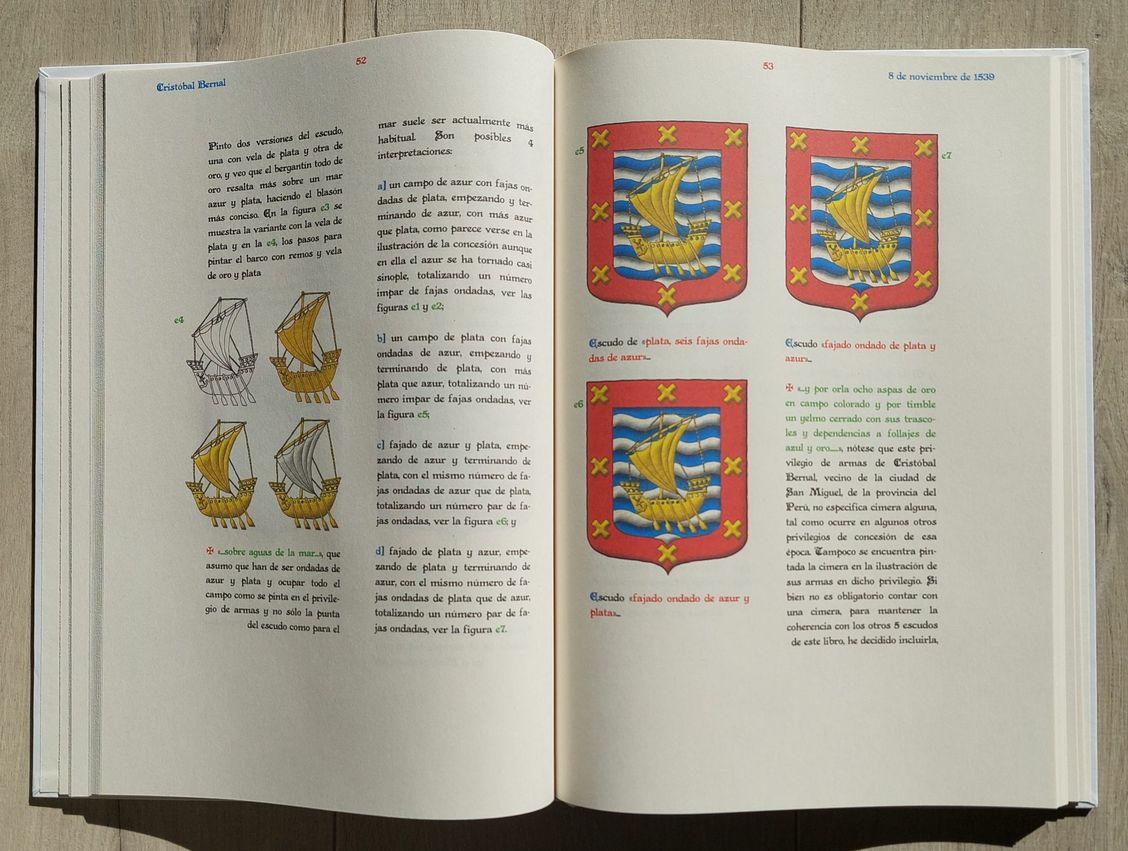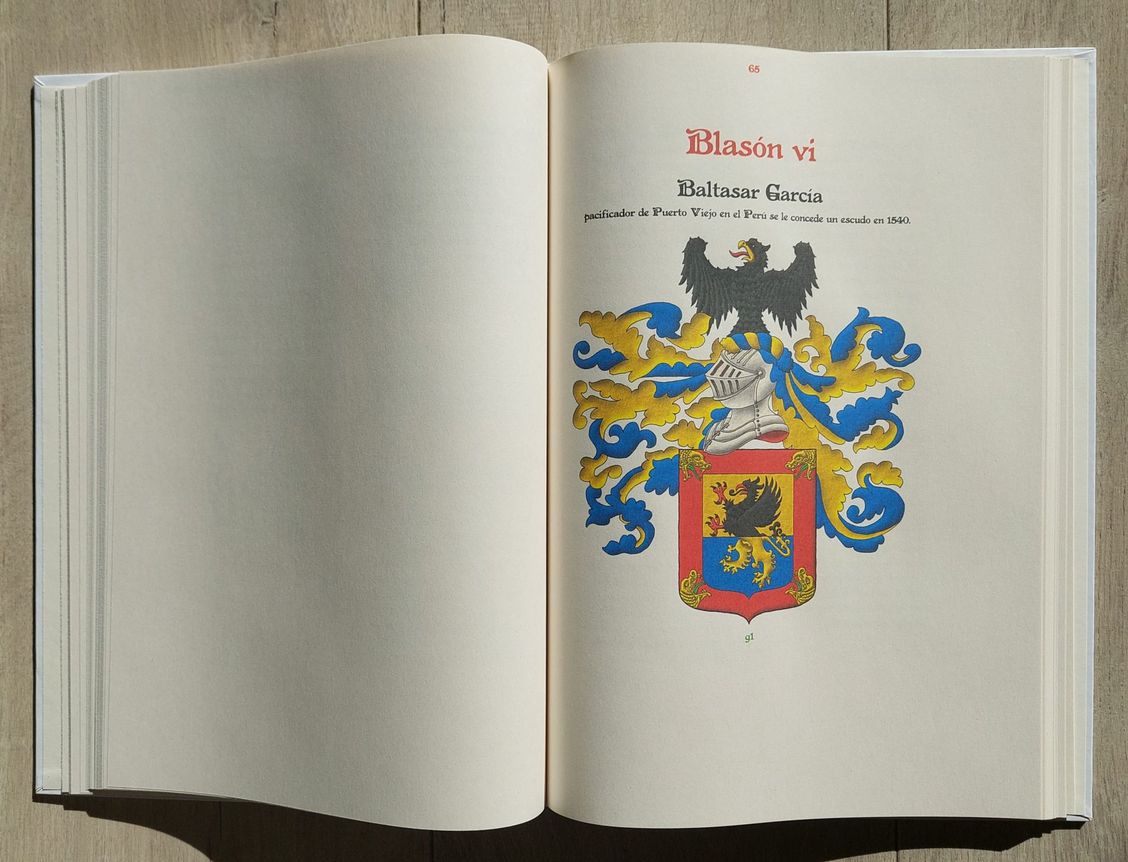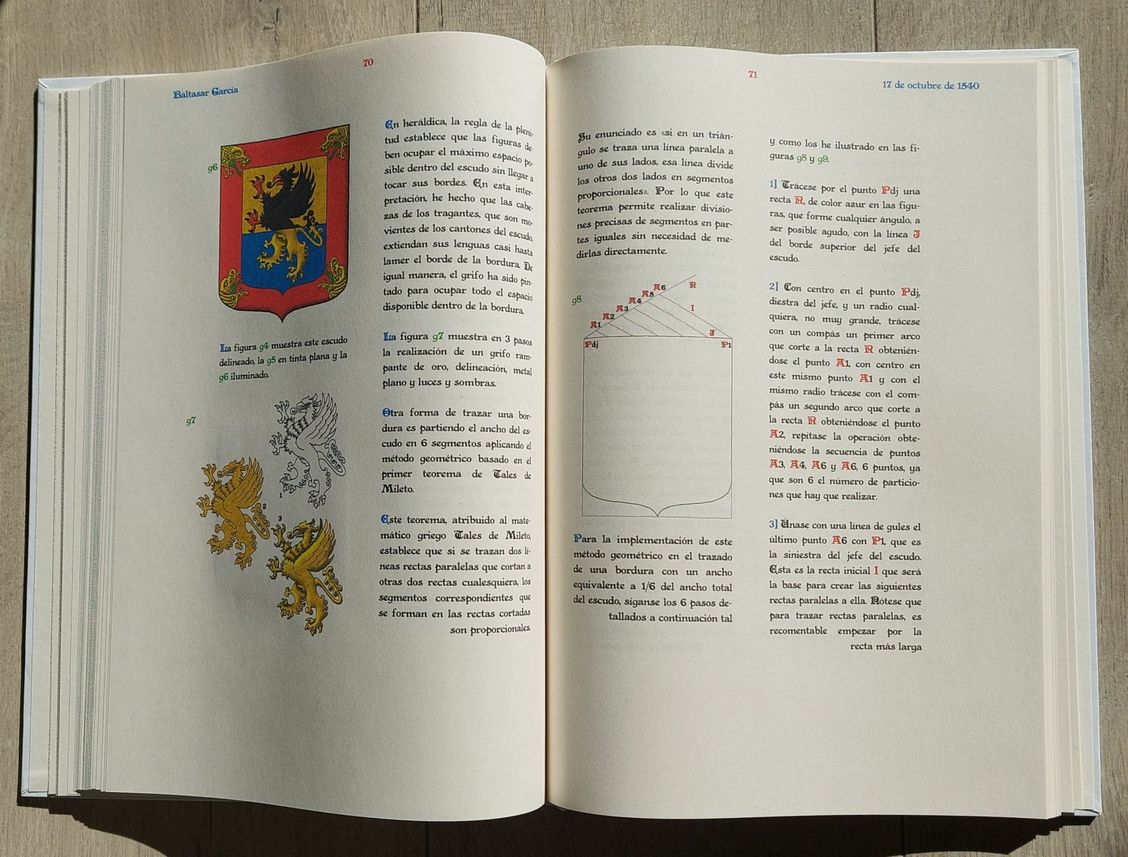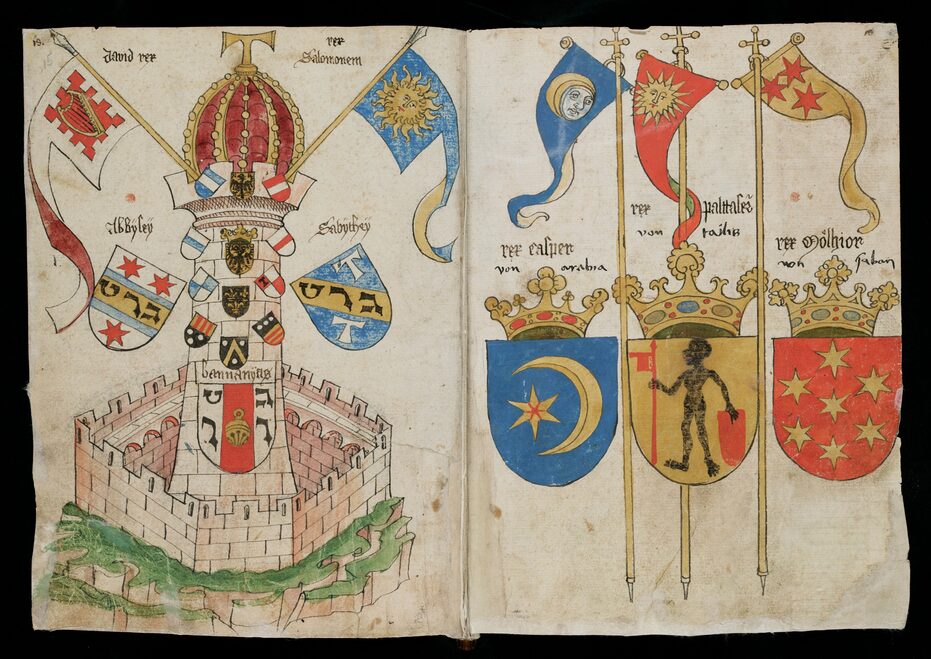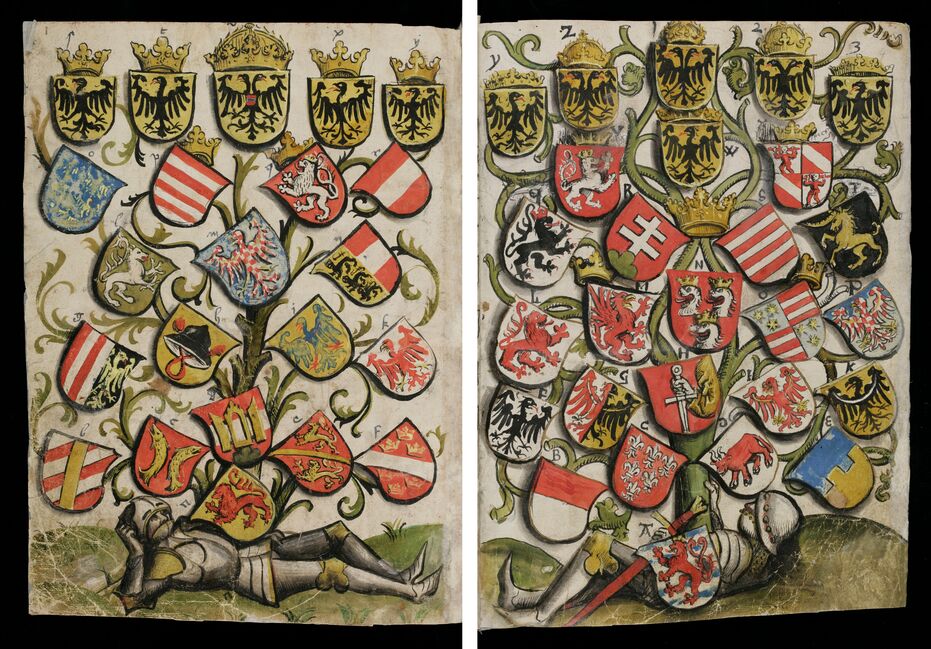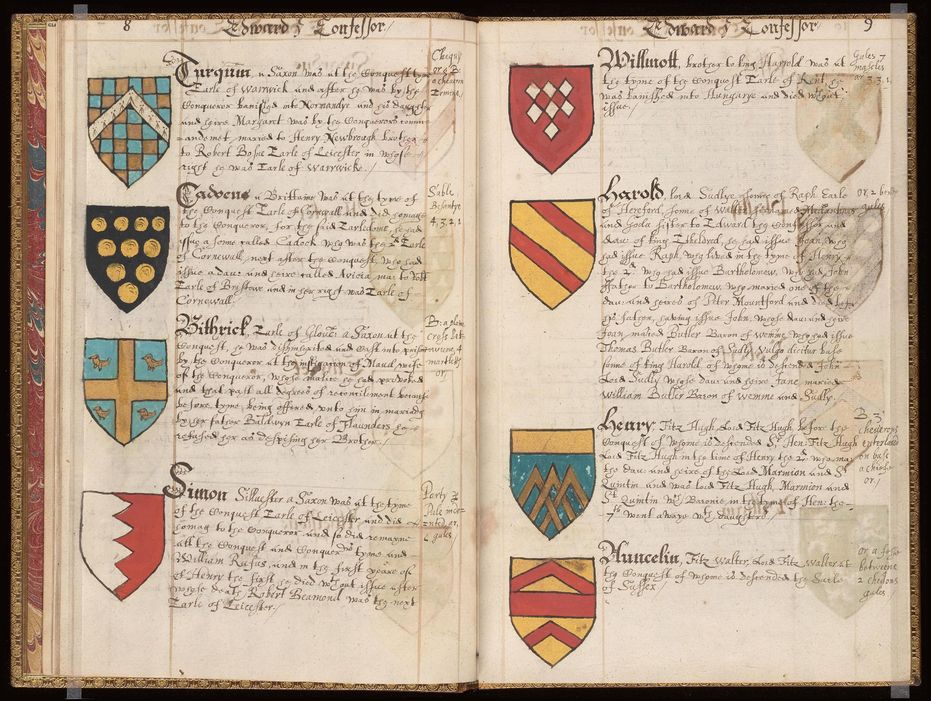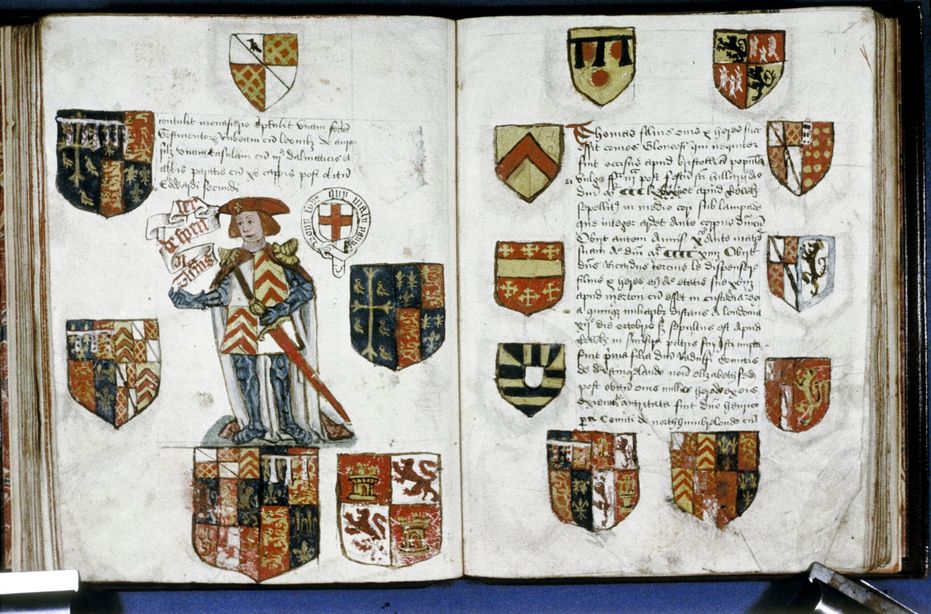Armorial roll


![Ver [Anonymous; 1800a] en referencias bibliográficas. Libro abierto, hojas de plata, filo de oro, guardas de gules, tapas de sable.](../css/Libro.Bibliografia.png)
Anonymous; 1800a
Anonymous, «Armerías de España», 124 double pages, title in the page 9, provenance Duke of Osuna and Infantado, 1800.
Content
The book has no index and its content, written by hand, is as follows:
- Pages 1 through 8 are blank.
- On page 9, title, the letter A begins and surnames Abarca, Abendaño, Abeo, Ablitas and Abrego in large handwritten and the blazon in small handwritten (except for the end of the book on page 123, the unknown author seems to write more about surnames than about lineages).
- On page 10, the surnames with the letter A continue and their blazon both in small handwritten.
- On page 23, the letter B begins, its surnames and their blazons, for example, the Barrasas, in the page 25, «Or, six Lions proper, combatant».
- On page 30, the letter C begins, it is followed by the letter Z on page 42, 29 surnames with Z was written before the letter D and Cocas and Cuacas, with the letter C, are inserted inside the letter Z.
- It follows in alphabetical order of surnames from page 46, where the letter D begins, to page 97 with the letter S, including in the S the surname Sánchez on page 99, as a lineage will be included at the end of the book, and it follows with the letter S until the page 104.
- On page 105 the letter T begins, surname Tabixas, Taboadas, Tafuxes, ...
- On page 109 jump from the letter T to the letter V, with the surnames Vacas, Vadillos,... and skipping the letter U.
- On page 119, it returns from letter V to U, in an unordered manner and without including the title with the capital letter U.
- On page 120, begins the letter X and also the letter Y.
- On page 122, the letter Z and only 3 additional surnames with Z, recall that the majority of the surnames with Z were included after the letter C.
- On page 123 he returns to the surname Sánchez by testimony of Pedro de Soto owner of the books of Armory of Spain of Andreas Heredia, King of Arms, and finally the unknown author copies the text for the surname Sánchez, those who were «hijosdalgos, en Cangas de Gobadonga» ~ Covadonga of Asturias and ends with a poem of 8 verses. Andreas Heredia, also known as Andrés Heredia, was King of Arms during the reign of Philip III of Spain, [Nieto y Cortadellas, R.; 1957a; Page 4]
- Beginning on page 124 are blank.
Bibliographical reference of century XVIII.
Classification: Manuscript, Armorial roll, In black and white and Castilian language.
Author: unknown.
Bibliographical reference mentioned in the following article:
External links:
- Detail of this Armorial in the National Library of Spain.
- Bibliographic record of the National Library of Spain.
- Scanned Armorial in the National Library of Spain.
Internal resources: Osuna1800.ArmeriaEspaña.Manuscrito.pdf.


![Ver [Armorial Register, T.; 2020] en referencias bibliográficas. Libro abierto, hojas de plata, filo de oro, guardas de gules, tapas de sable.](../css/Libro.Bibliografia.png)
Armorial Register, T.; 2020
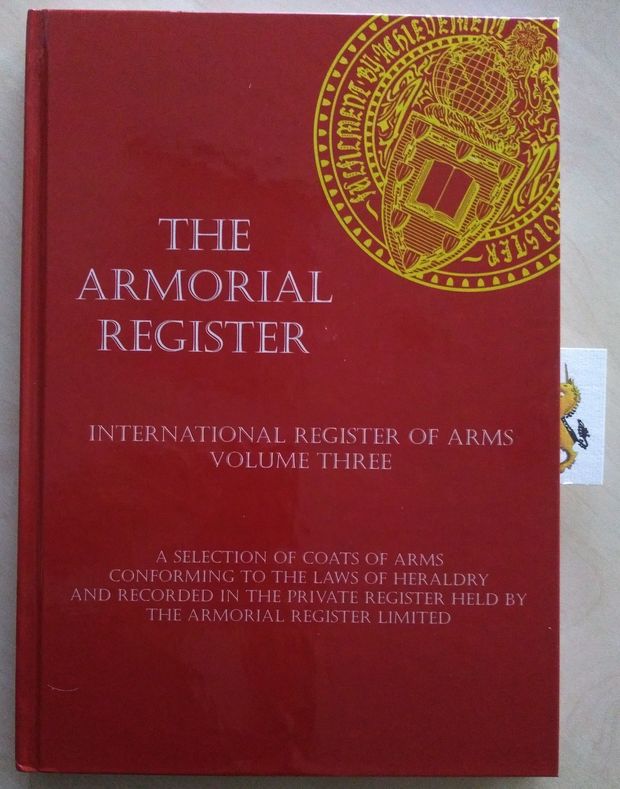
The Armorial Register, «International Register of Arms, Volume Three, a Selection of Coats of Arms Conforming to the Laws of Heraldry and Recorded in the Private Register Held by The Armorial Register Limited», 205 pages, Volume 3, Register from 367 to 549, edition supervised by Martin S. J. Goldstraw, edited and published by The Armorial Register, Banff, Aberdeenshire, 2020.
Bibliographical reference of century XXI.
Classification: Armorial roll, Black and white and color illustrations and English language.
Author: Armorial Register, The.
Bibliographic reference mentioned in the following articles:
- Antonio Salmeron, The Armorial Register
- Herbert Leo Buffenbarger, The Armorial Register
- John Alan Francis Buffenbarger, The Armorial Register
- Yannick Beuvelet, The Armorial Register
Internal resources: Libro físico.


![Ver [Armorial Register, T.; 2025] en referencias bibliográficas. Libro abierto, hojas de plata, filo de oro, guardas de gules, tapas de sable.](../css/Libro.Bibliografia.png)
Armorial Register, T.; 2025

The Armorial Register, «International Register of Arms, Volume Four, a Selection of Coats of Arms Conforming to the Laws of Heraldry and Recorded in the Private Register Held by The Armorial Register Limited», 201 pages, Volume 4, Register from 550 to 732, edition supervised by Martin S. J. Goldstraw, edited and published by The Armorial Register, Banff, Aberdeenshire, 2025, ISBN 978-1-8381483-0-0.
Bibliographical reference of century XXI.
Classification: Armorial roll, Black and white and color illustrations and English language.
The author is Armorial Register, The.
Bibliographic reference mentioned in the following articles:
- Antonio Ruiz Porras in the book International Register of Arms, Volume 4
- Arms of Roberto Luchoro and Darryn Carlo in the International Register of Arms, Volume 4
- Eugene McCarthy in the book International Register of Arms, Volume 4
- Fernando Marán Bié in the book International Register of Arms, Volume 4
- John Paul Durkan, collage
- Margaret Byrne in the book International Register of Arms, Volume 4
- Nilda E. Lucca de Anaya in the book International Register of Arms, Volume 4
Internal resources: Libro físico.


![Ver [Avilés, T. de; XVI] en referencias bibliográficas. Libro abierto, hojas de plata, filo de oro, guardas de gules, tapas de sable.](../css/Libro.Bibliografia.png)
Avilés, T. de; XVI
Tirso de Avilés, continued by Martín de Bolea y Castro, «Roll of arms», 3 volumes, Volume I, coats of arms of kings, princes and grand titles, 208 hand-numbered pages in Roman numerals, Volume II, coats of arms of noble and private titles, 129 hand-numbered pages in Arabic numerals, Volume III, coats of arms of popes, cardinals, archbishops and bishops, 185 hand-numbered pages in Arabic numerals, in the National Library of Spain, signatures Mss/12550 V.1, Mss/12551 V.2 and Mss/12552 V.3, it is estimated from the XVI century.
Bibliographical reference of century XVI.
Classification: Manuscript, Armorial roll, In color and Castilian language.
The author is Avilés, Tirso de.
Bibliographical reference mentioned in the following article:
External resources:
- Detail of this armorial in the National Library of Spain.
- Bibliographic record of the National Library of Spain.
- Scanned Armorial in the National Library of Spain.
Internal resources: Volume I AvilesTdeXVI.11.Tomo01.pdf, Volume II AvilesTdeXVI.11.Tomo02.pdf and Volume III AvilesTdeXVI.11.Tomo03.pdf.
Credits: This book belongs to the Biblioteca Nacional de España. License Creative Commons CC-BY. You may share, transform and create from images in the public domain that are accessible in the Hispanic Digital Library.


![Ver [Becher, C.; Gamber, O.; 1986] en referencias bibliográficas. Libro abierto, hojas de plata, filo de oro, guardas de gules, tapas de sable.](../css/Libro.Bibliografia.png)
Becher, C.; Gamber, O.; 1986
Charlotte Becher and Ortwin Gamber, «Die Wappenbücher Herzog Albrechts VI. von Österreich: Ingeram-Codex der ehem, Bibliothek Cotta, Volume 1», editado por Böhlau Verlag Wien, 178 pages, ISBN 3-205-05002-9 y 978-32-05050-02-5, Vienna, Cologne, Graz, 1986.
Dedicated exclusively to the study and analysis of the armorial [Ingeram, H.; 1459].
Bibliographical reference of century XX.
Classification: German language, Manuscript, Armorial roll and In color.
The 2 authors are Becher, Charlotte and Gamber, Ortwin.
Bibliographical reference mentioned in the following article:
External link:


![Ver [Bergshammars; 1440] en referencias bibliográficas. Libro abierto, hojas de plata, filo de oro, guardas de gules, tapas de sable.](../css/Libro.Bibliografia.png)
Bergshammars; 1440
Anonymous, «Roll of arms», roll of arms manuscript called Bergshammars, written, emblazoned and edited in Brabant, Burgundian Netherlands, during the years 1440-1456, 493 pages numbered later in pencil, contains coats of arms of several European kingdoms, on page 488 the year 1553 seems to be written, Brabant, ca 1440.
Bibliographical reference of century XV.
Classification: Armorial roll, Manuscript and In color.
Author: unknown.
The following articles cite this bibliographic reference:
External links:
Internal resources: Bergshammars1440.33.Video.Manuscript.SchubertSymphony4.mp4 a video lasting 7 minutes and 11 seconds, sound track Symphony No. 4 in C minor, D 417, called Tragic, composed by Franz Schubert in April 1816, when he was 19 years old.


![Ver [Burke, J.; 1836] en referencias bibliográficas. Libro abierto, hojas de plata, filo de oro, guardas de gules, tapas de sable.](../css/Libro.Bibliografia.png)
Burke, J.; 1836
John Burke, «A Genealogical and Heraldic History of the Commoners of Great Britain and Ireland: Enjoying Territorial Possessions or High Official Rank; but Uninvested with Heritable Honours», 4 volumes, volume 1 with 726 printed pages, volume 2 with 740 printed pages, volume 3 with 738 printed pages, volume 4 with 805 printed pages, published for Henry Colburn by R. Bentley, Bell and Bradfute, in Edinburgh, and J. Gumming in Dublin, London, 1836.
Overview
This extensive work spans four volumes, 726 + 740 + 738 + 805 = 2309 pages, and provides a detailed account of the genealogy and heraldry of commoners in Great Britain and Ireland who held territorial possessions or high official ranks, yet were not vested with heritable honors.
Coats of arms and blazons
Each volume contains black and white illustrations of coats of arms, typically including the crest and wreath, with some also featuring supporters. The illustrations do not utilize hatching or tricking for tinctures, the tinctures must be seen in the text of the written blazons. For each lineage, the coat of arms is illustrated at the beginning, followed by a genealogical account, and the blazon is provided at the end. For example, for the Talbot lineage, in the volume 3, page 359-360, the blazon is written as follows: «Arms - Gu. a lion rampant, within a bordure engr. or. Crest - On a chapeau gu. turned up ermine, a lion statant or, the tail extended. Motto - Prest d'accomplir.» where «gu» is Gules and «or» is Or.
Bibliographical reference of century XIX.
Classification: Armorial roll, English language and In black and white.
The author is Burke, John.
Bibliographical reference mentioned in the following article:
External links:
Internal resources: BurkeJ1836.Commoners.Volume.01.pdf 758 pages in PDF format, BurkeJ1836.Commoners.Volume.02.pdf 772 pages in PDF format, BurkeJ1836.Commoners.Volume.03.pdf 762 pages in PDF format and BurkeJ1836.Commoners.Volume.04.pdf 838 pages in PDF format.


![Ver [Charles' Roll; 1285] en referencias bibliográficas. Libro abierto, hojas de plata, filo de oro, guardas de gules, tapas de sable.](../css/Libro.Bibliografia.png)
Charles' Roll; 1285
«Charles's Roll», containing 486 painted coats of arms, it is an English roll of arms dating from c. 1285.
Charles' Roll, housed in the Society of Antiquaries, London, and cataloged as MS517, is a 15th-century English roll of arms, originally created around 1285, containing 486 painted coats of arms. The antiquary James Robinson Planché identified «Charles's Roll» as a copy of a mid-13th-century roll, British Library, Harley MS 6589, featuring nearly 700 coats of arms, drawn by Nicholas Charles, Lancaster Herald, in 1607. Charles mentioned that the original roll had been lent to him by the Norroy King of Arms.
Bibliographical reference of century XIII.
Classification: Armorial roll, Manuscript and In color.
Author: unknown.
The following articles cite this bibliographic reference:


Claudia Trujillo Jiménez, page of armorial

Purpure, three dragons passant, in pale Argent; a bordure Gules, eight saltires couped Or. Crest: A crown of the Sovereign and Most Noble Order of the Pomegranate. The shield is surrounded by the Grand Collar of the Sovereign and Most Noble Order of the Pomegranate.
This is her coat of arms of emblazoned by me for the Roll of Arms of the Sovereign and Most Noble Order of the Pomegranate.
Blazon keywords: Without divisions, Purpure, Three, Dragon, Passant, In pale, Argent, One, Bordure, Gules, Eight, Saltire, Or, Crest and mantling, Crown, Pomegranate, Surrounded and Grand collar.
Style keywords: Ogee, Outlined in sable, Illuminated and Leather.
Classification: Personal, Interpreted, Coat of arms, Armorial roll and Castilian language.
Bearer: Trujillo Jiménez, Hermanos.


![Ver [Cofradía de Santiago; Century XIV] en referencias bibliográficas. Libro abierto, hojas de plata, filo de oro, guardas de gules, tapas de sable.](../css/Libro.Bibliografia.png)
Cofradía de Santiago; Century XIV
Anonymous, «Libro de la Cofradía de Caballeros de Santiago de la Fuente», held by the Brotherhood of Santiago, Burgos Cathedral, manuscript, illustrated, 94 leaves, 21 missing, folio size, 29 x 21 centimeters, Burgos, 1338-1636.
Introduction
The illuminated manuscript chronicles the history and membership of the Brotherhood of Knights of Santiago in Burgos. Founded in 1338 during the reign of King Alfonso XI, as indicated by the preamble to the Rule on folio 27 verso, the Brotherhood was composed of members of the social and political elite of Burgos. The manuscript spans several centuries, primarily from the 14th to the 17th century.
The first 13 folios include a record of four deeds dating from 1396 to 1415, all related to the financial dealings of the Brotherhood.
Folio 14 marks the beginning of the original Rule of the Brotherhood, adorned with an illuminated initial «E» and a vignette of Christ flanked by saints and angels.
Portraits and illumination
The manuscript includes a list of the members, known as «cofrades» in Castilian, alongside their portraits and coats of arms. The book contains 295 portraits, added over time, with the last one dated to 1636.
The knights depicted in the manuscript held significant roles in the city, such as mayors, scribes, and other high offices. Many of the knights' families, like the Camargos from France and the Sanchestels from England, are noted for their diverse origins.
The portraits begin on page 21, initially with four to a page until folio 44, after which the number decreases to three, two, and eventually single figures per page.
Binding and preservation
The manuscript is bound in red leather with gold fillets and clasps, a 19th-century binding aimed at preserving the parchment pages. Originally, it had 94 leaves, but 21 are now missing, as noted in a contemporary annotation at the front.
Bibliographical reference of century XIV.
Classification: Manuscript, Armorial roll, Castilian language and In color.
Author: unknown.
Here are the articles quoting this reference:
Internal resources: 86 images in JPEG format.


![Ver [Cró, J. do; 1509] en referencias bibliográficas. Libro abierto, hojas de plata, filo de oro, guardas de gules, tapas de sable.](../css/Libro.Bibliografia.png)
Cró, J. do; 1509
João do Cró, «Livro do Armeiro-Mor», roll of arms manuscript, written and emblazoned during the reign of Manuel I of Portugal, 161 pages, it is in the Torre do Tombo National Archive, ca 1509.
Bibliographical reference of century XVI.
Classification: Manuscript, Armorial roll, In color and Portuguese language.
Author: João do Cró.
The following articles cite this bibliographic reference:
External resource:
Internal resources: CroJdo1509.LivroDoArmeiroMor.02.Comentado.Desordenado.pdf 277 pages and Facsimile edition on paper.

![Ver [Durasov, V. A.; 1906] en referencias bibliográficas. Libro abierto, hojas de plata, filo de oro, guardas de gules, tapas de sable.](../css/Libro.Bibliografia.png)
Durasov, V. A.; 1906
Vladimir Alexandrovich Durasov, «Heráldica de la Nobleza de toda Rusia», 279 páginas, San Petersburgo, 1906.
Descripción
Esta obra, escrita por V. A. Durasov, es un registro heráldico completo de la nobleza rusa. Proporciona ilustraciones de los escudos de armas de las familias nobles a lo largo del Imperio Ruso.
El nombre completo del autor es Vladimir Alexandrovich Durasov, aunque en algunas fuentes, especialmente en versiones traducidas o abreviadas, puede aparecer como «W. Durasov» debido a problemas comunes de transliteración del ruso al alfabeto latino.
La obra se cita comúnmente como publicada en 1906, según se indica al inicio del libro; sin embargo, la fecha en la última página del libro es 1907.
Bibliographical reference of century XX.
Classification: Armorial roll, Russian language and Black and white with color plates.
Author: Durasov, Vladimir Alexandrovich.
Internal resources: DurasovVA1906.HeraldicaNoblezaRusa.pdf Formato PDF.


Edwin Gräupl, page of armorial
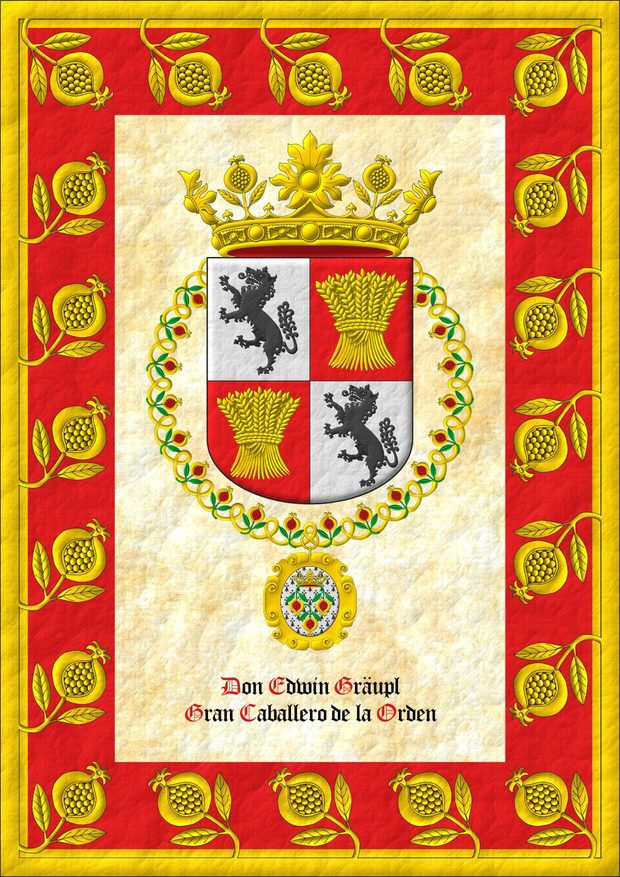
Quarterly: 1 and 4 Argent, a wolf rampant Sable; 2 and 3 Gules, a garb Or. Crest: A crown of the Sovereign and Most Noble Order of the Pomegranate. The shield is surrounded by the Grand Collar of the Sovereign and Most Noble Order of the Pomegranate.
This is his coat of arms of emblazoned by me for the Roll of Arms of the Sovereign and Most Noble Order of the Pomegranate.
Blazon keywords: Quarterly, Argent, One, Wolf, Rampant, Sable, Gules, Garb, Or, Crest and mantling, Crown, Pomegranate, Surrounded and Grand collar.
Style keywords: Rounded, Outlined in sable, Illuminated and Leather.
Classification: Personal, Interpreted, Coat of arms, Armorial roll and Castilian language.
Bearer: Gräupl, Edwin.


![Ver [Finas, F.; 1950] en referencias bibliográficas. Libro abierto, hojas de plata, filo de oro, guardas de gules, tapas de sable.](../css/Libro.Bibliografia.png)
Finas, F.; 1950
Fromageries Finas, «Collection des blasons de France. 1st Edition», «Collection des blasons de France. 2nd Edition», 23 pages, illustrated by Jean Brian, cover signed by R. Assier, published by Fromageries Finas, Saint-Félix, Haute-Savoie, circa 1950.
The «Collection des blasons de France» collections include two editions: the first edition with 50 coats of arms from French provinces and the second edition with 100 coats of arms from the main cities of France.
Each coat of arms was included in the packaging of Finas spreadable cheeses. The albums were available upon request for 10 postage stamps to cover handling costs.
These albums are an excellent example of how brands used heraldry to create an emotional and educational connection with their customers, employing coats of arms to reinforce a sense of identity and tradition, as can be seen in the index of the 1st edition.
Index of the 1st edition, coat of arms and page:
- Alsace 8
- Angoumois 12
- Anjou 10
- Armagnac 14
- Artois 4
- Aunis 12
- Auvergne 16
- Bar 8
- Béarn 14
- Beaujolais 6
- Berry 12
- Bourbonnais 6
- Bourgogne 6
- Bresse 6
- Bretagne 10
- Champagne 8
- Charolais 6
- Comtat-Venaissin 18
- Corse 18
- Dauphiné 18
- Flandre 4
- Foix 14
- Forez 16
- Franche-Comté 8
- Gascogne 14
- Guyenne 14
- Ile-de-France 4
- Languedoc 16
- Limousin 12
- Lorraine 8
- Lyonnais 6
- Maine 10
- Marche 12
- Maurienne 18
- Navarre 14
- Nice 18
- Nivernais 6
- Normandie 10
- Orléanais 10
- Picardie 4
- Poitou 12
- Provence 18
- Quercy 14
- Roussillon 16
- Saintonge 12
- Savoie 18
- Touraine 10
- Valois 4
- Vermandois 4
- Vivarais 16
Bibliographical reference of century XX.
Classification: Armorial roll, French language and In color.
The author is Finas, Fromageries.
Internal resources: FinasF1950.01.Edition.pdf Digital PDF version of the 1st Edition and FinasF1950.02.Edition.pdf Digital PDF version of the 2nd Edition.


Francisco Jose Bermejo Fernandez-Briceño, page of armorial
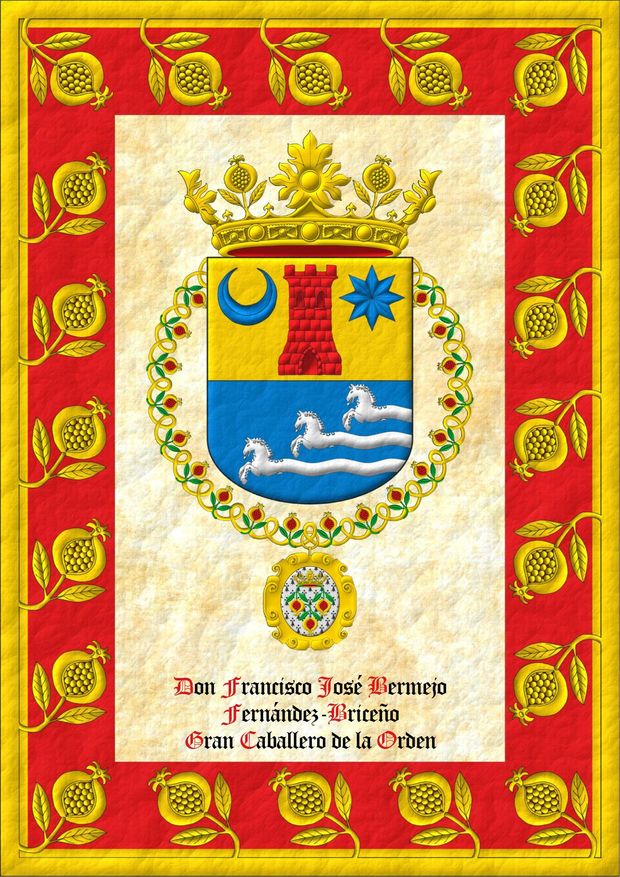
Party per fess: 1 Or, a tower Gules between in chief a crescent and a mullet of eight points Azure; 2 Azure, three demi-horses courant in bend sinister nascent from the ends of three bars wavy issuant from sinister Argent. Crest: A crown of the Soberana y Muy Noble Orden de la Granada. The shield is surrounded by the collar of the Sovereign and Most Noble Order of the Pomegranate.
It has been interpreted by me, highlighted with lights and shadows, contoured in Sable, with a rounded external shape and with a texturized finishing.
This is the coat of arms of Francisco-José Bermejo Fernández-Briceño designed by Ignacio Koblischek and emblazoned by me for the Roll of Arms of the Soberana y Muy Noble Orden de la Granada.
Blazon keywords: Or, Azure, Gules, Argent, One, Three, Party per fess, Tower, Between, In chief, Crescent, Mullet, Demi, Horse, Courant, In bend sinister, Nascent, Bar, Wavy, Issuant, Sinister, Crown of the Sovereign and Most Noble Order of the Pomegranate, Crown, Surrounded and Collar.
Style keywords: Outlined in sable, Illuminated and Rounded.
Classification: Personal, Interpreted, Boa, Armorial roll and Castilian language.
Bearer: Bermejo Fernandez-Briceño, Francisco Jose.


![Ver [Galdiano L.; Century XVII] en referencias bibliográficas. Libro abierto, hojas de plata, filo de oro, guardas de gules, tapas de sable.](../css/Libro.Bibliografia.png)
Galdiano L.; Century XVII
Anonymous, «Arms and Lineages of Spain», Lázaro Galdiano Foundation, call number 405, manuscript, illustrated, 330 pages, 29 x 22 centimeters, century XVII.
Content and notes
This manuscript contains heraldic descriptions and illustrations of coats of arms, with a coat of arms at the end of each lineage. The coats of arms are painted at the end, and the title of the next lineage is written so close, sometimes physically attached, that one might believe that the title under the coat of arms belongs to the lineage of the coat of arms, when it is actually the coat of arms of the previous lineage. The initial index occupies 20 pages, then the folios are numbered r, recto, up to 194, folio 195 is numbered, its title is «of the Medranos» and it contains an unusual coat of arms, by another hand and without tinctures, folio 196 is numbered and blank, and the final 14 folios are written in another style, and they are a small compendium of heraldic concepts. I understand that the Medrano family might have owned this manuscript for a time and added their lineage at the end of this armorial.
Physical condition and binding
Some leaves have been restored and reinforced at the margins, and the manuscript is in good condition. There is an annotation in manuscript on the verso of the first guard leaf: «8, 1500, F».
A dry stamp is present on the second guard leaf: «Obrador De Encuadernaciones De Antonio Menard. 15 Cervantes 15 Madrid». The manuscript is bound in vellum with a gilded top edge.
Manuscript index
- Alphabetical table of lineages.
-
Armorial of kings:
- Of the arms of Prester John.
- Follow the arms and blazon of Jerusalem.
- Of the branches of the Kingdom of Cyprus and its King.
- Arms of the German Empire.
- Of the King of Hungary.
- The arms of Frisia and why it lost the name of Kingdom.
- Bohemia.
- Arms of the King of Poland and León.
- Of the kingdom of Sweden and Gothia.
- Of the kingdom of Norway.
- Of the King of Gelandia.
- Of the King of Scotland.
- Arms of England.
- Of the King of Hibernia.
- Arms of Rome.
- Arms of the King of Naples.
- Of the Duke of Milan.
- Of the King of Sicily.
- Of the King of France.
- Those who populated Spain are written.
- Of the Kings of Navarra.
- Of the King of Aragón.
- Of the King of Portugal.
- How the kings of Castilla began.
-
Armorial of lineages:
- Of the Manuels.
- Of the De la Cerda.
- Of the Enríquez.
- Of the Duke of Va Hermosa Don Alonso de Aragón.
- Of the Castillas.
- Of the Guzmanes.
- Of the Flores.
- Of the Ponces de León.
- Of the Carrillos.
- Of the Manriques.
- Of the De Albornoz.
- Of the Riveras.
- Of the Portugals.
- Of the Haros.
- Of the Lara lineage.
- Of the Guevaras.
- Of the Mendozas.
- From where the Hurtados come.
- Of the foundation and surname of Ayala.
- Of the Velascos.
- Of the De Castros.
- Of the Herreras.
- Of the De la Vegas.
- Of the De Tovars.
- Of the Sarmientos.
- Of the Estunigas.
- Of the Añayas.
- Of the Cerezos.
- Of the Heredias.
- Of the Aguilars.
- Of the Pachecos.
- Of the Osorios lineage.
- Another difference of arms.
- Pimentels.
- Of the Avellanedas.
- Of the Bracamontes.
- Of the Cueva.
- Of the Toledos.
- Another difference of arms of Toledo from the Garcías.
- Of the Barrosos.
- Of the Silvas.
- Of the Palomeques.
- Of the Gaitanes.
- Of the Gudiels.
- Of the Sandovals.
- Of the Niños.
- Of the Cervatos.
- Of the Fonsecas.
- Of the Coroneles.
- Of the Avalos.
- Of the Lunas.
- Of the Torquemadas.
- Of the Carvajales.
- Of the Rivadeneiras.
- Of the Padillas.
- Of the Valderrábanos.
- Of the Aguayos.
- Of the Zapatas.
- Of the Mirandas.
- Of the De Acuñas.
- Of the Arellanos.
- Of the Castañedas.
- Of the Quiñones.
- Of the Cornados.
- Of the Cervantes.
- Of the Loaysas.
- Of the Cisneros.
- Of the Dazas.
- Of the Córdobas.
- Of the Matas.
- Of the Aceves.
- Of the Cuellos.
- Of the Villarrueles.
- Of the De Biveros.
- Of the De Rojas.
- Of the De Orozcos.
- Those called from Bizcaya.
- Of the Sorvas.
- Of the Maldonados.
- Of the Fajardos.
- Of the Contreras.
- Of the Moscosos.
- Of the Mejías.
- Of the Sosas.
- Of the Figueroas.
- Of the Barahonas.
- Of the Montoyas.
- Of the Alarcóns.
- Of the La Torre.
- Of the Ludos.
- Of the Moyas.
- Of the Ángulos.
- Of the Calatayuds.
- Of the Gaonas.
- Of the Mendaños.
- Of the Beneros.
- Of the Londoños.
- Of the Quevedos.
- Of the Ulloas.
- Of the Quirogas.
- Of the Liras.
- Of the Meneses.
- Of the Girones.
- Of the constable Miguel Lucas.
- Of the Prados.
- Of the Salazars.
- Of the Solórzanos.
- Of the Cárdenas.
- Of the Biedmas.
- Of the Obregóns.
- Of the Bustos.
- Of the Almansas.
- Of the Puerto Carreros.
- Of the Sartes.
- Of the Carates.
- Of the Aljofríns.
- Of the Barrientos.
- Of the Reinosos.
- Of the Locanas.
- Of the Chacones.
- Of the Pantojas.
- Of the Carranzas.
- Of the Pereas.
- Of the Vanegas.
- Of the Lujanes.
- Of the Calderones.
- Of the La Cadena.
- Of the Delgadillos.
- Of the Clavijos.
- Of the Grajedas.
- Of the Ávila.
- Of the Lisones.
- Of the De Mesas.
- Of the Las Ruelas.
- Of the Rapados.
- Of the Villandrandos.
- Of the Luzones.
- Of the Torres.
- Of the De Soliez.
- Of the Herrezuelos.
- Of the Pavía.
- Of the Berrios.
- Of the Baruas.
- Of the Benavides.
- Two differences of arms.
- Of the Narváez.
- Of the Robles.
- Of the De Ñero.
- Of the Mojicas.
- Of the Bacanes.
- Of the Bastoncillos.
- Of the Bocanegras.
- Of the Castillos.
- Of the De Cañizares.
- Of the Cerezuela.
- Of the Dorantes.
- Of the De Estrada.
- Of the Escobares.
- Of the Salcedos.
- Of the De Inestrosa.
- Of the De Isla.
- Of the Illanes.
- Of the Jaravas.
- Of the Oñez.
- Of the Cuadrados.
- Of the Pardos.
- Of the Penalosas.
- Of the Porras.
- Of the Muñizes.
- Of the Ruecos.
- Of the Sotos.
- Of the Romos.
- Of the Salcedos.
- Of the Tenorios.
- Of the Valdeses.
- Of the Vallejos.
- Of the Villagómez.
- Of the Bargas.
- Of the Verdejos.
- Of the Marinos.
- Of the Morales.
-
Added lineage and coat of arms:
- Of the Medranos.
-
Compendium of heraldic concepts:
- First preamble.
- The rule of heraldry follows.
- Second preamble.
- Third preamble.
- Final fourth preamble.
- The meaning of gold.
- The meaning of silver.
- The meaning of blue.
- The meaning of gules, which is red.
- Sable, which is black.
- The meaning of vert, which is green.
- The meaning of purpure, which is purple.
Bibliographical reference of century XVII.
Classification: Manuscript, Armorial roll, Castilian language and In color.
The author is unknown.
Bibliographical reference mentioned in the following article:
Internal resources: GaldianoLXVII.ArmasLinajesEspaña.pdf PDF format.


![Ver [Gamonal; Century XVI] en referencias bibliográficas. Libro abierto, hojas de plata, filo de oro, guardas de gules, tapas de sable.](../css/Libro.Bibliografia.png)
Gamonal; Century XVI
Anonymous, «Libro en que se pintan los cavalleros cofrades de la Cofradía de Nuestra Señora de Gamonal», National Library of Spain, call number Mss/22258, manuscript, illustrated, 4+((28-3)*2+1)+2 = 57 pages, 27 folios, 30 x 23 centimeters, Burgos, 1575-1600.
Content and notes
This manuscript contains 46 full-page, mannerist-style portraits of equestrian knights, members of the Cofradía de Nuestra Señora de Gamonal, with their coats of arms, painted in color and illuminated with gold and silver, though some remain unfinished. Below some of the images, the name of the knight is inscribed. An annotation on the cover reads: «Jusepe de Aiala pintose en [B]urgos» indicating the possible artist. The manuscript has been foliated in ink at the lower right corner and in pencil at the upper right, modernized. Some notes in 19th-century handwriting are also present.
Bibliographical reference of century XVI.
Classification: Manuscript, Armorial roll, Castilian language and In color.
Author: unknown.
External resource:
Internal resources: GamonalXVI.Armorial.Ecuestre.pdf PDF format.


![Ver [Gifra, V; Onida, G. C.; 2020] en referencias bibliográficas. Libro abierto, hojas de plata, filo de oro, guardas de gules, tapas de sable.](../css/Libro.Bibliografia.png)
Gifra, V; Onida, G. C.; 2020
Vittorio Gifra, Gian Carlo Onida, «Armoriale di Frugarolo e del territorio (con 330 stemmi raffigurati a colori)», 146 pages, Arquata Scrivia, Piedmont, 2020.
The magnificent upcoming book by Vittorio Gifra and Gian Carlo Onida, titled «Armoriale di Frugarolo e del territorio (con 330 stemmi raffigurati a colori)», has been an honor for me to receive in its preliminary version.
The «Armoriale di Frugarolo e del territorio» showcases over 300 meticulously painted coats of arms, challenging the notion that they are exclusive to the nobility. It demonstrates that heraldry is a subjective personal right, applicable to both noble and non-noble families, deepening the understanding of heraldic science and family history.
Focused on Frugarolo and its surroundings, it uncovers the heraldic and genealogical roots of local families. It provides an illustrated guide to their blazons, organized alphabetically by lineages, with annexes such as an introduction to heraldry, local mottos, bibliography, glossary of heraldic terms, and indexes, totaling 146 pages.
Bibliographical reference of century XXI.
Classification: Armorial roll, Black and white and color illustrations and Italian language.
The 2 authors are Gifra, Vittorio and Onida, Gian Carlo.
Internal resources: GifraVOnidaGC2020.00.Frugarolo.pdf.


![Ver [Godinho, A.; 1521] en referencias bibliográficas. Libro abierto, hojas de plata, filo de oro, guardas de gules, tapas de sable.](../css/Libro.Bibliografia.png)
Godinho, A.; 1521
António Godinho, «Livro da nobreza e da perfeição das armas dos reis cristãos e nobres linhagens dos reinos e senhorios de Portugal» ~ «Book of Nobility and Perfection of the Arms of Christian Kings and Noble Lineages of the Kingdoms and Lordships of Portugal», 1 book, parchment, 66 pages, 4 coats of arms per page, 43 x 32 centimeters, ca. 1521.
António Godinho was a clerk of the Chamber of King John III, but the codex was started during the time of King Manuel (ca. 13 December 1521). I use the year 1521 only for the purpose of creating the book key.
I think the book contains 263 illuminated coats of arms, including those of the King of Portugal, the King of Castile, the King of Aragon, and others. It was restored and returned to the archive on the 21st of June, 1904.
Bibliographical reference of century XVI.
Classification: Manuscript and Armorial roll.
The author is Godinho, António.


![Ver [Grünenberg, K.; 1480] en referencias bibliográficas. Libro abierto, hojas de plata, filo de oro, guardas de gules, tapas de sable.](../css/Libro.Bibliografia.png)
Grünenberg, K.; 1480
Konrad Grünenberg, «Das Wappenbuch Conrads von Grünenberg, Ritters und Bürgers zu Constanz», Münchener DigitalisierungsZentrum, Bayerische Staatsbibliothek, call number Cgm 145, 182 leaves, parchment, 37 x 31 centimeters, manuscript in German, circa 1480.
Contents
The «Wappenbuch» by Konrad Grünenberg is a splendid manuscript featuring several hundred colored coats of arms. Written on parchment, this manuscript is believed to be a contemporary copy of the original version on paper, which was completed in 1483 and is currently preserved in Berlin. This manuscript was once part of the Bavarian dukes' library and was likely owned by Duke Wilhelm IV of Bavaria, 1493-1550. It depicts coats of arms of barons, dukes, margraves, archbishops, free cities and towns, and orders of knights from across Germany, as well as royal coats of arms from various European kingdoms.
Provenance
The manuscript is linked to Konrad Grünenberg, a prominent burgher and knight from Konstanz, a town on Lake Constance in southwestern Germany. Although the exact dates of his birth and death are unknown, Grünenberg was first mentioned as a builder in 1442. He devoted much of his life to heraldry, resulting in the creation of this armorial that bears his name. This specific copy is one of several made from Grünenberg's original autograph.
Creative Commons
The manuscript is fully digitized and available for study, and is licensed under the Creative Commons Attribution-NonCommercial-ShareAlike 4.0 International.
Bibliographical reference of century XV.
Classification: Armorial roll, Manuscript, German language and In color.
Author: Grünenberg, Konrad.
External resources:
Internal resources: GrunenbergKonrad1480.mp4 Video in MP4 format and GrunenbergKonrad1480.pdf Armorial in PDF format.


![Ver [Halkosaari, H.; Prica, D.; 2023] en referencias bibliográficas. Libro abierto, hojas de plata, filo de oro, guardas de gules, tapas de sable.](../css/Libro.Bibliografia.png)
Halkosaari, H.; Prica, D.; 2023
Heikki Halkosaari, heraldic artist, Dimitri Prica, editor, «Aspilogia Discordiae 2022, A collection of armorial bearings from the Heraldry Community», 64 pages, A4 dimensions, 8.27 x 11.69 inches, 210 x 297 milimeters, even pages in black and white for blazons and odd pages in color for coats of arms, hardcover, 2023.
Description
This book collects a wide variety of armorial bearings from the Discord Heraldry Community. Although titled 2022, the book was officially published on the 12th of February of 2023. It features the contribution of many collaborators, including heraldic designs, layout, and editorial coordination.
One of the final sections includes a comprehensive list of contributors, such as:
- Loggail, Heikki Halkosaari: Artist, Legend
- Dilan Nunes: Archivist, Wizard
- Michael Plasom-Scott: Layout, Complimentary Art
- Novov: Data Wrangling, Light in the Darkness
- Gel Gems: Outreach, Scambot
- Jacques: Coordination, Production research
- John Morales: Coordination, Production Research
- Zaberqiq: Blazon Gathering
- M-I-K-E: Blazon Gathering, Introduction
- Al-Shamshoon: Blazon Gathering, Production Research
- Imperial: Blazon Gathering, Coordination
- Benjolicious: Blazon Gathering
- CleihCarp: Blazon Gathering
- Edward Teather: Blazon Gathering
- Quentin Lamb: Blazon Gathering
- Pierre Scheips: Blazon Gathering
- Quentin Peacock: Complimentary Art
- Fritz Jahn: Complimentary Art
- Björn Friden: Complimentary Art
- Aaron Mitton: Print Consultant
- Kevin Haelterman: Patron
- Jan Bobor: Patron
- Matt: Map Coordination and Realization
- Dimitri Prica: Editor in Chief
Bibliographical reference of century XXI.
Classification: De bibliotheca, English language, Black and white with color plates and Armorial roll.
Authors: Halkosaari, Heikki and Prica, Dimitri.
External link:
Internal resources: AspiologiaDiscordiae.Book.26.Laminas.pdf PDF with 26 color plates, AspiologiaDiscordiae.Book.Part01.pdf First part in PDF, AspiologiaDiscordiae.Book.Part02.pdf Second part in PDF and Physical book on paper.


![Ver [Heralds' Roll, T.; 1280] en referencias bibliográficas. Libro abierto, hojas de plata, filo de oro, guardas de gules, tapas de sable.](../css/Libro.Bibliografia.png)
Heralds' Roll, T.; 1280
«The Heralds' Roll», containing 697 painted coats of arms, it is an English roll of arms dating from c. 1280.
In The Fitzwilliam Museum, Cambridge, with code MS297, there is a copy of the 15th century.
Bibliographical reference of century XIII.
Classification: Armorial roll, Manuscript and In color.
Author: unknown.
The following articles cite this bibliographic reference:
External links:


![Ver [Herrera Casado, A.; 1993] en referencias bibliográficas. Libro abierto, hojas de plata, filo de oro, guardas de gules, tapas de sable.](../css/Libro.Bibliografia.png)
Herrera Casado, A.; 1993
Antonio Herrera Casado, «The Armorial of Aragon», Annals of the Royal Matritense Academy of Heraldry and Genealogy, pages 137-220, Madrid, 1992-1993.

![Ver [Ingeram, H.; 1459] en referencias bibliográficas. Libro abierto, hojas de plata, filo de oro, guardas de gules, tapas de sable.](../css/Libro.Bibliografia.png)
Ingeram, H.; 1459
Hans Ingeram, «Ingeram Codex», 142 pages, 1459.
The first owner of this armorial was Archduke Albert VI of Austria. Hans Ingeram included in each page of his book from 1 to 6 coats of arms, he dedicated the initial part to the Habsburg coats of arms, to imaginary coats of arms and to the coats of arms of European kingdoms, generally using 4 coats of arms per page, and dedicated the final 2/3 of its content to depicting 6 coats of arms per page of the lower German nobility, especially nobles belonging to a special type of «associations» whose purpose was the organization of tournaments. A monograph on this armorial can be consulted in [Becher, C.; Gamber, O.; 1986].
Bibliographical reference of century XV.
Classification: Manuscript and Armorial roll.
The author is Ingeram, Hans.
The following articles cite this bibliographic reference:
External links:


Isch
The Commoners' Roll of Arms 2023 Full Edition, 260 pages featuring 401 coats of arms for people and 8 for entities, 92 badges, 69 standards, 30 flags, 299 written blazons, 68 heraldic artists, 36 heralds, 46 heraldic jurisdictions, 43 authorities, certificators and registers cited, 192 issued certifications for people and 7 for entities.
I am editor of the «Commoners' Roll of Arms» of the International Society of Commoners Heraldry and I have edited 145 biweekly editions from 2017 to 2023.


Jonathan Pons Paneque, page of armorial
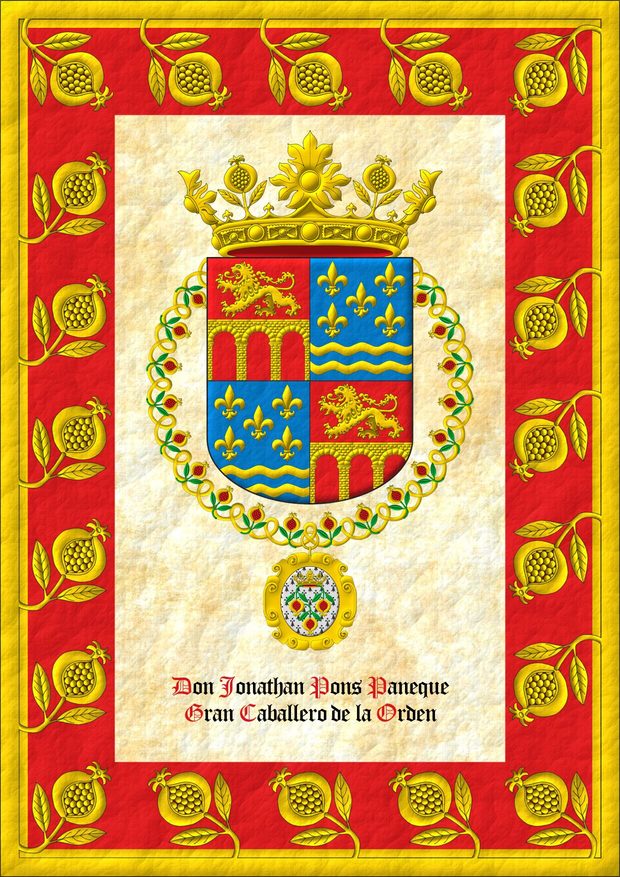
Quarterly: 1 and 4 Gules, a three arch bridge issuant from base and throughout Or; 2 and 3 Azure, five fleurs de lis, in base two bars wavy Or. Crest: A crown of the Sovereign and Most Noble Order of the Pomegranate. The shield is surrounded by the Grand Collar of the Sovereign and Most Noble Order of the Pomegranate.
This is his coat of arms of emblazoned by me for the Roll of Arms of the Sovereign and Most Noble Order of the Pomegranate.
Blazon keywords: Quarterly, Gules, One, Bridge, Issuant from base, Throughout, Or, Azure, Five, Fleur de lis, In base, Two, Fess, Wavy, Crest and mantling, Crown, Pomegranate, Surrounded and Grand collar.
Style keywords: Pointed, Outlined in sable, Illuminated and Leather.
Classification: Personal, Interpreted, Coat of arms, Armorial roll and Castilian language.
Bearer: Pons Paneque, Jonathan.


Leopold Nisnoni, page of armorial
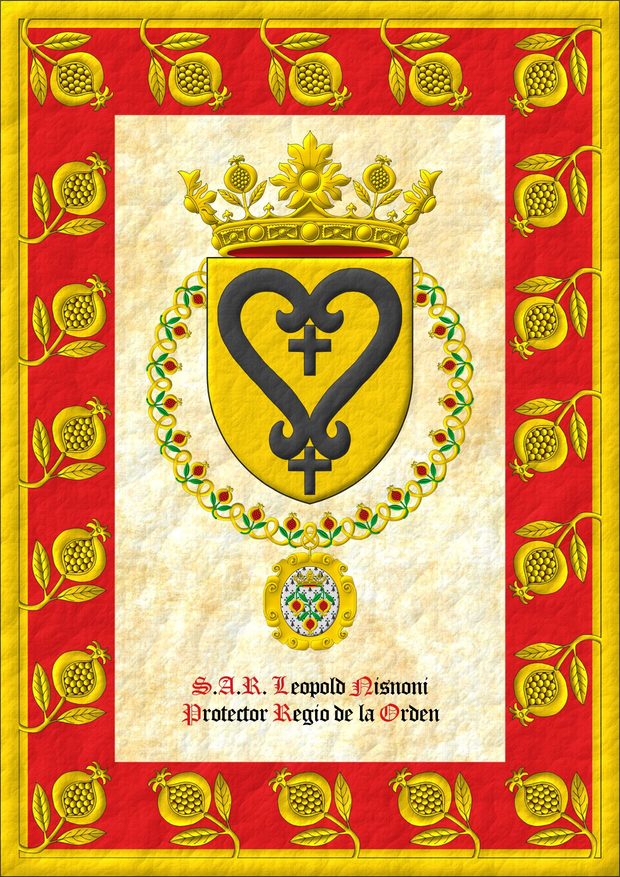
Or, the symbol of the Royal House of Kupang Sable. Crest: A crown of the Sovereign and Most Noble Order of the Pomegranate. The shield is surrounded by the Grand Collar of the Sovereign and Most Noble Order of the Pomegranate.
This is his coat of arms of emblazoned by me for the Roll of Arms of the Sovereign and Most Noble Order of the Pomegranate.
Blazon keywords: Without divisions, Or, One, Symbol, Sable, Crest and mantling, Crown, Pomegranate, Surrounded and Grand collar.
Style keywords: Pointed, Outlined in sable, Illuminated and Leather.
Classification: Civic, Interpreted, Coat of arms, Armorial roll and Castilian language.
Bearer: Kupang, Royal House of.


![Ver [Liñán y Eguizábal, J. de; 1911] en referencias bibliográficas. Libro abierto, hojas de plata, filo de oro, guardas de gules, tapas de sable.](../css/Libro.Bibliografia.png)
Liñán y Eguizábal, J. de; 1911
José de Liñán y Eguizábal, Count of Doña Marina, «Armorial of Aragon», printed by Establecimiento Tipográfico de L. Pérez, Huesca, 1911.
This book is part of a collection that also includes: «Heraldic Mottos» and «Heraldic Dictionary».
A facsimile edition exists, edited by Guillermo Redondo Veintemillas and Alberto Montaner Frutos, published by Institución Fernando el Católico, Zaragoza, 1994.
Bibliographical reference of century XX.
Classification: De bibliotheca, Armorial roll, Dictionary, In black and white and Castilian language.
Author: Liñán y Eguizábal, José de.
External resource:
Internal resources: LinanEguizabalJ1911.ArmorialDeAragon.Color.pdf PDF version scanned in color, although the book is in black and white, it looks more natural, LinanEguizabalJ1911.ArmorialDeAragon.BN.pdf PDF version scanned in black and white, it looks less natural and Facsimile edition in physical paper format.


Lorena Correa, page of armorial
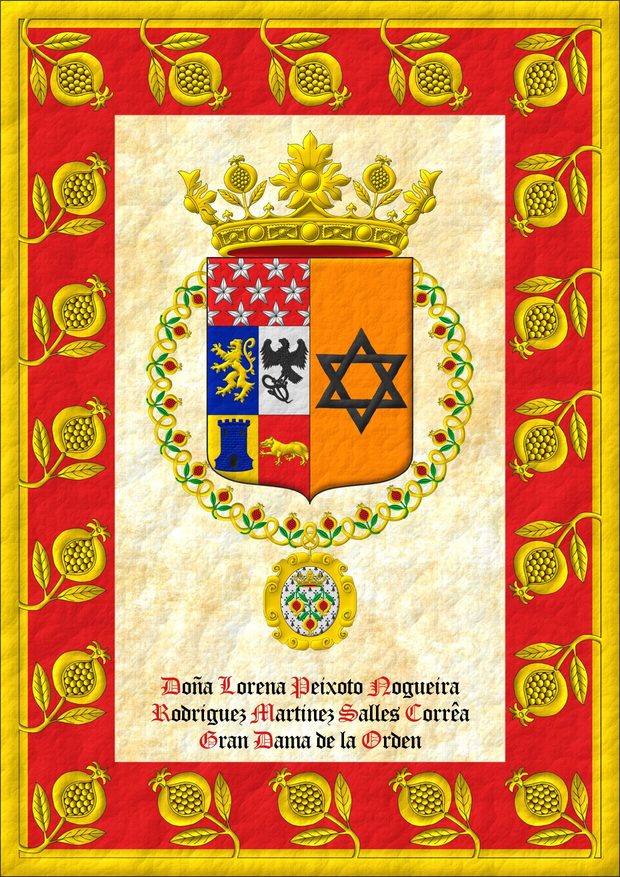
Party per pale: 1 quarterly: 1 Azure, a lion rampant Or, 2 Argent, a falcon rising, grasping in its paws a serpent Sable, 3 Or, a tower Azure, port, windows, and masoned Sable, 4 Gules, a fox passant Or, a chief Gules semé of mullets Argent; 2 Orange, a mullet of six points voided, interlaced Sable. Crest: A crown of the Sovereign and Most Noble Order of the Pomegranate. The shield is surrounded by the Grand Collar of the Sovereign and Most Noble Order of the Pomegranate.
This is her coat of arms of emblazoned by me for the Roll of Arms of the Sovereign and Most Noble Order of the Pomegranate.
Blazon keywords: Party per pale, Quarterly, Azure, One, Lion, Rampant, Or, Argent, Falcon, Rising, Grasping, Claw, Serpent, Sable, Tower, Port and windows, Masoned, Gules, Fox, Passant, Chief, Semé, Mullet, Five, Base (lower 1/3), Orange, Six, Voided, Interlaced, Crest and mantling, Crown, Pomegranate, Surrounded and Grand collar.
Style keywords: Ogee, Outlined in sable, Illuminated and Leather.
Classification: Personal, Interpreted, Coat of arms, Armorial roll and Castilian language.
Bearer: Correa, Lorena.


![Ver [Lutzelbourg, N. de; 1530] en referencias bibliográficas. Libro abierto, hojas de plata, filo de oro, guardas de gules, tapas de sable.](../css/Libro.Bibliografia.png)
Lutzelbourg, N. de; 1530
Nicolas de Lutzelbourg, lord of Fléville and captain of Nancy, «Roll of arms», sixteenth century (the author lived between 1485? and 1547), manuscript in French on parchment, with 230 pages numbered later with pencil the odd pages from 1 to 115, 29 x 21 cm, Bibliothèque-Médiathèque of Nancy digitized, source of the images with open license.
Video of 120 seconds composed for the Biblioteca Genealógica, Heráldica y Nobiliaria. Music by Georg Philipp Telemann (1681, 1767), Concerto for 4 Violins No. 2, TWV 40: 202, II. Grave, interpreted by Viola Viva, with Creative Commons license of Attribution and ShareAlike.
Content examples: Scotland on pages 28, 29 and 30 with 61 coat of arms; Aragon on page 33 with 11 coat of arms; Castile and Leon on page 35 with 8 coat of arms; Navarre on page 36 with 1 coat of arms; and Portugal on pages 37 and 38 with 27 coat of arms.
Bibliographical reference of century XVI.
Classification: Manuscript, Armorial roll, French language and In color.
Author: Lutzelbourg, Nicolas de.
Bibliographic reference mentioned in the following articles:
External resources:
- Manuscript's record in the Bibliothèque-Médiathèque of Nancy.
- Manuscript's pages in the Bibliothèque-Médiathèque of Nancy.


Malka Gittel Bas Reuven, page of armorial
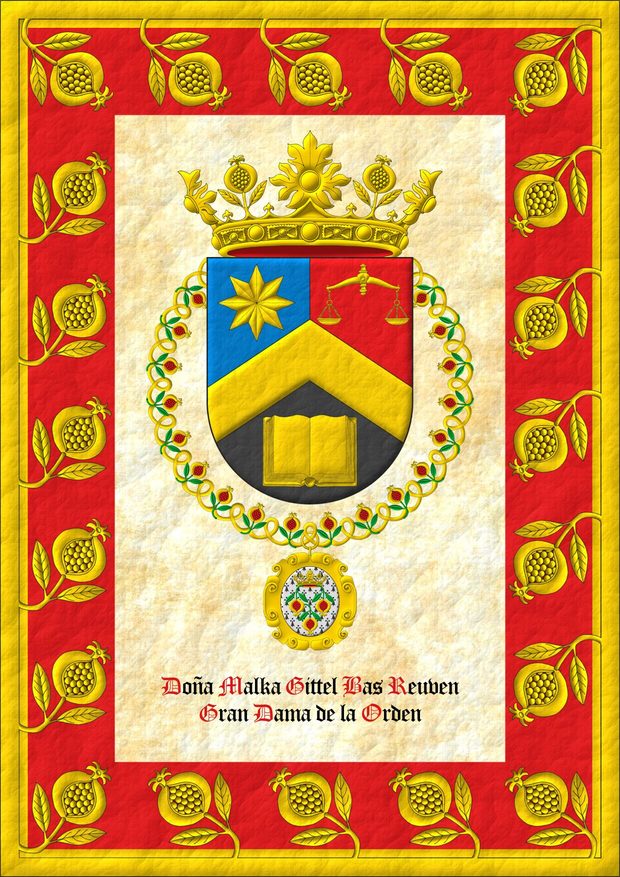
Tierced pallwise inverted Azure, Gules, and Sable; overall a chevron between, in the dexter of the chief, a mullet of six points, in the sinister of the chief a pair of scales, and in base an open book Or.
It has been painted by me, illuminated with lights and shadows, contoured in Sable, with a semi-circular outer contour and with a texturized finish.
Coat of arms of Her Excellency Ratu Muda Malka Bas Reuven emblazoned by me with for the Roll of Arms of the Soberana y Muy Noble Orden de la Granada.
Blazon keywords: Azure, Gules, Sable, Or, One, Six, Tierced pallwise inverted, Overall, Chevron, Between, Dexter, Chief, Mullet, Sinister, Pair of scales, In base, Open book, Book, Crown of the Sovereign and Most Noble Order of the Pomegranate, Crown, Surrounded and Collar.
Style keywords: Outlined in sable, Illuminated and Semi-circular.
Classification: Personal, Interpreted, Boa, Armorial roll and Castilian language.
Bearer: Gittel Bas Reuven, Malka.


Manuel Beninger, page of armorial
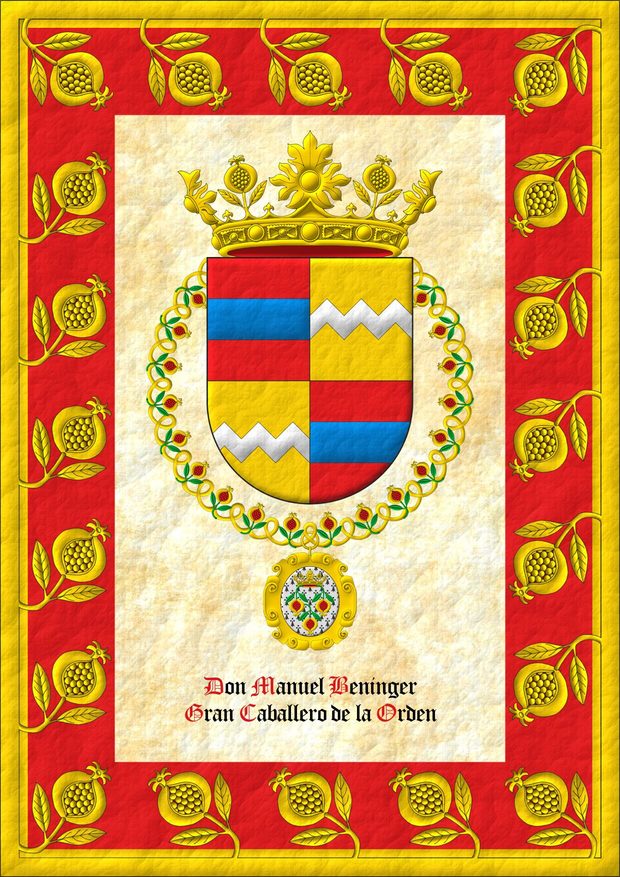
Quarterly: 1 and 4 Gules, a fess Azure; 2 and 3 Or, a fess dancetty Argent. Crest: A crown of the Sovereign and Most Noble Order of the Pomegranate. The shield is surrounded by the Grand Collar of the Sovereign and Most Noble Order of the Pomegranate.
This is his coat of arms of emblazoned by me for the Roll of Arms of the Sovereign and Most Noble Order of the Pomegranate.
Blazon keywords: Quarterly, Gules, One, Fess, Azure, Or, Dancetty, Argent, Crest and mantling, Crown, Pomegranate, Surrounded and Grand collar.
Style keywords: Colour on colour, Metal on metal, Semi-circular, Outlined in sable, Illuminated and Leather.
Classification: Personal, Interpreted, Coat of arms, Armorial roll and Castilian language.
Bearer: Beninger, Manuel.


Moritz Hunzinger, page of armorial
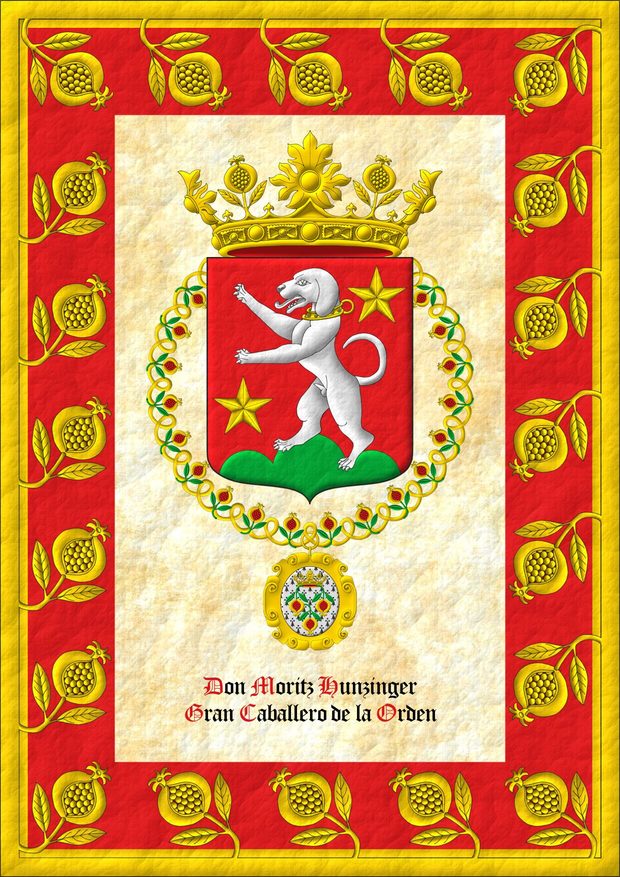
Gules, on a trimount issuant from the base Vert, a talbot rampant Argent, collared Or, between two mullets in bend sinister Or. Crest: A crown of the Soberana y Muy Noble Orden de la Granada. The shield is surrounded by the collar of the Sovereign and Most Noble Order of the Pomegranate.
It has been emblazoned by me, illuminated with lights and shadows, outlined in Sable, with an ogee external shape and with a texturized finishing.
This is the coat of arms of Moritz Hunzinger emblazoned by me for the Roll of Arms of the Soberana y Muy Noble Orden de la Granada.
Blazon keywords: Gules, Vert, Argent, Or, One, Three, Two, On, Trimount, Talbot, Rampant, Collared, Between, Mullet, In bend sinister, Crest, Crown of the Sovereign and Most Noble Order of the Pomegranate, Crown, Surrounded and Collar.
Style keywords: Outlined in sable, Illuminated and Ogee.
Classification: Personal, Interpreted, Boa, Armorial roll and Castilian language.
Bearer: Hunzinger, Moritz.


Nathaniel Bendel, page of armorial
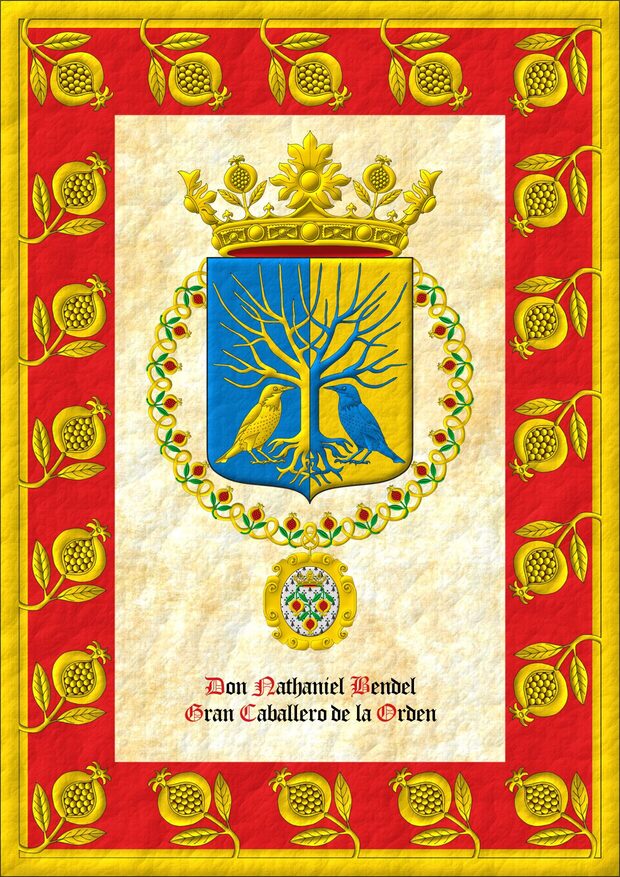
Party per pale Azure and Or, a tree eradicated and blasted between two starlings respectant all counterchanged. Crest: A crown of the Sovereign and Most Noble Order of the Pomegranate. The shield is surrounded by the Grand Collar of the Sovereign and Most Noble Order of the Pomegranate.
This is his coat of arms of emblazoned by me for the Roll of Arms of the Sovereign and Most Noble Order of the Pomegranate.
Blazon keywords: Party per pale, Azure, Or, One, Tree, Erased, Blasted, Counterchanged, Between, Two, Starling, Respectant, Counterchanged (side-by-side), Crest and mantling, Crown, Pomegranate, Surrounded and Grand collar.
Style keywords: Ogee, Outlined in sable and Leather.
Classification: Personal, Interpreted, Coat of arms, Armorial roll and Castilian language.
Bearer: Bendel, Nathaniel.


![Ver [Ortenburg; 1473] en referencias bibliográficas. Libro abierto, hojas de plata, filo de oro, guardas de gules, tapas de sable.](../css/Libro.Bibliografia.png)
Ortenburg; 1473
Anonymous, «Ortenburg Armorial», written and illuminated by various individuals in Bavaria, between 1466 and 1473.
This armorial likely contains coats of arms and flags of the «cuaterniones», groups of four, each representing different social groups within the Holy Roman Empire. It also illustrates the heraldic emblems of most Bavarian princes, nobles, territories, bishoprics, and prince-bishops. Although its execution is somewhat rudimentary, it remains a valuable resource on the heraldry of southern Germany in the late 15th century.
By 1534, the manuscript had passed into the hands of the Counts of Ortenburg, near Passau, where heraldic emblems of the Ortenburg family and their ancestors were added. It remained with the family until 1953, when it was sold to the Bavarian State Library, where it is now preserved.
Bibliographical reference of century XV.
Classification: Armorial roll, Manuscript, German language and In color.
Author: unknown.
External link:
Internal resources: Ortenburg1473.pdf Digital PDF version..


![Ver [Pérez de Vargas, J.; XVI] en referencias bibliográficas. Libro abierto, hojas de plata, filo de oro, guardas de gules, tapas de sable.](../css/Libro.Bibliografia.png)
Pérez de Vargas, J.; XVI
Juan Pérez de Vargas, «Nobiliario», 228 pages with 2 columns, index between pages 224 and 228 ordered by initial but unordered within each initial, 31 x 23 centímeters, kept in the National Library of Spain, signature Mss/3061, it is estimated from the XVI century.
Structure
It follows a fixed structure for each entry: the name of the lineage or person, a horizontal line of separation, a explanatory text, a horizontal line of separation, coat of arms with the with of the column and full-color, a horizontal final line. All of this within the columns, only coming out for some exterior decorations, which I especially like.
My collaboration with the National Library of Spain
I have collaborated with the Department of Manuscripts, Incunabula, and Rare Books of the National Library of Spain to correctly attribute the authorship of this 16th century manuscript armorial titled «Nobiliario», signature Mss/3061, to Juan Pérez de Vargas. It has been quite an honor.
Bibliographical reference of century XVI.
Classification: Manuscript, Armorial roll, In color and Castilian language.
The author is Pérez de Vargas, Juan.
External resources:
- Detail of this armorial in the National Library of Spain.
- Bibliographic record of the National Library of Spain.
- Scanned Armorial in the National Library of Spain.
Internal resources: Pages from 1 to 117 PerezDeVargasJXVI.11.Paginas.001.117.pdf and Pages from 118 to 235 PerezDeVargasJXVI.12.Paginas.118.235.pdf.
Credits: This book belongs to the Biblioteca Nacional de España. License Creative Commons CC-BY. You may share, transform and create from images in the public domain that are accessible in the Hispanic Digital Library.


Peter Ferdinand Gummersbach, page of armorial
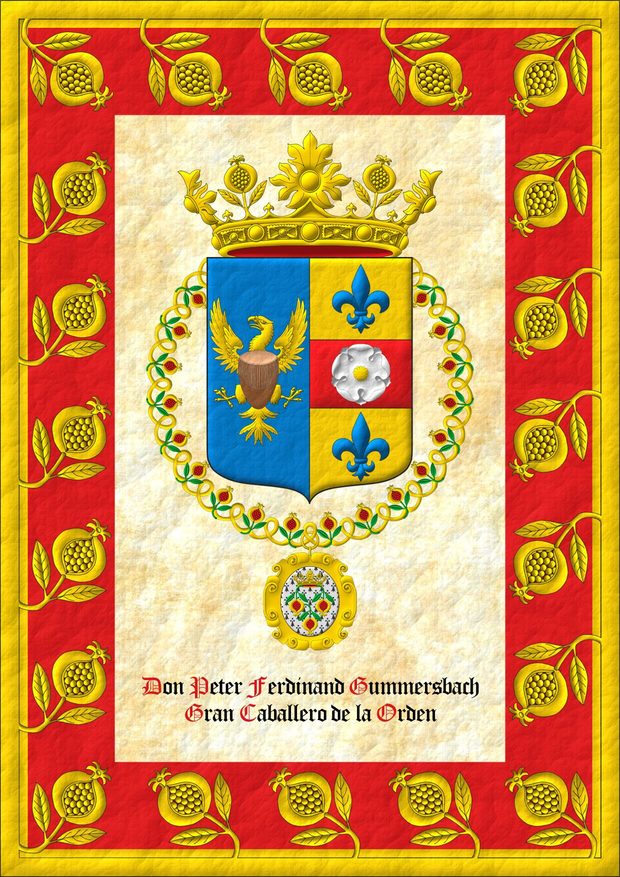
Party per pale: 1 Azure, an eagle displayed Or, charged on the chest with a Royal drum of Bunyoro-Kitara Kingdom proper; 2 Or, on a fess Gules between two fleur de lis Azure, a rose Argent, seeded Or. Crest: A crown of the Sovereign and Most Noble Order of the Pomegranate. The shield is surrounded by the Grand Collar of the Sovereign and Most Noble Order of the Pomegranate.
This is his coat of arms of emblazoned by me for the Roll of Arms of the Sovereign and Most Noble Order of the Pomegranate.
Blazon keywords: Party per pale, Azure, One, Eagle, Or, Charged, Chest, Drum, Royal, Proper, Fess, Gules, Rose, Argent, Seeded, Between, Two, Fleur de lis, In chief, In base, Crest and mantling, Crown, Pomegranate, Surrounded and Grand collar.
Style keywords: Ogee, Outlined in sable, Illuminated and Leather.
Classification: Personal, Interpreted, Coat of arms, Armorial roll and Castilian language.
Bearer: Gummersbach, Peter Ferdinand.


![Ver [Raber, V.; 1548] en referencias bibliográficas. Libro abierto, hojas de plata, filo de oro, guardas de gules, tapas de sable.](../css/Libro.Bibliografia.png)
Raber, V.; 1548
Vigil Raber, «Armorial con 7244 escudos de armas», 903 pages of content, almost all color pages, 7244 coat of arms, 30 x 21 centimeters, at the Herzogin Anna Amalia Library, shelf code Fol 220, permanent identifier 1249054540, 1548.
Bibliographical reference of century XVI.
Classification: Armorial roll, Manuscript, In color and German language.
Author: Raber, Vigil.
External links:
- Record in the Herzogin Anna Amalia Library.
- Content in the Herzogin Anna Amalia Library.
- Content in the Bilder Server.


![Ver [Rodríguez de la Vega, A.; XVI] en referencias bibliográficas. Libro abierto, hojas de plata, filo de oro, guardas de gules, tapas de sable.](../css/Libro.Bibliografia.png)
Rodríguez de la Vega, A.; XVI
Alonso Rodríguez de la Vega, «Roll of arms of Spain», 377 hand-numbered pages in Arabic numerals, all coat of arms illustrations are only partially outlined and without tinctures, written according to the title page in the time of Emperor Charles V, in the National Library of Spain, signatures Mss/3330, it is estimated from the XVI century.
Bibliographical reference of century XVI.
Classification: Manuscript, Armorial roll, In black and white and Castilian language.
The author is Rodríguez de la Vega, Alonso.
External resources:
- Detail of this armorial in the National Library of Spain.
- Bibliographic record of the National Library of Spain.
- Scanned Armorial in the National Library of Spain.
Internal resources: RodriguezDeLaVegaAXVI.11.Paginas.001.129, RodriguezDeLaVegaAXVI.12.Paginas.130.258.pdf and RodriguezDeLaVegaAXVI.13.Paginas.259.387.pdf.
Credits: This book belongs to the Biblioteca Nacional de España. License Creative Commons CC-BY. You may share, transform and create from images in the public domain that are accessible in the Hispanic Digital Library.


Rubén Arjona Berrocal, page of armorial
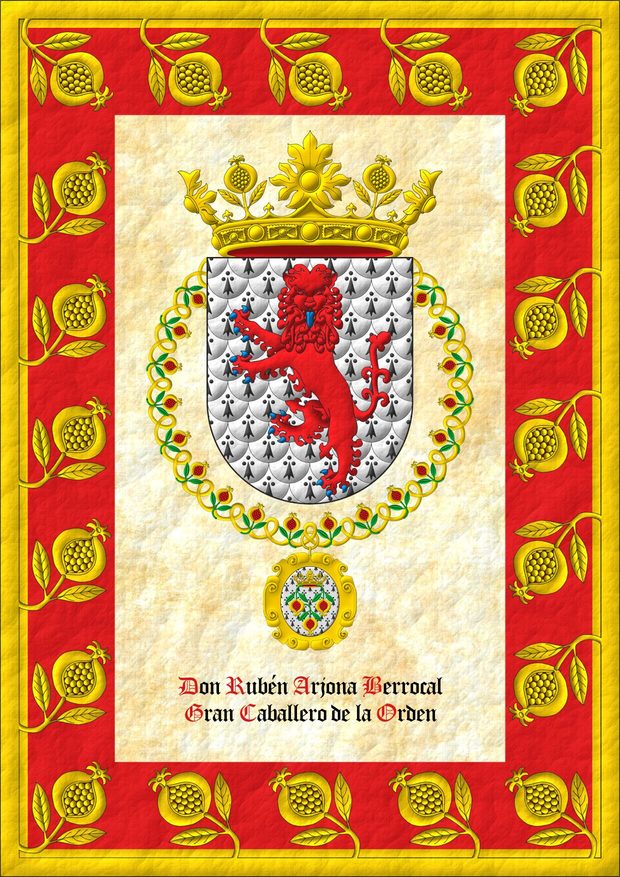
Ermine papelonny, a lion rampant guardant Gules, armed and langued Azure. Crest: A crown of the Sovereign and Most Noble Order of the Pomegranate. The shield is surrounded by the Grand Collar of the Sovereign and Most Noble Order of the Pomegranate.
This is his coat of arms of emblazoned by me for the Roll of Arms of the Sovereign and Most Noble Order of the Pomegranate.
Blazon keywords: Without divisions, Ermine, Papelonny, One, Lion rampant guardant, Gules, Armed, Langued, Azure, Crest and mantling, Crown, Pomegranate, Surrounded and Grand collar.
Style keywords: Semi-circular, Outlined in sable, Illuminated and Leather.
Classification: Personal, Interpreted, Coat of arms, Armorial roll and Castilian language.
Bearer: Arjona Berrocal, Rubén.


Rubén González Lara, page of armorial
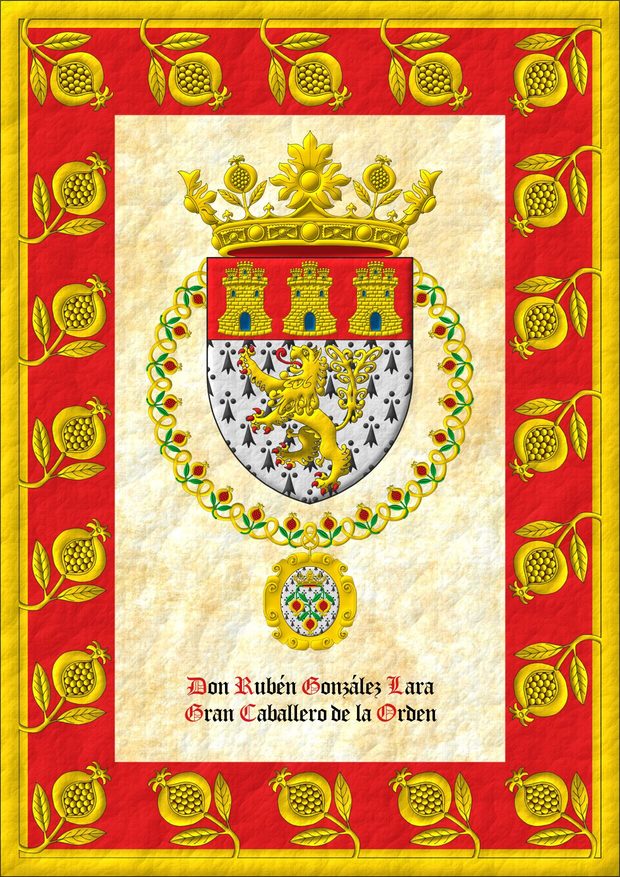
Ermine, a lion rampant double queued Or, armed and langued Gules; a chief Gules, three castles triple-towered Or, port and windows Azure, masoned Sable. Crest: A crown of the Sovereign and Most Noble Order of the Pomegranate. The shield is surrounded by the Grand Collar of the Sovereign and Most Noble Order of the Pomegranate.
This is his coat of arms of emblazoned by me for the Roll of Arms of the Sovereign and Most Noble Order of the Pomegranate.
Blazon keywords: Without divisions, Ermine, One, Lion, Rampant, Tail, Double queued, Or, Armed, Langued, Gules, Chief, Three, Castle, Port and windows, Azure, Masoned, Sable, Crest and mantling, Crown, Pomegranate, Surrounded and Grand collar.
Style keywords: Pointed, Outlined in sable, Illuminated and Leather.
Classification: Personal, Interpreted, Coat of arms, Armorial roll and Castilian language.
Bearer: González Lara, Rubén.


Rui Jorge Vaz, The Armorial Register
Registered by The International Register of Arms, 16th December 2024, Registration number 0712, Volume 4.
Category: Armorial roll.
External link:
Root: The Armorial Register.


![Ver [Salazar y Mendoza, M. de; 1640] en referencias bibliográficas. Libro abierto, hojas de plata, filo de oro, guardas de gules, tapas de sable.](../css/Libro.Bibliografia.png)
Salazar y Mendoza, M. de; 1640
Miguel de Salazar y Mendoza, chronicler and chaplain of honor to Philip IV, «Formulario de armas», copied by Manuel Antonio Brochero in 1730, manuscript in the National Library of Spain, 11 volumes, volume 1 with 876 pages, call number MSS/11442, volume 2 with 378 pages, call number MSS/11443, volume 3 with 455 pages, call number MSS/11444, volume 4 with 392 pages, call number MSS/11445, volume 5 with 543 pages, call number MSS/11446, volume 6 with 455 pages, call number MSS/11447, volume 7 with 484 pages, call number MSS/11448, volume 8 with 309 pages, call number MSS/11449, volume 9 with 325 pages, call number MSS/11450, volume 10 with 302 pages, call number MSS/11451, volume 11 with 467 pages, call number MSS/11452, totaling approximately 5986 pages, 31 x 21 centimeters, circa 1640.
Dates of the original and copies
In Una Modesta Aportación Española, Juan Cartaya Baños writes that the original «Formulario de Armería» by Miguel de Salazar y Mendoza can be dated to around 1640, and that is the year I use to catalog it. He mentions that there is a 1739 copy that belonged to the King of Arms Zazo y Rosillo. In the National Library of Spain, there are three copies: this copy made by Manuel Antonio Brochero, titled «Formulario de Armería», in 11 volumes, dated by the BNE to the year 1730; another smaller copy made by Tomás Francisco Monleón y Ramiro, titled «Nobiliario o Formulario de Armería», with 980 pages, dated by the BNE to the year 1739; and another even smaller copy, titled «Formulario de Armería», with 404 pages, dated by the BNE to the 18th century.
Indexes and searches
There are indexes in all the volumes, these indexes are alphabetically ordered by the initial letter of the lineage name, but within each letter, the lineages are not strictly ordered, that is, they attempt to follow the order but there are some discrepancies, so you have to go through the entire letter to find the sought lineage. Next to the lineage name on the right, a number appears to locate it within that volume. Therefore, to ensure a thorough search, you need to review the indexes of all 11 volumes. For example, the Salazar lineage can be found in volume 1, in volume 2, in volume 4, etc. This mechanism, though somewhat challenging, allows for searches.
In the 2 images above, which are at the beginning of this section, you can see an example of a search, first, a page from the index of volume 3, dedicated to the letter S, where at the beginning of its second column, you can see the name of the Salmerón lineage, with the number 313 to its right. In the second image, you can see, from volume 3, the page with the number 313 at the top left, with the coat of arms of the Salmerón lineage described but not painted, which is similar to the one that appears in [Salazar y Mendoza, M. de; 1654; volume 5, page 196].
Coat of arms drawings
This armorial contains in volume 1, after the index, an introduction to the organization of coats of arms in quarters, spanning 12 pages and 7 black and white drawings.
Among the lineage descriptions, blank spaces are left, seemingly intended for drawing the coat of arms, many of these spaces are only outlined with the outer edge of a shield ending in a semicircular arch. The most complete coats of arms are those smaller ones that illustrate some lineages in black and white, mainly in the margins, as shown in the previous images. The spaces seem to be more systematically placed in the first volumes, with an average of 2 spaces per page, than in the later volumes.
Bibliographical reference of century XVII.
Classification: Manuscript, Armorial roll, Castilian language and In black and white.
Author: Salazar y Mendoza, Miguel de.
The following article cites this bibliographic reference:
External resources:
- National Library of Spain, Formulario de Armeria, 11 volumes, copy from 1730.
- National Library of Spain, Nobiliario o Formulario de Armeria, 980 pages, copy from 1739.
- National Library of Spain, Formulario de Armeria, 404 pages, copy from the 18th century.
Internal resources: SalazarMendozaM1640.Tomo.01.pdf volume 1 in PDF format, SalazarMendozaM1640.Tomo.02.pdf volume 2 in PDF format, SalazarMendozaM1640.Tomo.03.pdf volume 3 in PDF format, SalazarMendozaM1640.Tomo.04.pdf volume 4 in PDF format, SalazarMendozaM1640.Tomo.05.pdf volume 5 in PDF format, SalazarMendozaM1640.Tomo.06.pdf volume 6 in PDF format, SalazarMendozaM1640.Tomo.07.pdf volume 7 in PDF format, SalazarMendozaM1640.Tomo.08.pdf volume 8 in PDF format, SalazarMendozaM1640.Tomo.09.pdf volume 9 in PDF format, SalazarMendozaM1640.Tomo.10.pdf volume 10 in PDF format and SalazarMendozaM1640.Tomo.11.pdf volume 11 in PDF format.


![Ver [Salazar y Mendoza, M. de; 1654] en referencias bibliográficas. Libro abierto, hojas de plata, filo de oro, guardas de gules, tapas de sable.](../css/Libro.Bibliografia.png)
Salazar y Mendoza, M. de; 1654
Miguel de Salazar y Mendoza, chronicler and chaplain of honor to Philip IV, «Nobiliario de armas», with contributions from Lázaro Díez del Valle and others, manuscript in the National Library of Spain, 7 volumes, volume 1 with 1084 pages, call number MSS/12599, volume 2 with 926 pages, call number MSS/12600, volume 3 with 762 pages, call number MSS/12601, volume 4 with 614 pages, call number MSS/12602, volume 5 with 784 pages, call number MSS/12603, volume 6 with 1106 pages, call number MSS/12604, and volume 7 with 998 pages, call number MSS/12605, total approximately 6274 pages, 22 x 16 centimeters, by various authors with handwriting from different hands, 1654.
Dates and years
In volume 1, page 66, the year 1498 appears first, there are many years written on many pages, often related to events or positions held by the bearers of the described coats of arms. These are years from the 14th century onward. In the different volumes, there are also, though much less frequently, some dates with day, month, and year.
It is notable that, on that same page 66 of volume 1, on the last written line on the right, there appears what seems to be a signature, followed by the preposition «a» which is used in a formal sense to indicate the date on which a document is drafted or signed, and a specific date. It can be seen in the first image at the beginning of this section where « = Silva y Salazar. a 27 de abril de 1654 = » is highlighted in larger and darker font. However, only the second surname in «Silva y Salazar» matches that of the author «Miguel de Salazar y Mendoza», so it would be the signature of a different person or possibly a relative who worked for the author.
As I have mentioned, throughout this volume and the entire armorial, there are other years, generally earlier and some later than 1654. For example, in the 17th century, and specifically in this volume 1, on page 222, midway down on the right, the years 1697 and 1698 appear; on page 334, at the bottom right, I believe the year 1644 can be seen; on page 343, at the bottom right, the year 1638 appears.
To establish a reference year, I set it as 1654, only to have a temporal reference, even though this date appears signed by someone other than the author, on a note of paper smaller in size than the rest of the pages, this note talks about Ariño and is inserted just before the page dedicated to the coat of arms of the Ariño lineage. In any case, as can be observed and given the large number of pages, its writing must have extended over decades, and by several hands and authors, hence the appearance of later annotations such as 1697 and 1698.
The National Library of Spain dates it between 1601 and 1800, which is a very broad range of years.
Miguel de Salazar y Mendoza, was a chronicler and chaplain of honor to Philip IV who reigned from 1621 to 1665, he was the author of the «Formulario de Armeria» which some date to circa 1640, and of which there is a copy from 1739 that belonged to the King of Arms Zazo y Rosillo, also in the National Library of Spain.
Indexes and searches
There is a deteriorated index of all volumes at the beginning of volume 1, this index is alphabetically ordered by the initial letter of the lineage, but within each letter, the lineages are not strictly ordered, so one must read through the entire letter to find the sought lineage. Within each letter, there is an organization by volumes from 1 to 7, next to the name of the lineage on the right appears a number, and with that volume and number, the written coat of arms can be located. This mechanism, with some difficulty, allows for searches.
For example, in the 2 previous images, which are at the beginning of this section, you can see, first, a page from the index which is one of the pages dedicated to the letter S, in its section dedicated to volume 5, at the end of the 3rd column, you can see the name of the Salmerón lineage, with the number 196 to its right. In the second image, you can see, from volume 5, the page with the number 196 at the top right, with the coat of arms of the Salmerón lineage described, but not painted, and is similar to the description in [Salazar y Mendoza, M. de; 1640; volume 3, page 313].
Drawings of coats of arms
This armorial contains, in the first 43% of volume 1, coats of arms with a crest, helmet, mantling, and plume, in the final 57% of volume 1 and in the rest of the volumes from 2 to 7, only the coats of arms without a crest.
The drawn coats of arms are always finished with a rounded arch. The coats of arms without a crest are always in a vertical position. The coats of arms with a crest are tilted toward the dexter (heraldic right), which is the left from the observer’s point of view, and both the coat of arms and the helmet, the mantling, and the plume, these arms with its crest are pre-printed, for this, 2 different plates were used, which can be distinguished because one has a plume of 4 feathers and the other has a plume of 5 feathers, as can be seen in the 2 first images before this section.
The external shape of the arms without a crest and the interior of all the coat of arms arms in this armorial, are drawn in pen. As illustrated in the third image before this section: most of the coats of arms drawings are blank; some are only sketched; others have incomplete quarters; and some are more advanced; but none have tinctures. Only the tree in the Aznar lineage coat of arms in volume 1, page 66, is painted in vert (green), so I categorize this armorial as created in black and white. At the beginning of volume 1, it is noteworthy that among the initiated arms, there frequently appears a tree as the main charge.
Bibliographical reference of century XVII.
Classification: Manuscript, Armorial roll, Castilian language and In black and white.
The author is Salazar y Mendoza, Miguel de.
Bibliographical reference mentioned in the following article:
External resource:
Internal resources: 7 volumes in PDF format. SalazarMendozaM1654.Tomo.1.pdf tomo 1 in PDF format, SalazarMendozaM1654.Tomo.2.pdf tomo 2 in PDF format, SalazarMendozaM1654.Tomo.3.pdf tomo 3 in PDF format, SalazarMendozaM1654.Tomo.4.pdf tomo 4 in PDF format, SalazarMendozaM1654.Tomo.5.pdf tomo 5 in PDF format, SalazarMendozaM1654.Tomo.6.pdf tomo 6 in PDF format and SalazarMendozaM1654.Tomo.7.pdf tomo 7 in PDF format.


![Ver [Salmerón Cabañas, A.; 2024b] en referencias bibliográficas. Libro abierto, hojas de plata, filo de oro, guardas de gules, tapas de sable.](../css/Libro.Bibliografia.png)
Salmerón Cabañas, A.; 2024b
Antonio Salmerón Cabañas, «Interpretation of Six Family Coats of Arms from the Southern Indies Granted between 1538 and 1540», with the original coats of arms from the armorial grants, illustrated shields and step-by-step explanations of the interpretation process following the rules of heraldry, published by Ediciones aContracorriente, aFondo Collection, legal deposit M-23997-2024, ISBN 978-84-941511-7-0, Madrid, 2024.
Contents
- Prologue: Six coats of arms, page 9.
- Peru: New Castile, page 11.
- Geometry: Classical, page 13.
- Blazon i: Alonso Sánchez, conquistador in the province of Peru, coat of arms granted in 1538, page 19.
- Blazon ii: Juan de Argüello, alderman of Popayán and conquistador in Quito, coat of arms granted in 1538, page 29.
- Blazon iii: Juan Barbarán, commander and lieutenant of Pizarro, coat of arms granted in 1539, page 41.
- Blazon iv: Cristóbal Bernal, for his services aiding Pizarro, coat of arms granted in 1539, page 49.
- Blazon v: Diego Rodríguez de Figueroa, conquistador and pacifier of Cuzco, coat of arms granted in 1540, page 57.
- Blazon vi: Baltasar García, pacifier of Puerto Viejo in Peru, coat of arms granted in 1540, page 65.
- Appendix i: Bibliography, page 77.
- Appendix ii: Illustrations, page 83.
- Appendix iii: Vocabulary, page 93.
Bibliographical reference of century XXI.
Classification: Armorial roll, In color and Castilian language.
Author: Salmerón Cabañas, Antonio.
The following article cites this bibliographic reference:
Internal resources: IndiasCyA.20241108.pdf PDF Format and Physical book on paper.


Sovereign and Most Noble Order of the Pomegranate, page of armorial
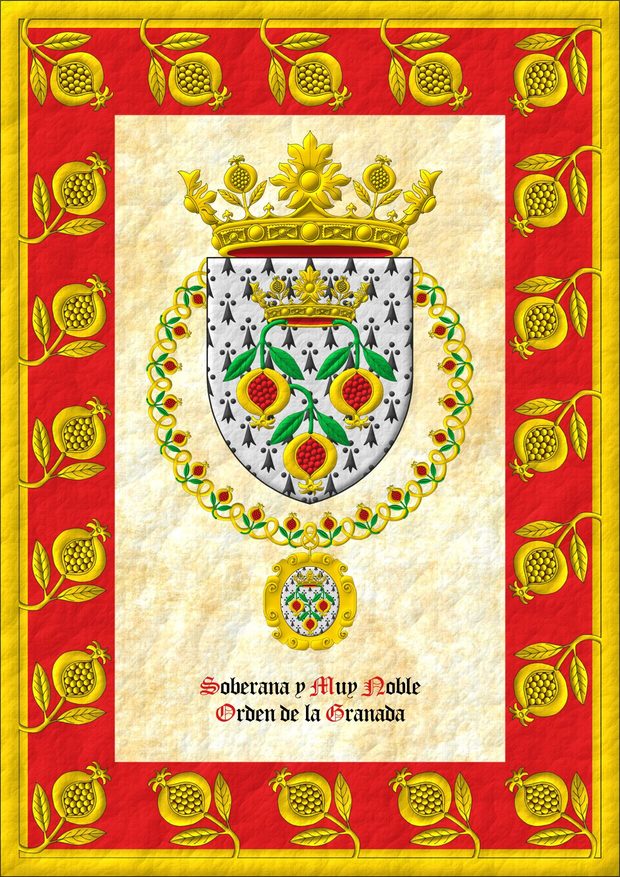
Ermine, three pomegranates inverted Or, seeded Gules, slipped and leaved Vert, ensigned with an open crown, alternating four rosettes of acanthus leaves, visible three, and four pomegranates Or, visible two, lined Gules. Crest: A crown of the Sovereign and Most Noble Order of the Pomegranate. The shield is surrounded by the Grand Collar of the Sovereign and Most Noble Order of the Pomegranate.
Blazon keywords: Without divisions, Ermine, Three, Pomegranate, Reversed, Or, Seeded (pomegranate), Gules, Slipped, Leaved, Vert, On, One, Crown, Alternately, Four, Rosette of acanthus leaves, Visible, Two, Lined, Crest and mantling, Surrounded and Grand collar.
Style keywords: Outlined in sable, Leather and Pointed.
Classification: Socioeconomic, Interpreted, Coat of arms, Armorial roll and Castilian language.
Bearer: Granada, Soberana y Muy Noble Orden de la.


![Ver [St. Gallen; 1480] en referencias bibliográficas. Libro abierto, hojas de plata, filo de oro, guardas de gules, tapas de sable.](../css/Libro.Bibliografia.png)
St. Gallen; 1480
Anonymous, «Wappenbuch des St. Galler Abtes Ulrich Rösch», 338 pages, 1626 coats of arms, from the Abbey Library of Saint Gall, catalog number Codex Sang. 1084, with Sang as the abbreviation for Sancti Galli, circa 1480.
This manuscript contains coats of arms of prominent figures from both laity and clergy, primarily from the southern regions of Germany. It was likely prepared in the Heidelberg workshop of Hans Ingeram for an unknown patron from the area between the Neckar River and the Upper Rhine. In the 1480s, St. Gall Abbot Ulrich Rösch acquired the volume and commissioned additional coats of arms from Swiss and German border areas to be included in the back pages, drawn by the Winterthur artist Hans Haggenberg, 1471-1511 [Clemmensen, S.; 2012; pages 3 and 4].
Bibliographical reference of century XV.
Classification: Armorial roll, Manuscript and In color.
Author: unknown.
Bibliographical reference mentioned in the following article:
External link:
Internal resources: Collection of 392 images, of which 367 are coats of arms..


![Ver [St. George's Roll; 1285] en referencias bibliográficas. Libro abierto, hojas de plata, filo de oro, guardas de gules, tapas de sable.](../css/Libro.Bibliografia.png)
St. George's Roll; 1285
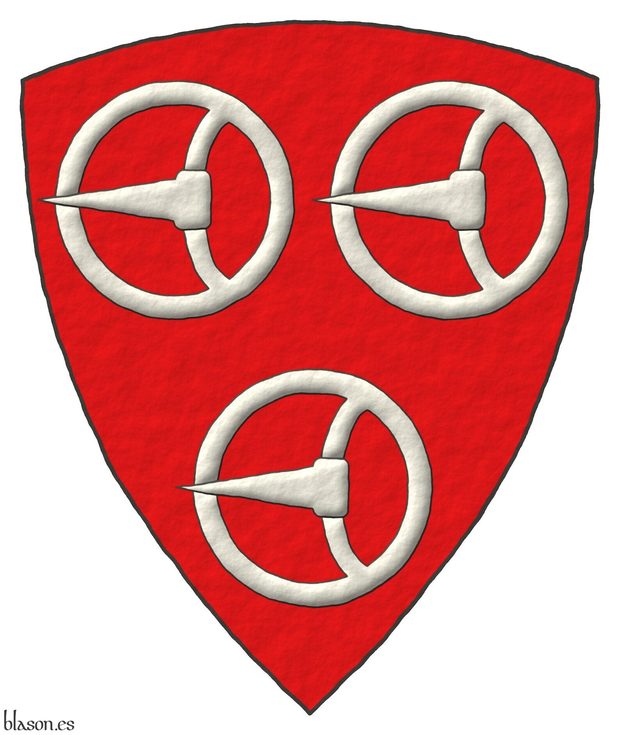
St. George's Roll, in English usually written as «MS Vincent, 164 ff.1-21b», also called [Vincent, MS; 1285], it is in the College of Arms, London, containing 677 painted coats of arms, it is an English roll or arms dating from c. 1285.
The bibliographical reference that I mainly use for this armorial is [Vincent, MS; 1285].
Bibliographical reference of century XIII.
Classification: Armorial roll and Manuscript.
Author: anonymous.
The following articles cite this bibliographic reference:
- Adam de Cretingges
- Bartholomew de Yattendon
- Brian Timms
- Edmund de Bassingburnn
- Howel ap Res
- James de Sottone, le Fitz
- Joan de Okinton
- John de Beauchamp
- John de Ladbrooke
- John le Sturmy
- Nicholas Malmains
- Norman Darcy
- Ricardo de Mandeville
- Robert de Malet
- Simon de Crombe
- Simon de Ver
- Simon le FizSimon
- Thomas Roscelyn
- Thomas de Werblintone
- Thomas le FizThomas
- Vincent, MS; 1285
- Warbrentone, Thomas de
- William Bardolf
- William de Ferrers, Earl of Derby
- William de Hondeshacre


![Ver [Stodart, R. R.; 1881] en referencias bibliográficas. Libro abierto, hojas de plata, filo de oro, guardas de gules, tapas de sable.](../css/Libro.Bibliografia.png)
Stodart, R. R.; 1881
Robert Riddle Stodart, «Scottish Arms: Being a Collection of Armorial Bearings, A.D. 1370-1678», Reproduced in facsimile from contemporary manuscripts with heraldic and genealogical notes, edited by William Paterson, Edinburgh, 1881.
This work is a comprehensive two-volume set that reproduces armorial bearings from various manuscripts dating from 1370 to 1678. The collection includes detailed heraldic and genealogical notes that accompany the facsimiles. It is an essential reference for anyone studying Scottish heraldry and genealogy.
Volume 1
Volume 1 contains an introduction, an alphabetical index of coats of arms, and 125 color plates, each displaying between 1 and 9 coats of arms per plate. This volume 1 is dedicated to the color illustrations of the coats of arms, while volume 2 consists entirely of text without illustrations. In volume 1, the Plates section with color illustrations of coats of arms follows the same structure as volume 2, as will be seen in the section dedicated to volume 2. The contents of volume 1 are as follows.
- Introduction.
- Index to the plates.
- List of names in the order in which they occur on the plates.
-
Plates:
- Armorial de Gelre, pages A to E.
- Armorial de Berry, pages I to II.
- Forman's Roll, pages 12 to 21.
- Sunderland Hall Ms., pages 22 to 24.
- Additions to Sir David Lindsay's Ms., pages 24^ to 34.
- Workman's Ms, pages 35 to 84.
- Kings' and Nobility's arms, pages 85 and 86.
- Sir David Lindsay the Youngers Ms, pages 87 to 94.
- Sir James Balfour's Ms, pages 95 and 96.
- Lyon register, pages 97 and 98.
- Earl of Crawford's Ms., pages 99 and 100.
- Gentlemen's arms, pages 101 to 106.
- Funeral escutcheons, pages 106 to 110.
- Sundries, pages 111 to 118.
- Heraldic and genealogical notes.
- Index to the notes.
- Additions and corrections.
Volume 2
Volume 2 continues the collection and includes further armorial bearings and notes and also references several historical armorials, with the following contents:
- I. The armorial de Gelre, circa 1369.
- II. The armorial de Gilles le Bouvier, Berry Roi d'Armes, circa 1450-55.
- III. Roll of arms, by sir Robert Forman, Lyon King of Arms, circa 1562.
- IV. Sunderland Hall manuscript.
- V. Additions to the booke and register of armes, compiled by sir David Lindsay, Lyon King of Arms.
- VI. Illuminated heraldic manuscript, called "Workman's," circa 1565-6.
- VII. Kings' and nobility's arms, circa 1566.
- VIII. Illuminated manuscript, circa 1603-5, ascribed to sir David Lindsay, Lyon King of Arms.
- IX. Armorial manuscripts by sir James Balfour, Baronet, Lyon King at Arms 1630-54, and another herald.
- X. The public register of all arms and bearings in Scotland, A.D. 1672-78.
- XI. Heraldic manuscript compiled during the reign of James VI, the property of the Earl of Crawford and Balcarres.
- XII. Gentlemen's arms collected during the reign of Charles I.
- XIII. Funeral escutcheons.
- XIV. Sundries.
Bibliographical reference of century XIX.
Classification: Armorial roll, English language and Black and white with color plates.
The author is Stodart, Robert Riddle.
External resources:
Internal resources: StodartR1881.ScottishArms.Heavy.Volume.01.pdf Heavy PDF, StodartR1881.ScottishArms.Heavy.Volume.02.pdf Heavy PDF, StodartR1881.ScottishArms.Light.Volume.01.pdf Light PDF and StodartR1881.ScottishArms.Light.Volume.02.pdf Light PDF.


![Ver [Ströhl, H. G.; 1891] en referencias bibliográficas. Libro abierto, hojas de plata, filo de oro, guardas de gules, tapas de sable.](../css/Libro.Bibliografia.png)
Ströhl, H. G.; 1891
Hugo Gerard Ströhl, «Die Wappen der Buchgewerbe», published by Anton Schroll & Co., 36 pages with black and white illustrations, plus 1 title page, 9 color plates, and 1 additional color plate, Vienna, 1891.
This book is a notable work in the field of heraldry, specifically focusing on the coats of arms related to the book trade industries. Ströhl, a renowned heraldic artist, created detailed illustrations that highlight the symbolism and artistic elements of these armorial bearings. The publication includes a combination of black and white illustrations alongside vivid color plates that showcase the vibrancy of heraldic art in the late 19th century.
Hugo Gerard Ströhl was born on September 24, 1851, in Wels, Austria, and passed away on December 7, 1919, in Mödling, Austria. His works remain influential in the study and appreciation of heraldic art.
Bibliographical reference of century XIX.
Classification: Armorial roll, German language and Black and white with color plates.
Author: Ströhl, Hugo Gerard.
External resources:
- Heraldry of the World, Biography of Hugo Gerard Ströhl.
- Payhip download of the book.
- Information about the book at Rice University Library.
Internal resources: Strohl1891.DieWappenDerBuchgewerbe.pdf in PDF format.


![Ver [Takamiya; 1620] en referencias bibliográficas. Libro abierto, hojas de plata, filo de oro, guardas de gules, tapas de sable.](../css/Libro.Bibliografia.png)
Takamiya; 1620
Anonymous, «Heraldic manuscript of the English kings and peers», Beinecke Rare Book and Manuscript Library, call number Takamiya MS 13, 236 pages, actually 235 due to a pagination error, manuscript on paper in English secretary hand, circa 1620.
Contents
Created circa 1620, this manuscript presents a genealogy of the rulers of England from Brutus and Julius Caesar to James I, including short biographies and more than 600 emblazoned coats of arms in full color. The manuscript spans 236, actually 235 pages, with a pagination error skipping page 182.
Binding
The manuscript is bound in nineteenth-century full polished calf by Clarke & Bedford, with a spine title «Arms of the Nobility of England. MS. 1042-1619». It includes four modern binder's blanks at the front and thirteen at the end.
Provenance
The manuscript originates from England and was part of the Toshiyuki Takamiya collection until 2013. It is classified as a Renaissance manuscript from the 17th century and is a significant resource for the study of English heraldry, genealogy, and nobility.
Bibliographical reference of century XVII.
Classification: Armorial roll, Manuscript, English language and In color.
The author is unknown.
External resource:
Internal resources: Takamiya1620.pdf Yale University Library Digital Collections, PDF format.


![Ver [Tewkesbury; Century XVII] en referencias bibliográficas. Libro abierto, hojas de plata, filo de oro, guardas de gules, tapas de sable.](../css/Libro.Bibliografia.png)
Tewkesbury; Century XVII
Anonymous, «Founder's and benefactors' book of Tewkesbury abbey», Bodleian Libraries, University of Oxford, call number MS. Top. Glouc. d. 2, recorded in the Catalogue of Western Medieval Manuscripts in Oxford Libraries, manuscript, illustrated, 46 leaves, 245 x 175 millimeters, except fols. 12, 16, and 38, which are smaller, Tewkesbury, beginning of the 16th century.
Origin, historical context, and contents
It is is a medieval manuscript originating from Tewkesbury Abbey at the beginning of the 16th century. This Latin manuscript provides records and depictions of the abbey's founders and benefactors, such as: William Fitzcount, 2nd Earl of Gloucester, died 1183; Oddo and Doddo, Dukes of Mercia; Hugh, great Duke of Mercia, lord of the manor of Tewkesbury, buried at Tewkesbury in 812; Robert Fitzhamon, lord of Creully, Calvados in Normandy, died 1107, and his wife, Sybil, patrons of Tewkesbury Abbey’s reconstruction; Edward Despenser, died 1375; Thomas Despenser, Earl of Gloucester, died 1400; and Isabel Despenser, 1400-1439.
Illustrations and manuscript details
The manuscript is noted for its illustrations, which are believed to have been created by John of Evesham, a monk at Tewkesbury. The illustrations are thought to be copied from painted statues, approximately 70 cm high, which once decorated the abbey church. The manuscript comprises 46 leaves, with most pages measuring 245 x 175 millimeters, though folios 12, 16, and 38 are smaller in size.
In the image, folio 25v depicts Thomas Despenser, Earl of Gloucester, in armor, wearing a red bonnet with a badge, and a mantle with epaulettes over a heraldic surcoat. He holds a sheathed sword and is surrounded by six coats of arms and the badge of the Garter with the flag of Saint George; and folio 26r features a text page with ten coat of arms.
Bibliographical reference of century XVII.
Classification: Manuscript, Armorial roll, Latin language and In color.
The author is unknown.
The following article cites this bibliographic reference:
External resource:
Internal resources: 25 images in JPEG format.


![Ver [Urfe; Century XV] en referencias bibliográficas. Libro abierto, hojas de plata, filo de oro, guardas de gules, tapas de sable.](../css/Libro.Bibliografia.png)
Urfe; Century XV
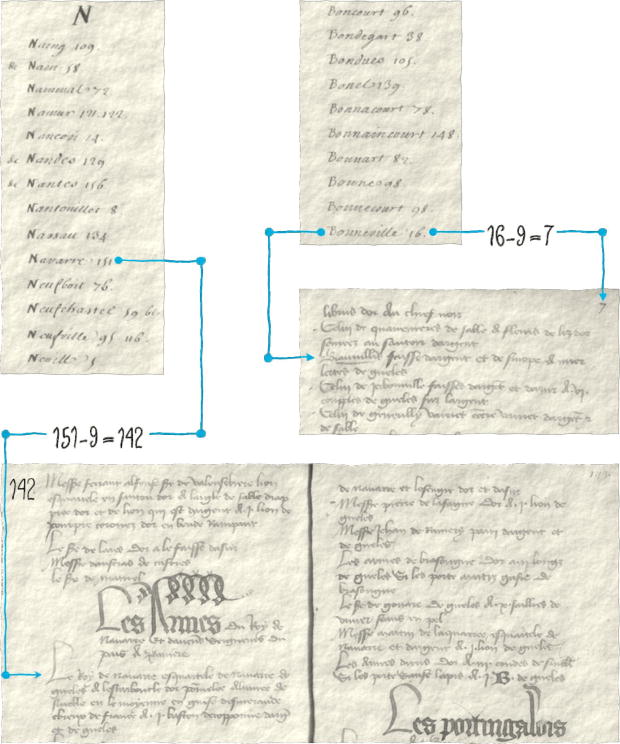
Urfé, unknown authors, «Urfe's Armorial», is currently in National Library of France (BnF, Bibliothèque nationale de France), in Paris, «Cabinet des titres» 927 as indicated on page I, cataloged with the code ms. fr. 32753, it is estimated from the XV century.
This armorial is written in French, on parchment measuring 19.5 x 14 centimeters, its compilation is believed to have been done in the 15th century, it presents 2,855 blazons in written form, but without illustrations, its blazons are organized into 54 sections, with an average of 17 blazons per page, the densest pages with about 20 blazons of 1, 2, or 3 lines per blazon, although some are longer. This Urfé armorial has served as a source for later armorials.
This manuscript contains a preliminary index, written later, of 61 pages, foliated the odd pages in consecutive Roman numerals from folio I to folio XXX. That is, 30 folios of 2 pages plus a final page, totaling 30 x 2 + 1 = 61 pages. This preliminary index consists of a name and a page number where the «theoretically», as will be explained below, corresponding blazon appears.
Next comes the true body of the Urfé armorial, of 162 pages, foliated only the odd pages, dated later than the compilation of the manuscript, in Arabic numerals, 2 by 2, from folio 1 to 161. That is, 1, 3, 5, 7, ..., 159, 161, and the last existing unnumbered page, as it is the 162nd which is even. I say that the 162nd is the last existing page because the National Library of France classifies it as an incomplete manuscript at the end.
It is a bit difficult to understand the relationship between the numbers that appear in the preliminary index, accompanying the names, and the numbering of the pages of the Urfé armorial. For example:
- Bouneville, which in the index appears with the number 16, is blazoned on page 7 (16 - 9 = 7).
- Navarre, for Navarra, in the index appears with the number 151, while the blazon of "Le Roy de Navarre" appears on page 142 (151 - 9 = 142).
This rule of subtracting 9, which has worked for me, but may not be of general use as, for example, Castille~Castile, on page VIII of the index, refers to page 140 of the content and it is there where it is actually found.
The Urfé armorial is in the public domain and the National Library of France, since February 23, 2012, has it published online with identification key ark:/12148/btv1b9063217v.
In this online version, as of today and until corrected, I believe that after page XIX, XVIII and XIX are repeated, just as folio 5 is repeated twice.
Bibliographical reference of century XV.
Classification: Armorial roll, Manuscript, In black and white and French language.
Author: unknown.
Bibliographical reference mentioned in the following article:
External resources:
- Urfe in Gallica BnF.
- Bouneville indexed in the page 16.
- although it is really on the page 7 (16-9=7).
- Navarra indexed in the page 151.
- although it is really on the page 142 (151-9=142).
- Castilla indexed in the page 140.
- is effectively, in this case, on the same page 140.


![Ver [Vincent, MS; 1285] en referencias bibliográficas. Libro abierto, hojas de plata, filo de oro, guardas de gules, tapas de sable.](../css/Libro.Bibliografia.png)
Vincent, MS; 1285
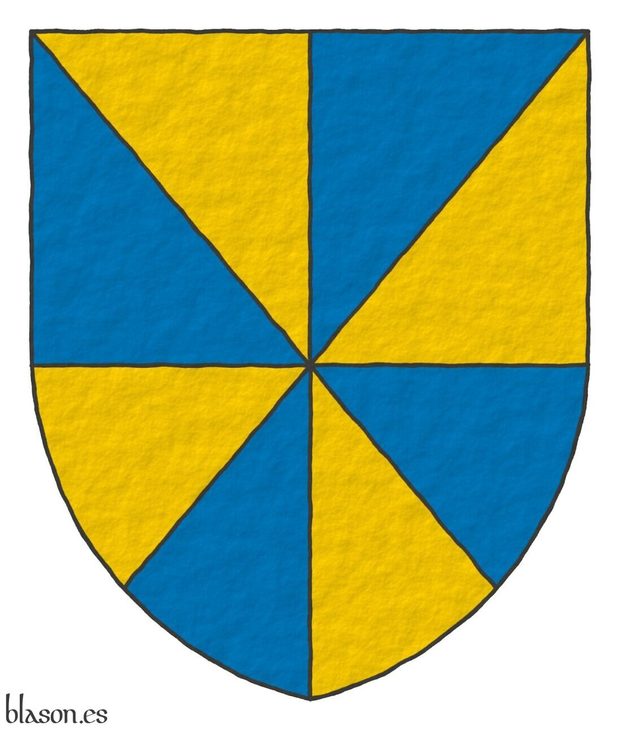
Vincent Manuscript, in English, usually written as «MS Vincent, 164 ff.1-21b», also called [St. George's Roll; 1285], it is in the College of Arms, London, containing 677 painted coats of arms, it is an English roll of arms dating from c. 1285.
Bibliographical reference of century XIII.
Classification: Armorial roll, Manuscript and In color.
The author is anonymous.
The following articles cite this bibliographic reference:
- Adam de Cretingges
- Bartholomew de Yattendon
- Edmund de Bassingburnn
- Howel ap Res
- James de Sottone, le Fitz
- Joan de Okinton
- John de Beauchamp
- John de Ladbrooke
- John le Sturmy
- Nicholas Malmains
- Norman Darcy
- Ricardo de Mandeville
- Robert de Malet
- Simon de Crombe
- Simon de Ver
- Simon le FizSimon
- St. George's Roll; 1285
- Thomas Roscelyn
- Thomas de Werblintone
- Thomas le FizThomas
- William Bardolf
- William de Ferrers, Earl of Derby
- William de Hondeshacre


![Ver [Winkler, P. P. von; 1892] en referencias bibliográficas. Libro abierto, hojas de plata, filo de oro, guardas de gules, tapas de sable.](../css/Libro.Bibliografia.png)
Winkler, P. P. von; 1892
Pavel Pavlovich von Winkler, «Russian Heraldry: History and Description of Russian Coats of Arms with Illustrations of All the Coats of Arms of the Nobility, included in the General Armorial of the Russian Empire», printed by Typography and Lithography of I. A. Efron, Prachechny Passage, Building 6, 3 volumes, Volume 1, year 1892, 59 pages, 275 illustrations, includes a preface to the first volume, an index, basics of heraldry, and an armorial, Volume 2, year 1894, 71 pages, 302 illustrations, includes a preface to the second volume, an index, and an armorial, Volume 3, year 1894, 71 pages, 326 illustrations, includes a preface to the third volume, an index, and an armorial, St. Petersburg, 1892, 1894.
Description
This work by Pavel Pavlovich von Winkler is a comprehensive three-volume series on Russian heraldry, exploring the history and detailed descriptions of Russian coats of arms.
The first volume includes an introduction to heraldry, making it accessible to readers new to the subject. Each volume expands on specific aspects of Russian heraldry, providing an analysis and cataloging of various coats of arms throughout Russia's history.
Bibliographical reference of century XIX.
Classification: Armorial roll, Russian language and In black and white.
Author: Winkler, Pavel Pavlovich von.
Internal resources: WinklerPvon1892.Tomo.01 Pdf format, WinklerPvon1894.Tomo.02 Pdf format and WinklerPvon1894.Tomo.03 Pdf format.
-
Language
-
Categories of heraldry
-
Divisions of the field
- Without divisions
- Party per pale
- Party per fess
- Party per bend
- Party per bend sinister
- Tierce
- Tierce sinister
- Tierced per pale
- Tierced per fess
- Tierced per bend
- Tierced pallwise inverted
- Quarterly
- Quarterly per saltire
- Gyronny
- Party per fess, the chief per pale
- Party per pale, the sinister per fess
- Party per fess, the base per pale
- Party per pale, the dexter per fess
- Chapé
- Chaussé
- Embrassé
- Contre-embrassé
- Party per chevron
- Enté
- Enté en point
- Flanched
-
Metals
-
Colours
-
Furs
-
Other tinctures
-
Ordinaries and sub-ordinaries
-
Diminutives of the ordinaries
-
Geometric charges
-
Composite ordinaries
-
Inanimate charges from Nature
Atom, Crescent, Diamond, Emerald, Estoile, Increscent, Lightning flash, Moon, Mount, Mullet, Mullet of four points, Orbital, Plough of Ursa Major, Rainbow, Ray of the sun, River, Sea, Snowflake, Sun, Sun in splendour, Sun of May, Trimount, Water and Wave.
-
Vegetal charges from Nature
Acorn, Apple, Apple tree, Ash, Bluebonnet, Camellia, Chrysanthemum, Cinquefoil, Cornflower, Dogwood flower, Double rose, Elm, Fleur de lis, Flower, Gourd, Holm oak, Hop cone, Kapok tree, Laurel, Lily, Linden, Lotus flower, Madonna lily, Mexican cedar tree, Oak, Olive tree, Palm tree, Plantain plant, Pomegranate, Poplar leaf, Rose, Shamrock, Sunflower, Thistle, Tree, Tulip, Vine and Wheat.
-
Animal charges from Nature
Badger, Bald eagle, Barbel, Barn owl, Bear, Beaver, Beetle, Bighorn sheep, Blackbird, Boar, Brach hound, Bull, Doe, Dog, Dolphin, Dove, Eagle, Elephant, Falcon, Female figure, Fish, Flame, Fly, Fox, Frog, Goat, Goldfinch, Goose, Heron, Horse, Hummingbird, Jaguar, Lark, Leopard, Lion, Lion passant, Lion rampant guardant, Lioness, Lynx, Male figure, Martlet, Merino ram, Owl, Panther, Parrot, Peacock, Pelican, Pelican in her piety, Puffin, Quetzal, Raven, Roe deer, Rooster, Savage, Seagull, Serpent, She-wolf, Stag, Starling, Talbot, Tyger, Vulture, Warren hound and Wolf.
-
Parts of natural charges
Arm, Beak, Branch, Caboshed, Chest, Claw, Covert, Dorsal fin, Eagle claw, Ermine spot, Escallop, Feather, Foot (palmiped), Foreleg, Forepaw, Hand, Head, Heart, Hoof, Leaf, Neck, Ostrich feather, Palm frond, Paw, Roe deers' attires, Shoulder, Sprig, Stags' attires, Stem, Swallow-tail, Tail, Tail addorsed, Tail fin, Talon, Tooth, Trunk, Trunk (elephant), Two hands clasped, Two wings in vol, Udder, Wheat spike, Wing and Wrist.
-
Artificial charges
Ace of spades, Anchor, Anvil, Arch, Arm vambraced, Armillary sphere, Arrow, Axe, Bell, Bell tower, Beret, Bonfire, Book, Bookmark, Bow, Branding iron, Bridge, Broken, Buckle, Cannon, Cannon dismounted, Cannon port, Canopy roof, Carbuncle, Castle, Celtic Trinity knot, Chain, Chess rooks, Church, Clarion, Clay pot, Closed book, Club, Column, Comb, Compass rose, Conductor's baton, Cord, Covered cup, Crozier, Crucible, Cuffed, Cup, Cyclamor, Dagger, Double vajra, Drum, Ecclesiastical cap, Fanon, Federschwert, Fleam, Four crescents joined millsailwise, Galician granary, Garb, Gauntlet, Geometric solid, Grenade, Halberd, Hammer, Harp, Host, Hourglass, Key, Key ward, Knight, Knot, Lantern, Letter, Line, Loincloth, Menorah, Millrind, Millstone, Millwheel, Monstrance, Mortar, Mullet of six points pierced, Nail, Non-classic artifact, Norman ship, Number, Oar, Oil lamp, Open book, Page, Pair of scales, Parchment, Pestle, Piano, Pilgrim's staff, Plough share, Polish winged hussar, Port, Portcullis, Potent, Quill, Ribbon, Rosette of acanthus leaves, Sabre, Sackbut, Sail, Scroll, Scythe, Sheaf of tobacco, Ship, Skirt, Spear, Spear's head, Stairway, Star of David, Step, Sword, Symbol, Tetrahedron, Torch, Tower, Trident, Trumpet, Turret, Two-handed sword, Wagon-wheel, Water-bouget, Wheel, Winnowing fan and With a turret.
-
Immaterial charges
Angel, Archangel, Basilisk, Dragon, Dragon's head, Garuda, Golden fleece, Griffin, Heart enflamed, Justice, Mermaid, Our Lady of Mercy, Ouroboros, Paschal lamb, Pegasus, Phoenix, Sacred Heart of Jesus, Saint George, Sea-griffin, Trinity, Triton, Unicorn, Winged hand and Wyvern.
-
External elements
-
Heraldic creations
-
References
-
Formats
-
Keywords on this page
Between, Pointed, Ermine, Armorial roll, Azure, Bibliography, Boa, Five, Collar, Ogee, Crown, Crown of the Sovereign and Most Noble Order of the Pomegranate, Quarterly, Outlined in sable, Two, In black and white, Black and white with color plates, Black and white and color illustrations, In color, Coat of arms, Mullet, Personal, Grand collar, Pomegranate, Gules, Illuminated, Interpreted, German language, Castilian language, English language, Manuscript, Or, Leather, Argent, Without divisions, Rampant, Kingdom of England, Surrounded, Sable, Century XIII, Century XIX, Century XV, Century XVI, Century XVII, Century XX, Century XXI, Crest and mantling, Three and One.

